Gangs of Sherwood was provided by Nacon for review. Thank you!
The tale of Robin Hood and his merry men is a tale I grew up with, thanks to Disney and his mission to steal from the rich and give to the poor. Even so, there is something quite intriguing about seeing the classic story I grew up with re-imagined. And with Gangs of Sherwood, I can say that it is an enjoyable experience when playing with friends, but it definitely has some issues that do make it hard to choose this game over similar ones.
The core gameplay will have you choose one of four unique characters, the core Robin Hood team, and go through different stages to play through the story. As you progress, you will fight enemies using two different types of attacks with special abilities, get the money that will level up your team at checkpoints in stages, and explore stages. Each combat scenario has a letter grade that increases, similar to Devil May Cry's combat grading, and you can get more currency the better you do. The money can be used afterward to rank up, which will unlock new abilities and buy new skills and attacks to use in-game.
The core gameplay of Gangs of Sherwood itself is quite enjoyable, and each character is interesting, with different strategies involved in using them. For example, Robin Hood can create floating arrows you can shoot at an enemy all at once, which does massive damage, and Friar Tuck can charge all of his attacks to send projectile waves or shockwaves through the ground with flames erupting. The game itself looks phenomenal, too. The world and visuals are outstanding, and I love the new designs of the protagonists.
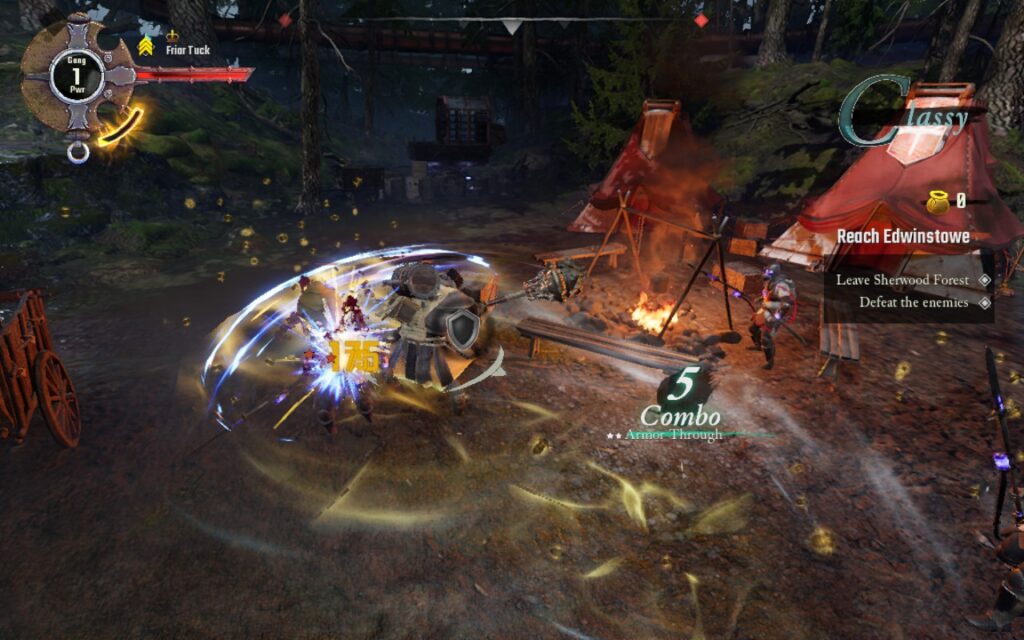
Ultimately, the game feels short, with only three acts and three missions in each of them for a total of 9 story missions. It can also feel very repetitive due to the enemies being re-used and the missions all having a similar structure. It is also quite boring to play alone, but I did enjoy playing alone when I did. And then we have a performance on the Steam Deck, which isn't the best.
Unfortunately, while Gangs of Sherwood can be fun, it won't be as enjoyable on the Steam Deck. It is a very heavy game to run, and it shows. On the lowest possible settings, the game runs between 26 - 30 FPS without any TDP limit. I did try setting a limit to see if maybe the game just drained more than it should, but unfortunately, any limit saw some decrease in performance.
I also noticed that some videos that show how certain skills are used don't play with the stable Proton version from Valve. Oddly enough, both Proton Experimental and Proton GE do fix the videos, but TDP caps at around 14W, not allowing the game to utilize the power it needs. And since the game needs as much power as it can get, we will need to stick with the stable proton branch.
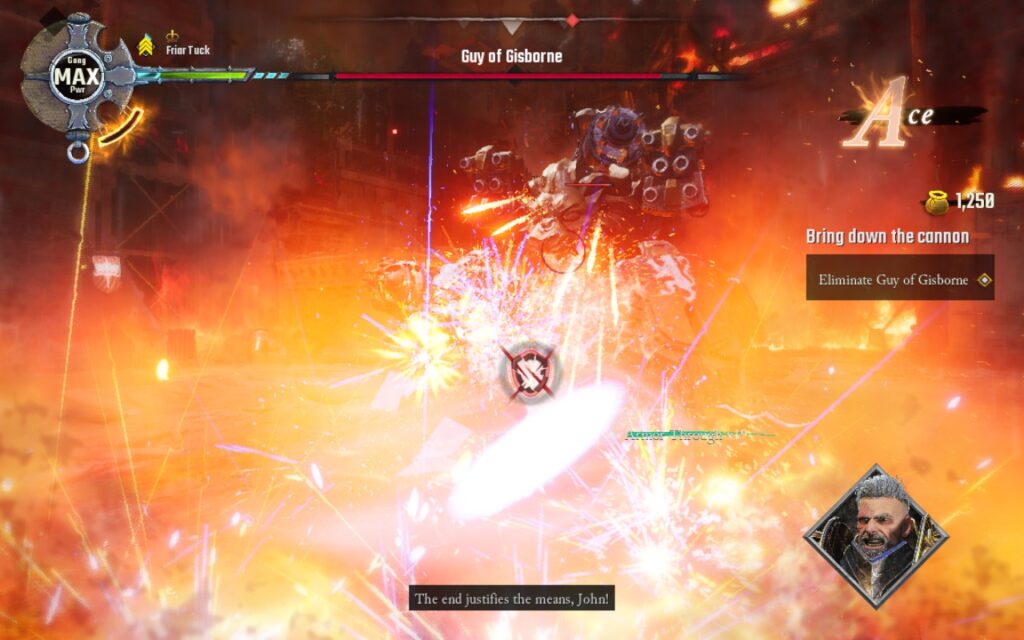
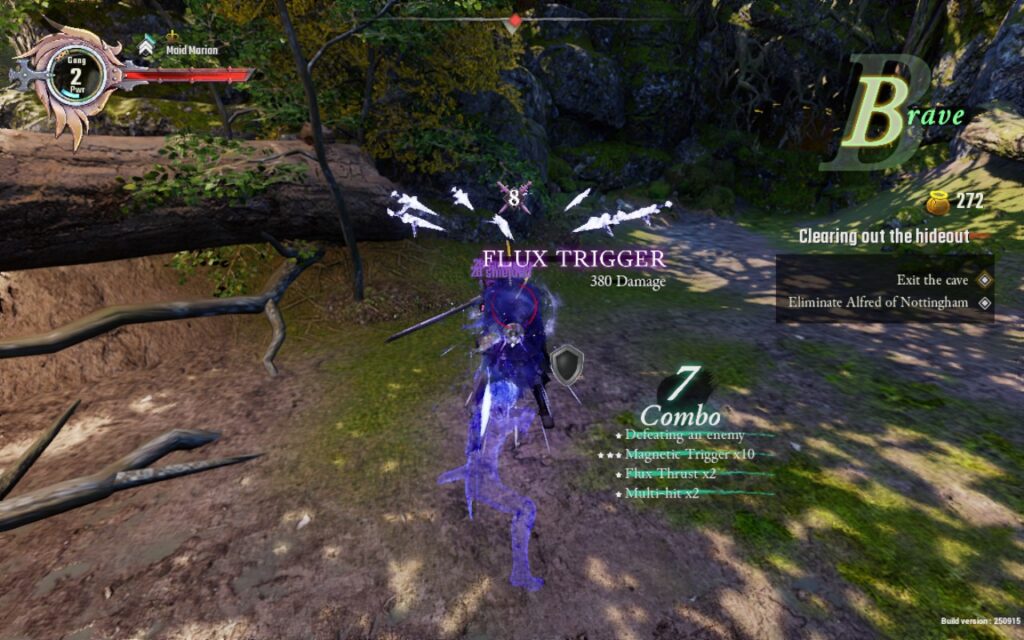
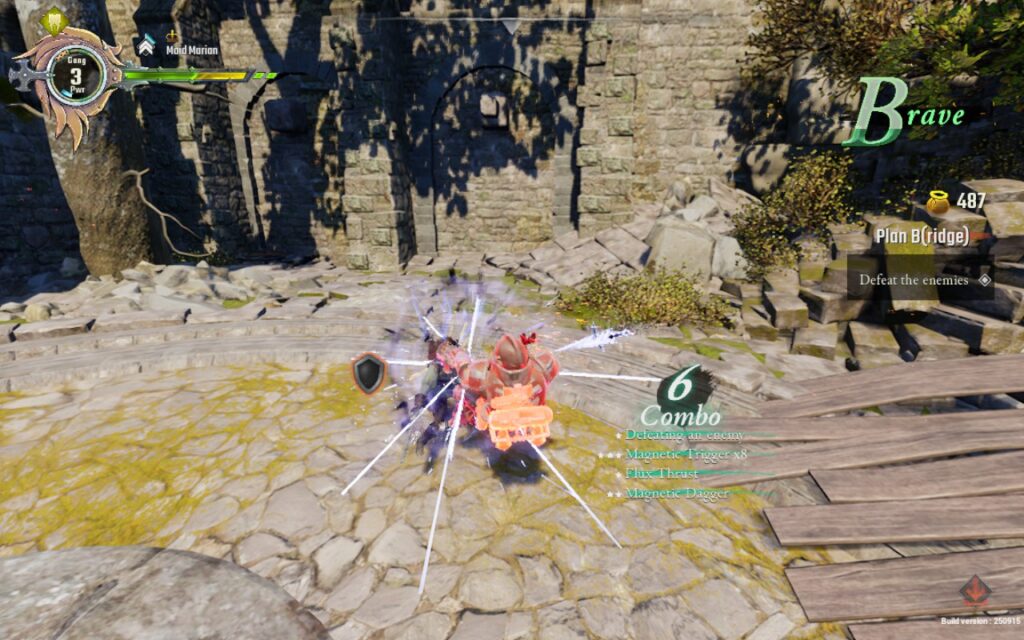
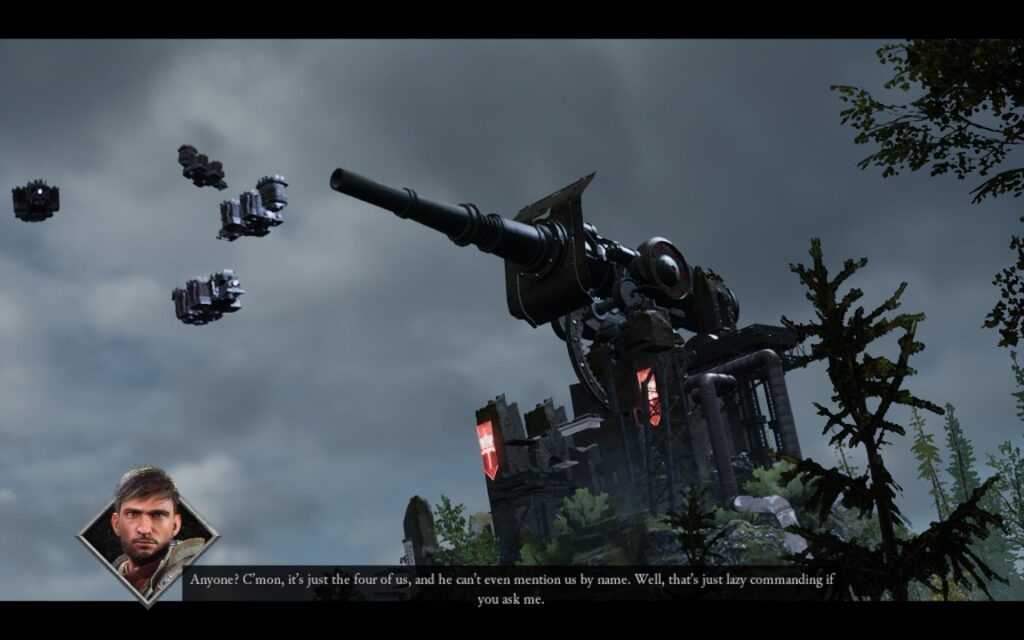
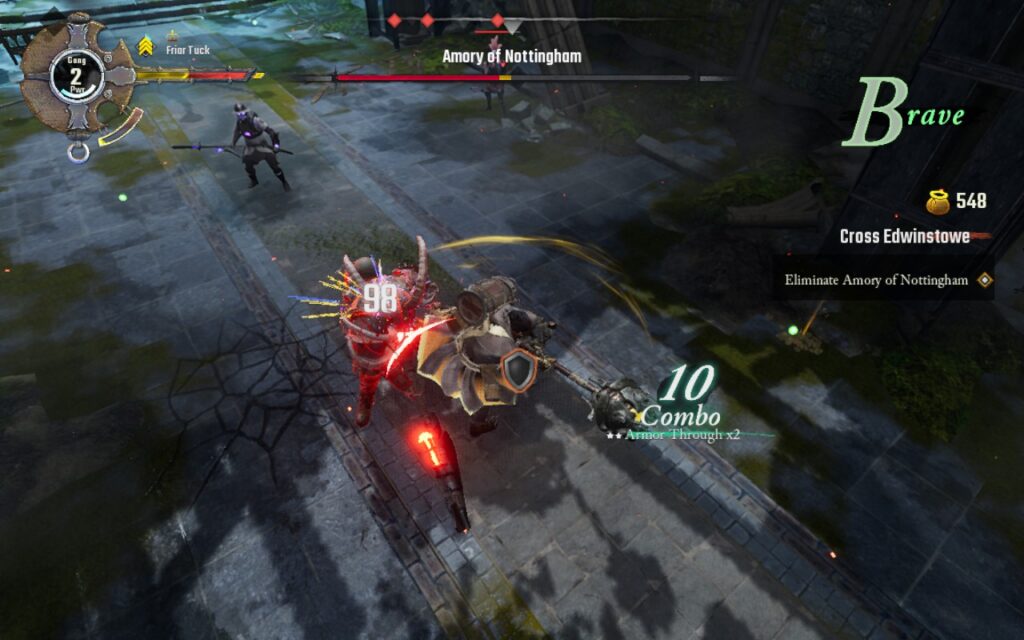
There's also a lack of accessibility features in Gangs of Sherwood. You can change language and audio settings, but that's about it. I would have loved to see UI scaling or text/subtitle enlargement, but it is still readable.
The game does support 16:10 resolutions when in-game, so there aren't any black bars, and it does have full controller support and cloud saves.
Gangs of Sherwood is a decent co-op action game that features some enjoyable combat and gorgeous visuals. Playing alone is possible and can be enjoyable, but it does have some issues with repetitive enemies and a short campaign, making me wish there was a bit more to enjoy. It is playable on the Steam Deck, but it will need the lowest settings and no TDP limit. It does dip to 26-28 FPS here and there, but I didn't notice the drops as much in the heat of the moment and still found myself enjoying the adventure.
Our review is based on the PC version of this game.
If you enjoyed this review, be sure to check out the rest of the content on SteamDeckHQ! We have a wide variety of game reviews and news that are sure to help your gaming experience. Whether you're looking for news, tips and tutorials, game settings and reviews, or just want to stay up-to-date on the latest trends, we've got your back.
After a long time of waiting, Overwatch 2 has finally arrived on Steam. So, what does this famous Free-To-Play Hero Shooter bring to the table?
There are over 30 characters or "heroes" to choose from, each with their own unique moves and playstyles, so you should be able to find one that fits how you like to play. Characters are split into 3 main classes: Tanks, Damage, and Support. My favorite is damage, but it's up to you how you want to play the game. This is a fast-paced and competitive first-person shooter, so having good reflexes and stable performance is essential. We're also treated to cross-play and cross-progression, so if you've been used to playing the game on consoles or over on Battle.net, you can carry on your progress on Steam.
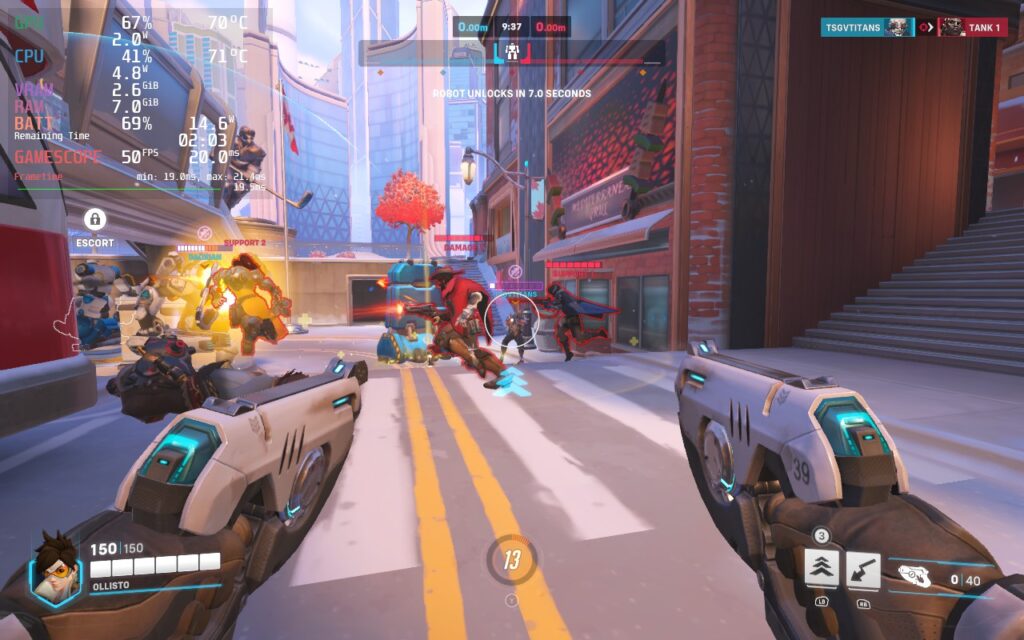
Given that Overwatch 2 is widely known as an eSports title, you'd imagine it's pretty optimized, right? Well, let's see how it performs on the Deck.
Things get off to a decent start. The default controller layout works well, and menus can be controlled with the D-Pad or Analog stick. There is native support for 16:10 resolutions, including the Steam Deck's native 1280x800, and text is also reasonably sized and perfectly readable on the Deck's display.
But how well does the game run? Ideally, we want a 60 FPS experience, and that's exactly what we can get with the Deck.
60 FPS is fairly easy to achieve on the Steam Deck. For this, we simply set the game to its "High" preset to get a good baseline. Then we change "Dynamic Render Scale" to Off, change "Render Scale" to Custom, and set it to 100%. Then set the Frame Rate to Custom, and set that to 60. In the Graphics Quality tab, we're also lowering AA to use FXAA and not SMAA. Here are the settings in screenshot form if you want to see them for yourself. You can click to enlarge the images.
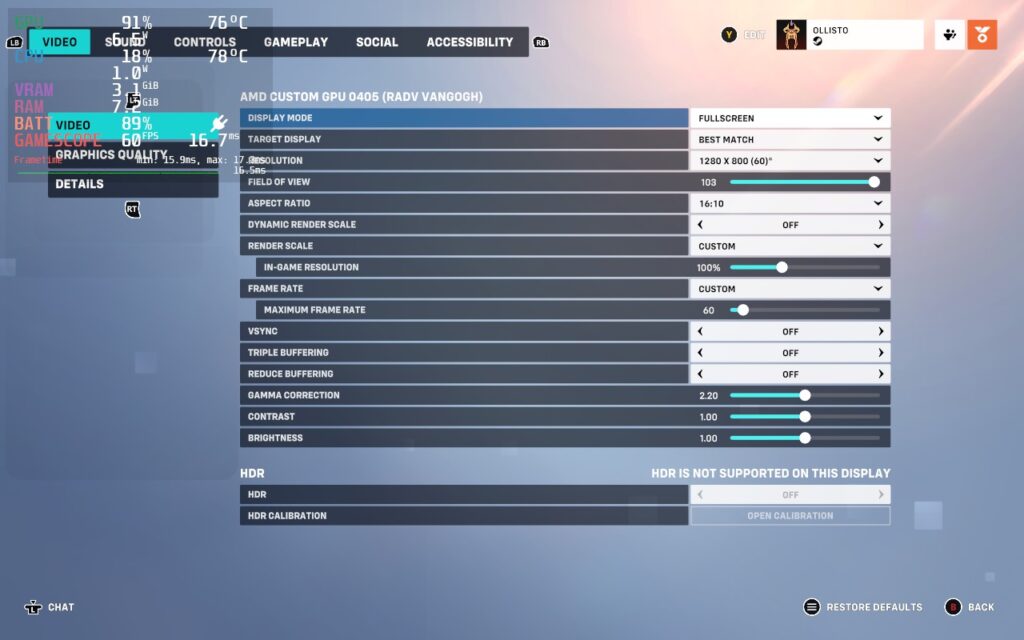
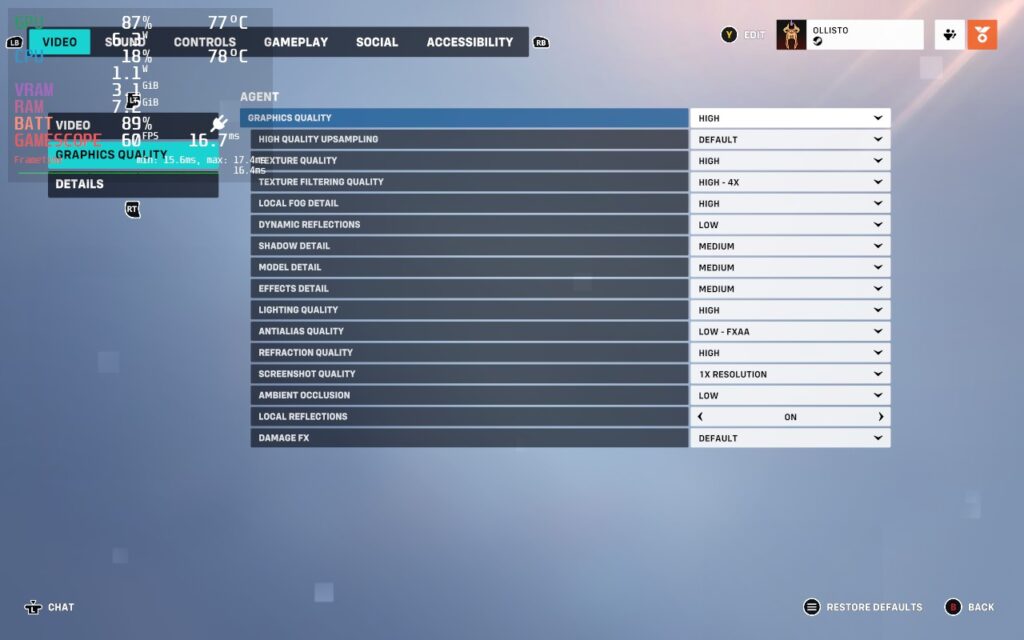
At these settings, I noticed basically no drops from 60 during 3 test matches. The downside, however, is that the battery life is very poor. You should expect no more than 90 minutes of battery life. The Deck can also feel pretty hot in your hands, reaching 90C often.
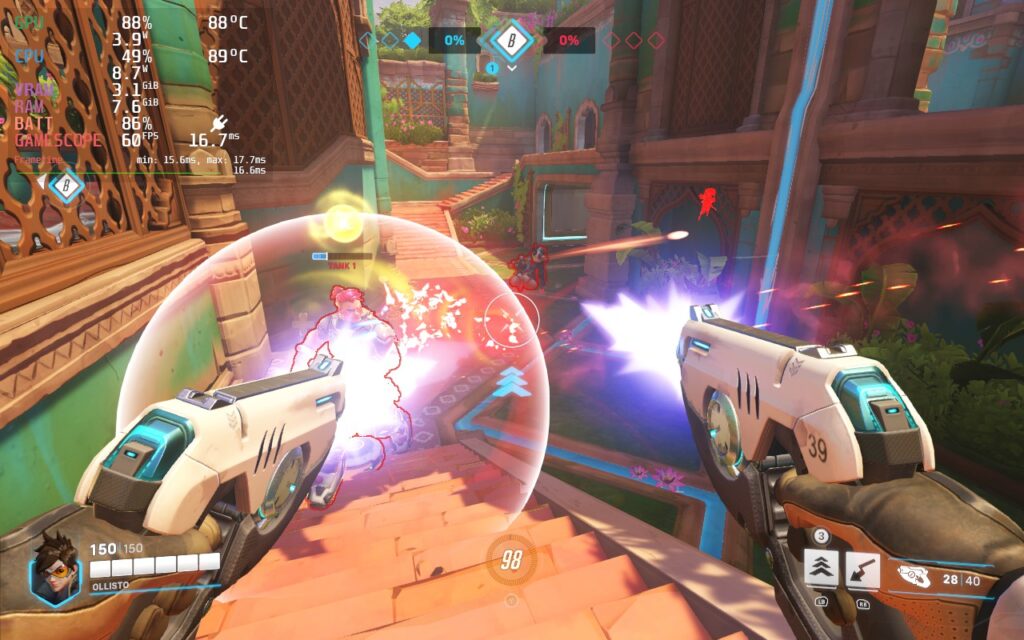
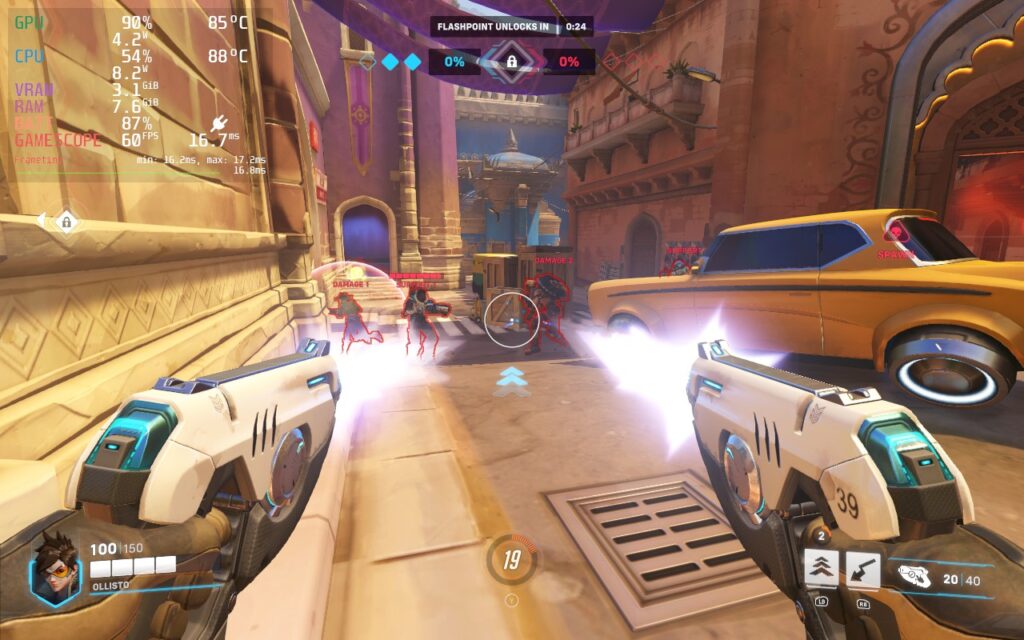
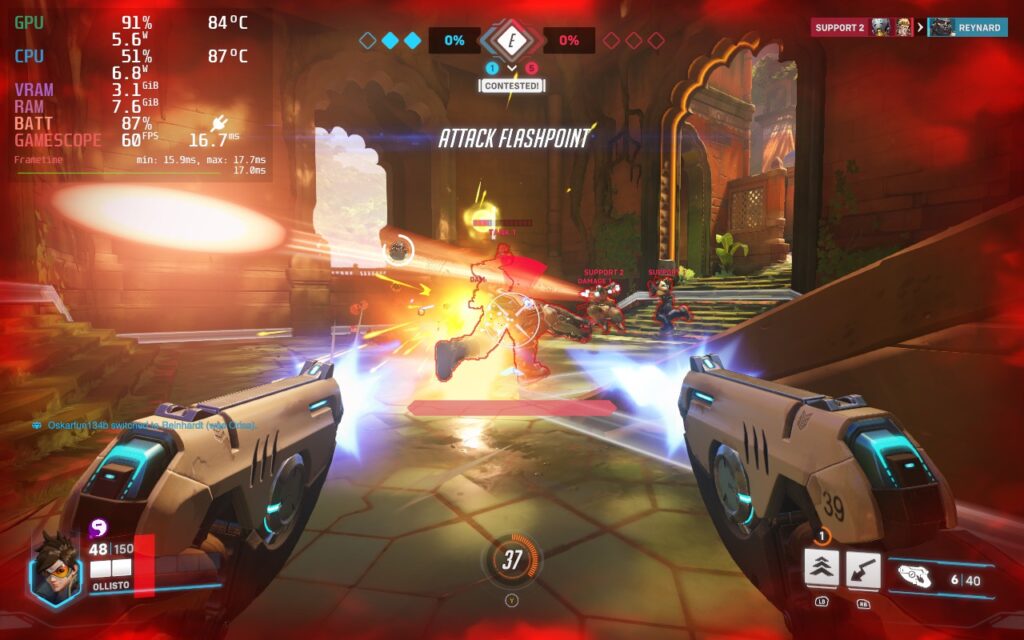
If you want settings that make the Steam Deck run slightly cooler, select the "Medium" preset, and then do the same as above: Dynamic Render Scale Off, Render Scale to Custom, 100%. Frame Rate to Custom, 60. FXAA is already used on the Medium preset, so we don't need to change this. The advantage of using Medium over High is that we can lower our TDP limit from 15W to 12W in the SteamOS settings. This buys us up to 30 minutes extra battery life, meaning you can possibly squeeze out 2 hours of gameplay. It also keeps the Deck cooler and more comfortable to hold, with temperatures usually holding around 80C and not 90C.
As this is a competitive game, we don't really want to drop the framerate too much. However, a drop to 50 FPS isn't too bad, and we can get some extra battery life out of the Steam Deck with these settings. In a similar fashion to the recommended build, select the "Low" preset, then set "Dynamic Render Scale" to Off, "Render Scale" to Custom, and set it to 100%. Then set the Frame Rate to Custom, and set that to 50. You'll also want to set your SteamOS Frame Rate lock and display to 50 FPS. Here are the settings again so you can copy them exactly. You can click to enlarge the images.
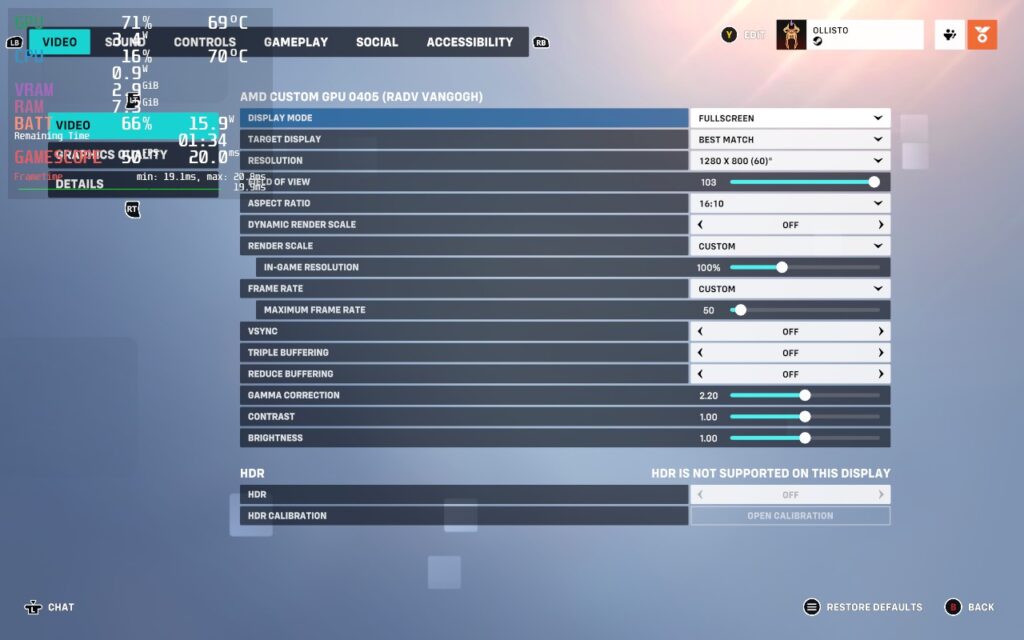
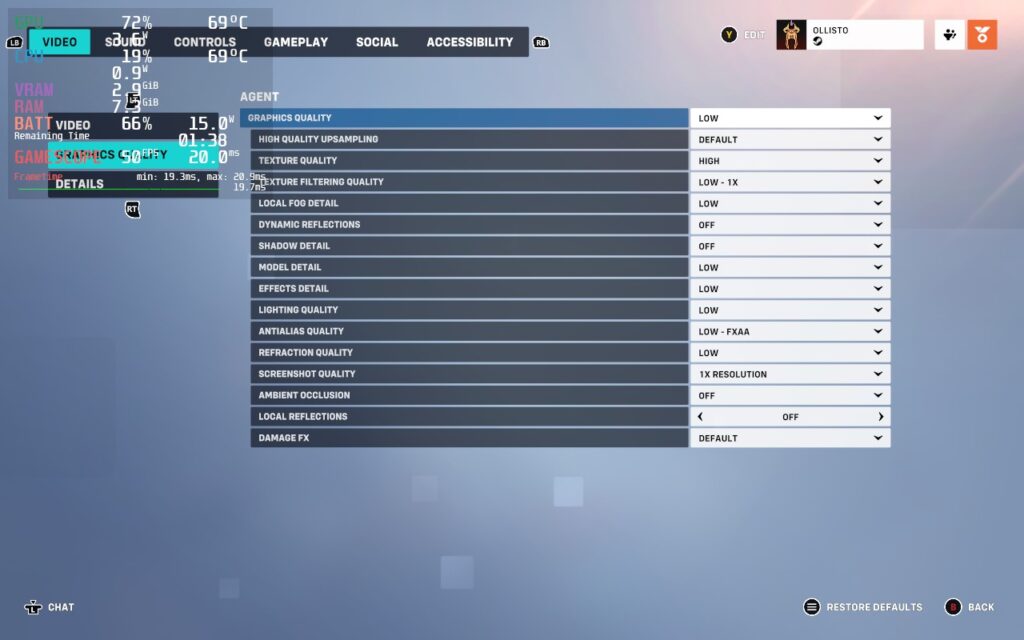
To get the extra life from our battery, we'll also be lowering our SteamOS TDP Limit to 9W. With these changes, the game may look a little worse, but we're increasing our battery life from about 90 minutes to almost 3 hours, close to doubling our battery life.
These aren't the absolute lowest graphics settings. We could lower the resolution or remove the FXAA. However, at this TDP, the Deck becomes CPU-limited rather than GPU-limited, so lowering our graphics wouldn't make the game smoother or improve battery life. Overwatch 2 seems to occasionally put a lot of stress onto a single CPU thread, so we still need a somewhat high TDP to keep the CPU happy.
Our framerate isn't quite as stable as it was with the 60 FPS build, but I struggled to notice it during gameplay. We're also a lot cooler here, running at about 70C instead of 90C.
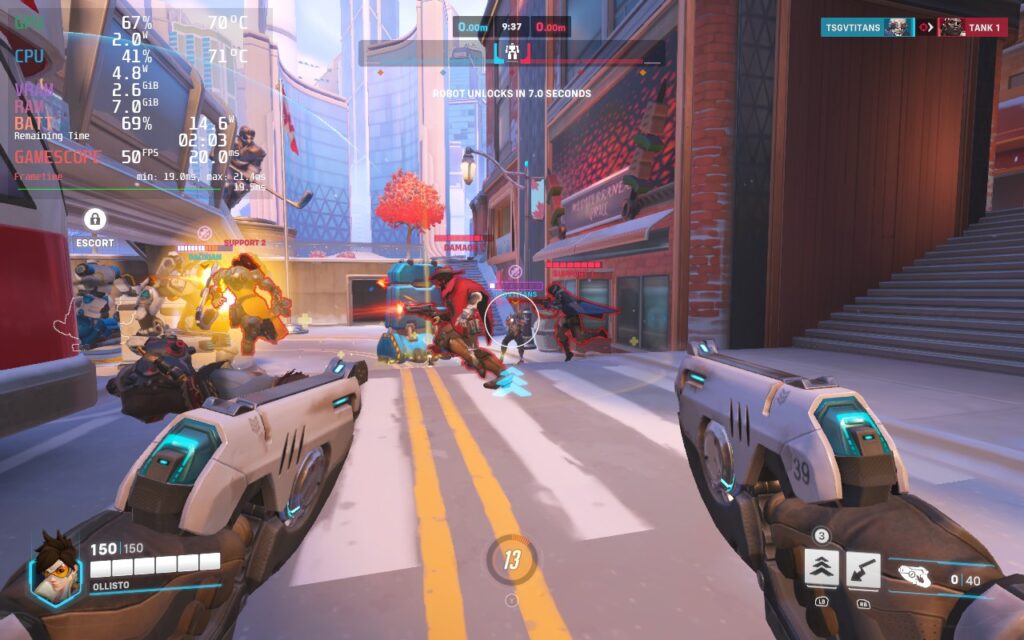
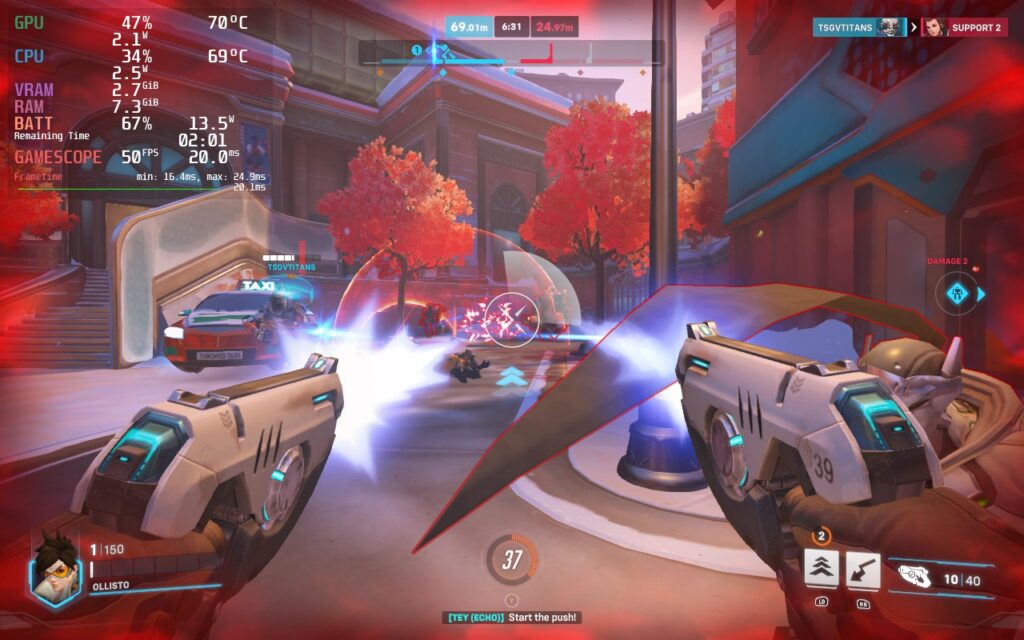
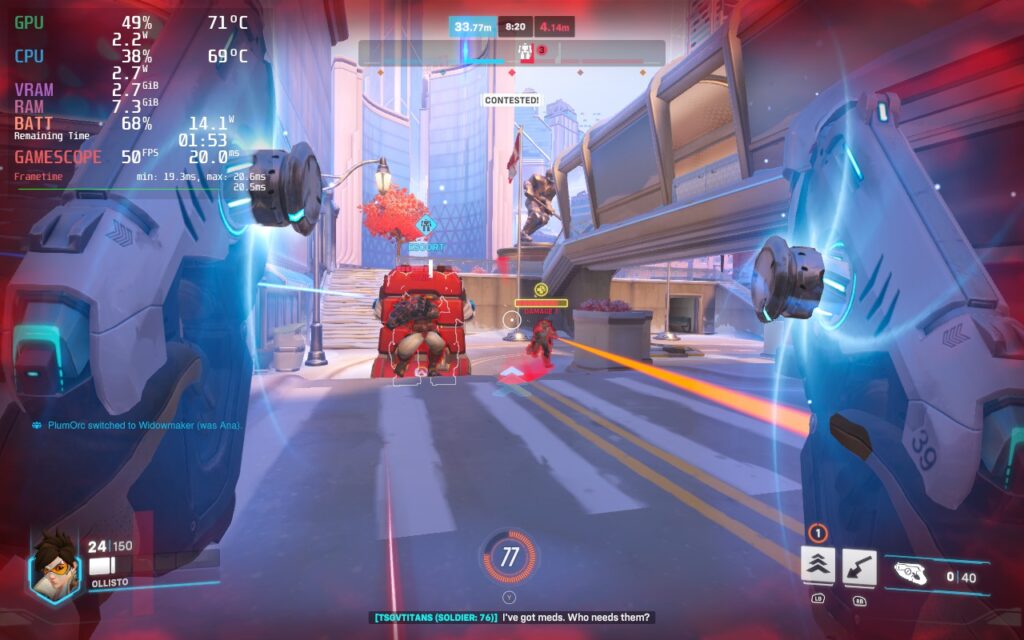
Overwatch 2 has some nice accessibility options; these include the ability to disable Camera and HUD Shaking, which can give players headaches. You can increase the size of the game's cursor and subtitles. There is also a customizable color blind filter and the ability for the game to read out text chat to you, as well as type into chat using your own voice.
Despite the "Overwhelmingly Negative" reviews that Overwatch 2 was subjected to upon its Steam launch, I think there's quite a bit of fun with the game, especially if you have friends who want to play. It's free, the base mechanics of the game are simple and fun, and it's well-optimized so that a variety of devices, including the Steam Deck, can run it at a competitive level. If you're after a team-based first-person shooter, you should give Overwatch 2 a try!
Our review is based on the PC version of this game.
If you enjoyed this review, check out the rest of the content on SteamDeckHQ! We have a wide variety of game reviews and news that are sure to help your gaming experience. Whether you're looking for news, tips and tutorials, game settings and reviews, or just want to stay up-to-date on the latest trends, we've got your back!
Armored Core 6 was provided by Bandai Namco for review. Thank you!
It has been ten long years since we last saw Armored Core, and I can't explain how good to play the third-person mech shooter again! Armored Core 6: Fires of Rubicon is a fantastic return to a franchise that has been dormant for too long. FromSoftware is known for creating the souls-like genre and, with the lessons they’ve learned creating Dark Souls and Elden Ring, they have mixed the customizability and multi-directional combat in and created something magical.
The highlight of the game is easily the combat and how you can change it through the way you outfit your mech suit. On the field, you will be able to fluidly move in all directions while automatically locking on to enemies and shooting with one of 4 weapons you equip. These can range from plasma rifles and swords to machine guns and bazookas. You can control all four weapons at the same time and you can buy new weapons and gear from the parts shop using money you get from missions. The combat is addicting and feels fantastic. And with explosions and attacks that are flashy, you create these cool-looking moments that keep you in the zone.
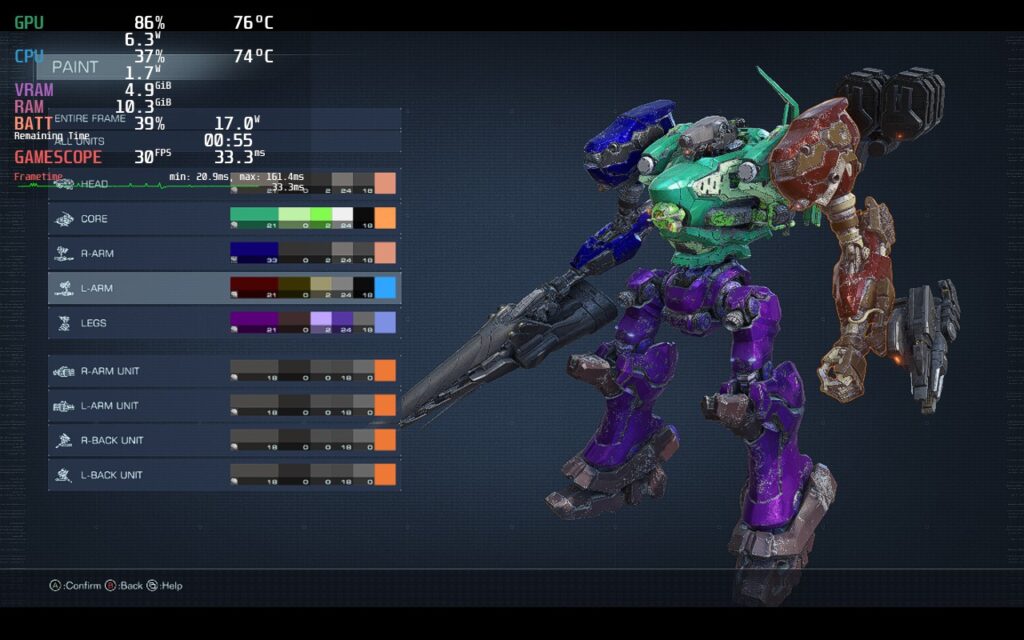
As for the story, it is primarily told through missions that are given in chapters. As you complete more missions, you unlock new ones and you can replay the older ones. Each mission either takes place in a different zone or has different objectives, but each feels really enjoyable to play with a story I felt engaged with as it progressed. You play as an unnamed merc who is fighting on the planet Rubicon, where different corporations and rebel groups are trying to secure the energy source called Coral.
Speaking of the missions, you can replay every single older mission and try to aim for a higher score or ranking. You can keep getting money from these replayed missions too, so if you gotta grind to get a specific weapon you want, you totally can. I found myself replaying missions to get money and buy specific weapons just to test out on bosses and see which builds work best on them.
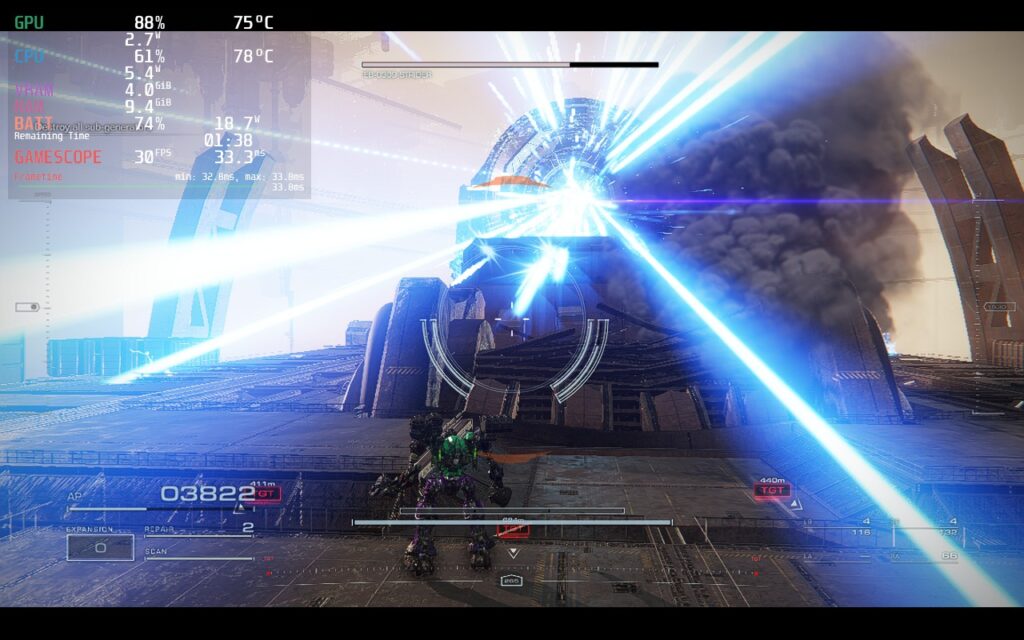
Armored Core 6 is at its best when you are flying through the air, shooting at enemies all around you, and playing around with different builds to see what weapons and armor combos work best for you. Thankfully, this is the bulk of the game. The game is streamlined to get you in missions fast with little-to-no bloat and it works wonderfully. And with the right settings, playing on the Steam Deck is a fantastic way to enjoy the fast-paced mech shooter.
Armored Core 6 on the Steam Deck is a bit of a wildcard at times, but it can be stabilized with some compromises. In some missions, and in closed areas, the game can run extremely well, hitting an almost solid 50 FPS. This is really awesome, but it doesn't hold throughout. In larger missions with open areas, the game will consistently drop down to the mid-30s, even on low settings. I went even further down and set the resolution at 800x450 with low settings and the large areas couldn't consistently break 40 FPS.
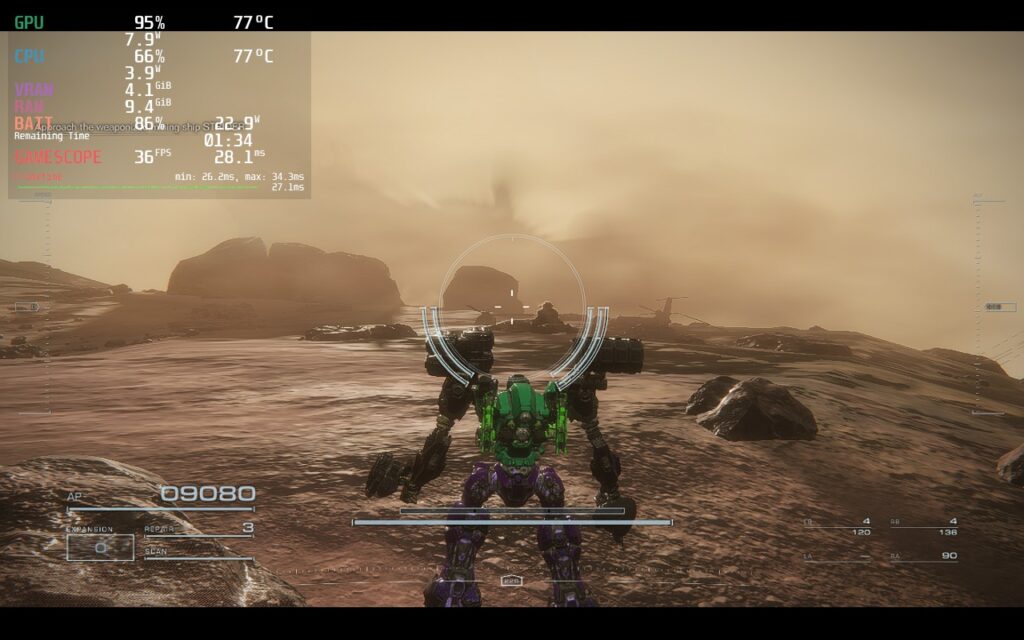
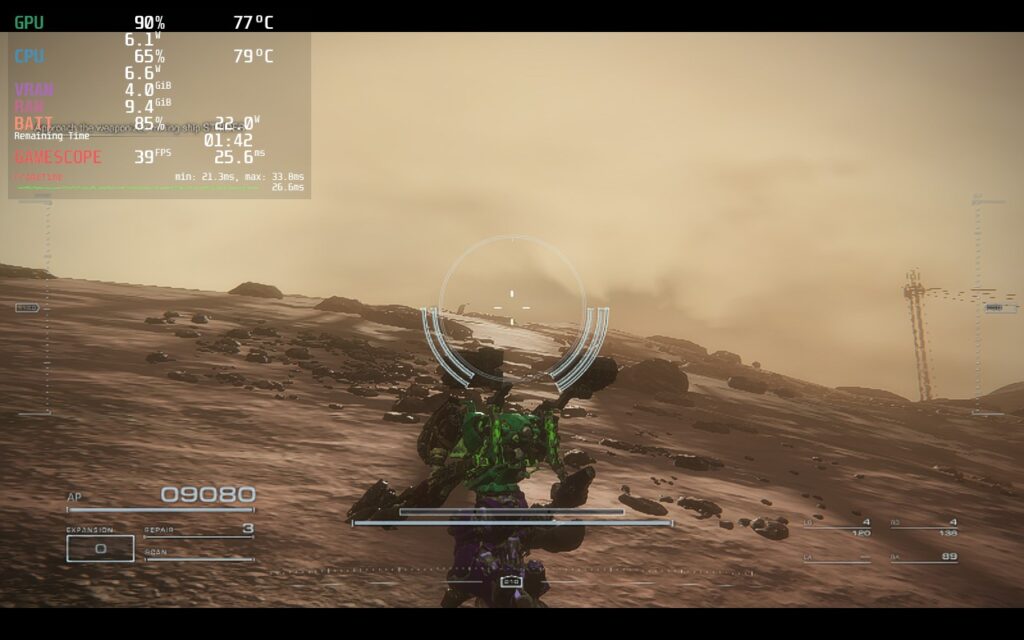
Due to this and the consistency of these missions, I elected to stick to a 30 FPS lock. For some missions, you will be able to set it at 45 or 50 FPS and be able to hit it, but for a solid experience throughout the game, 30 FPS is going to be your way to go.
With a mix of medium and low settings, 1152x648 resolution, and SteamOS FSR, we can get a near-solid experience that looks fantastic and plays well. There are a couple of drops here and there when there's too much going on near you, but these are far and few. I found that we can also set a TDP limit of 11 to make sure the battery drain doesn't drain too much.
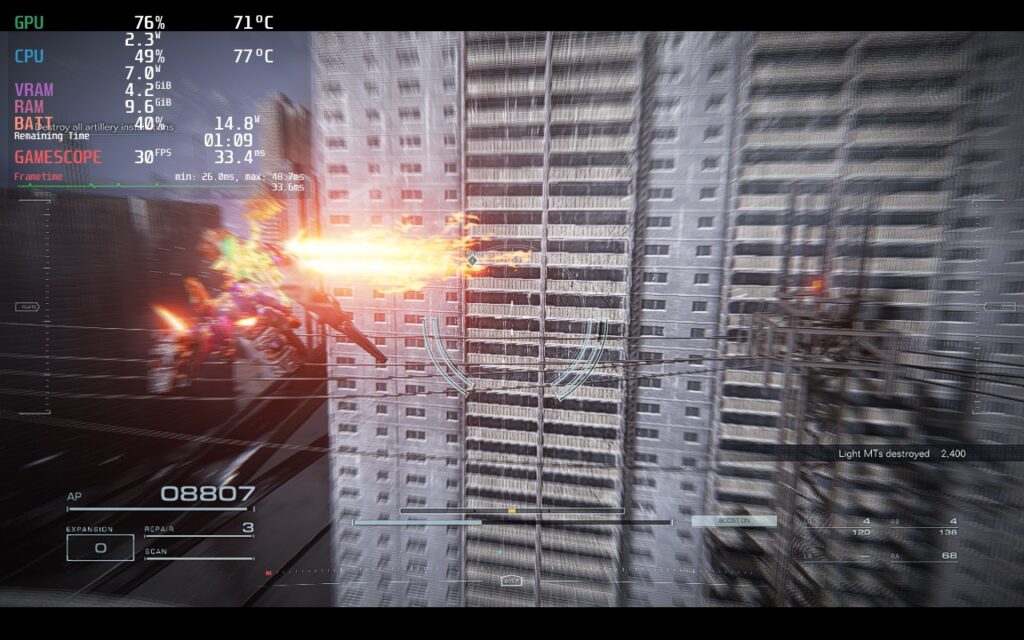
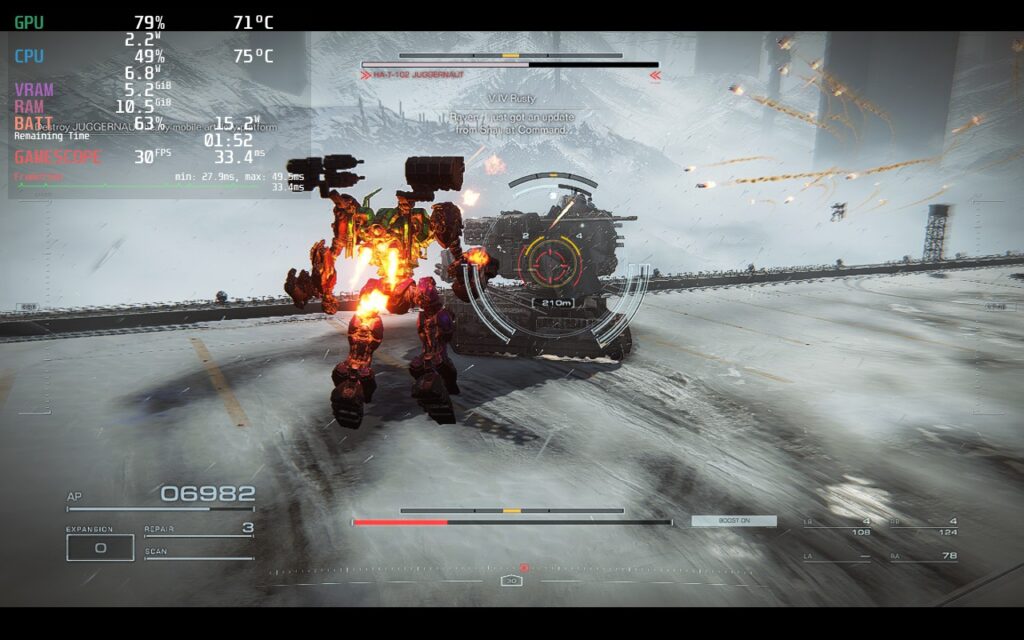
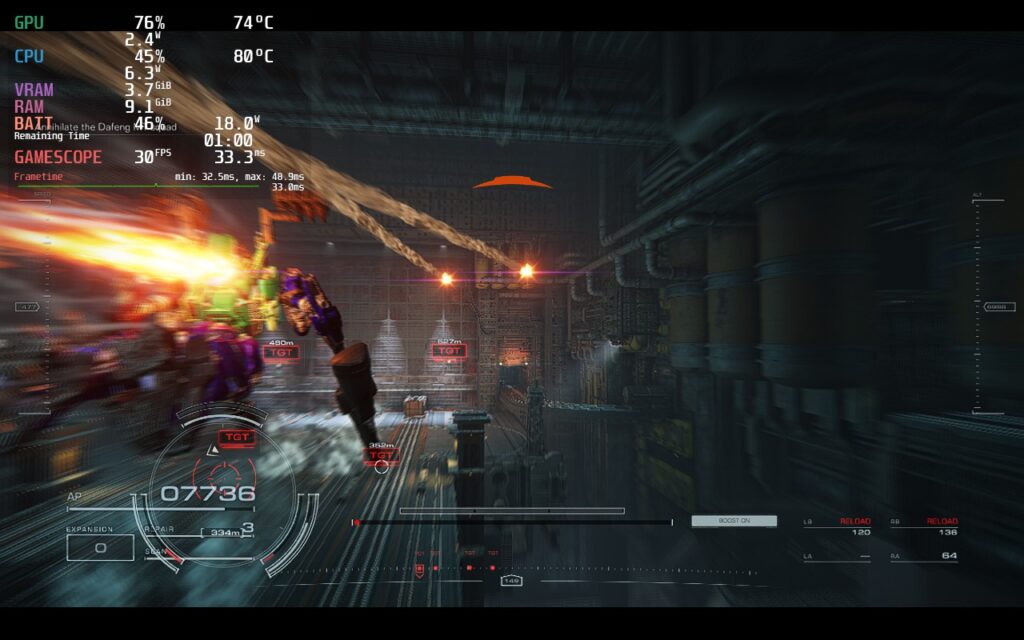
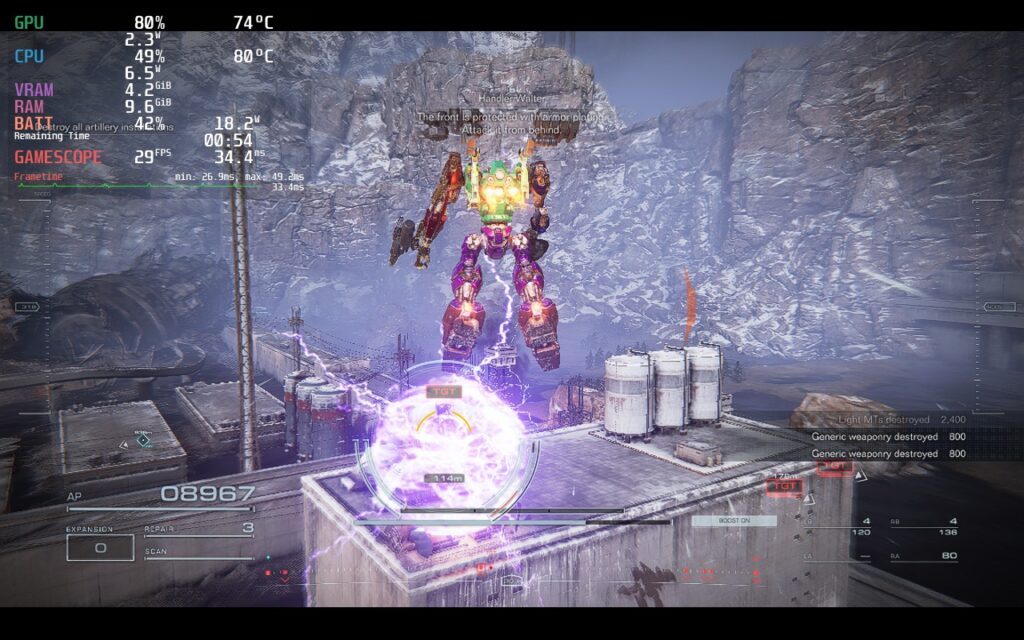
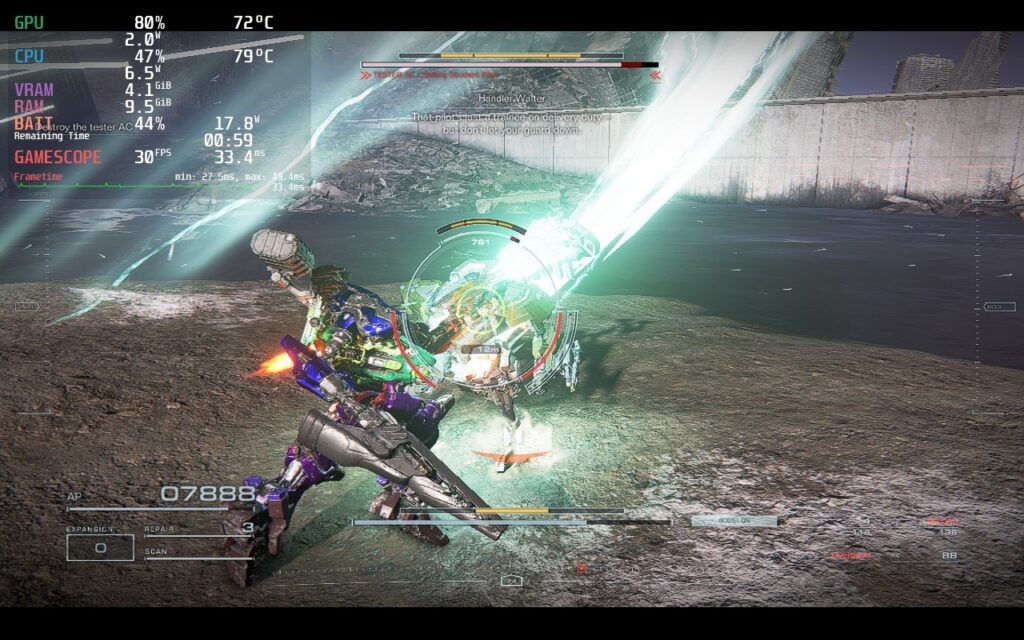
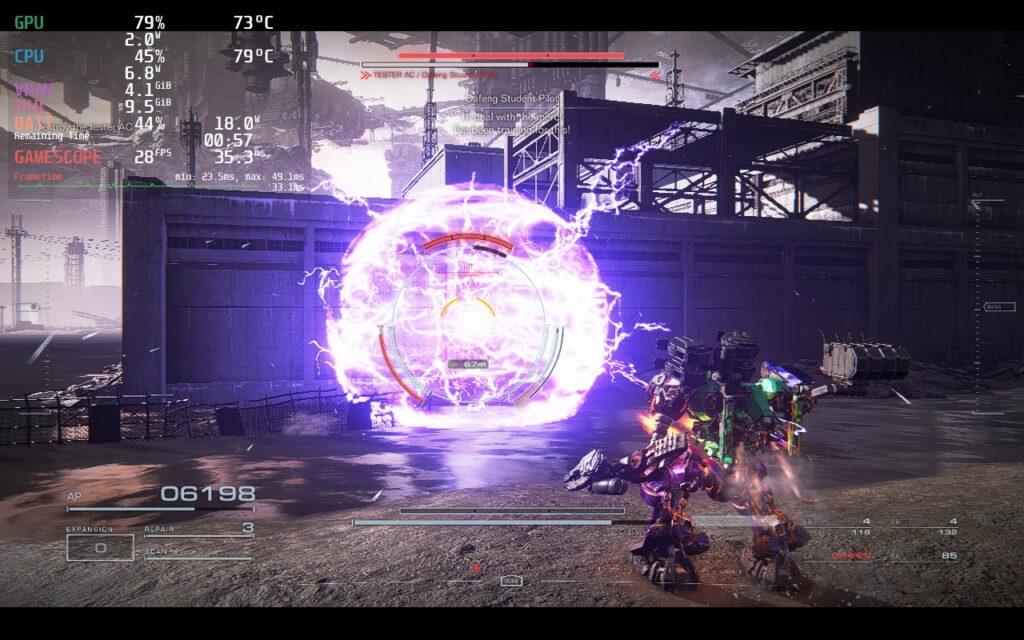
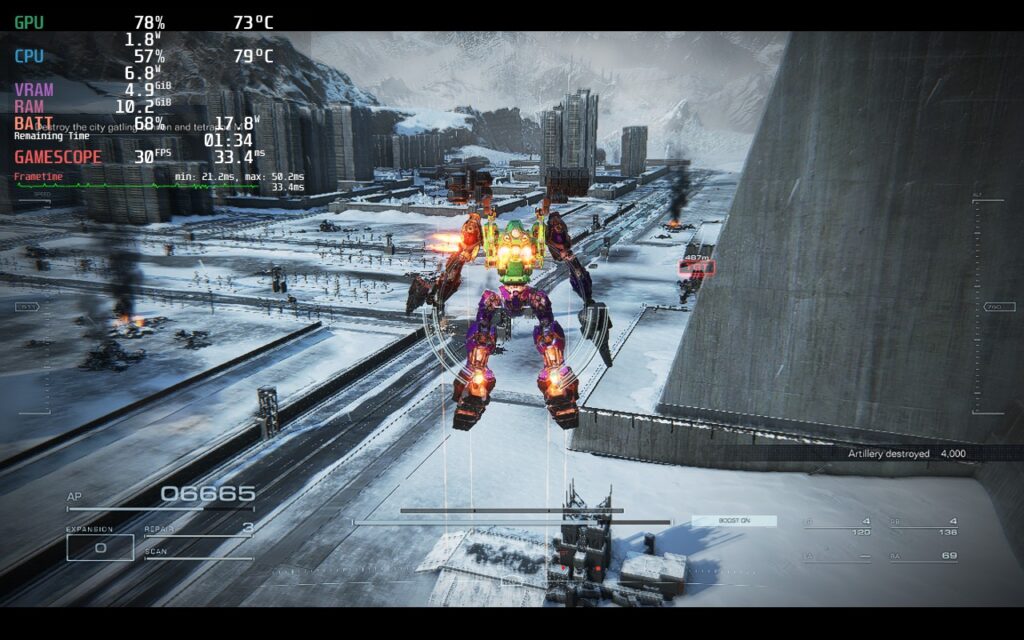
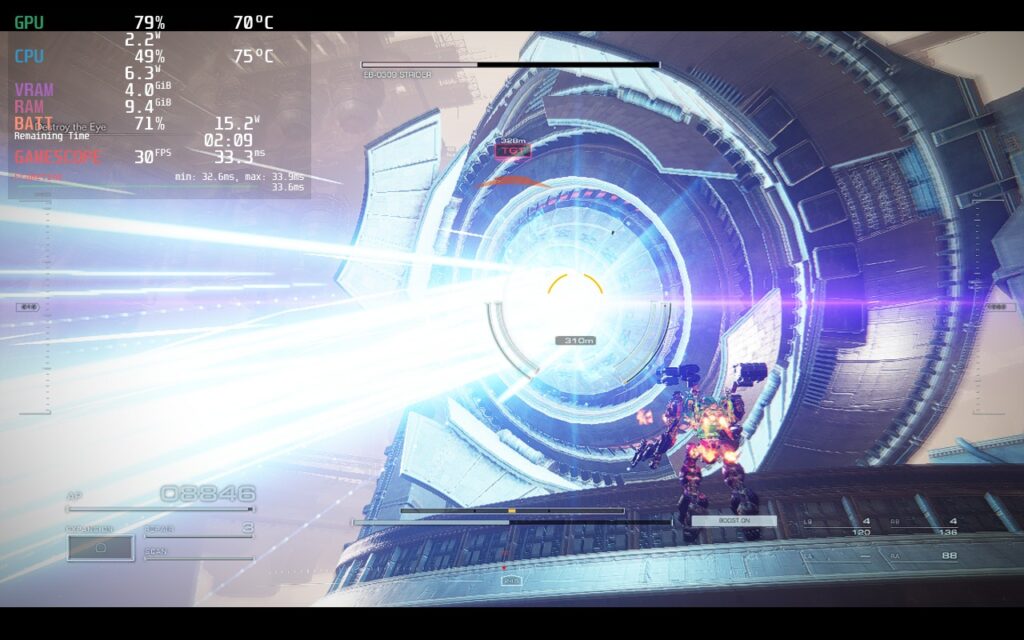
Since anything above 40 FPS isn't going to be stable throughout the game, I can't recommend a build that would include it. If you want to play at a higher framerate, I would just use this same build and remove the TDP limit. You will get a solid 40-50 in some missions, but others will drain it. I feel this build is a great balance between quality, solid framerate, and battery drain when taking into account how big of a game this is.
Armored Core 6 doesn't support 16:10 resolutions, but it does have full controller and cloud save support.
Armored Core 6: Fires of Rubicon is an incredible game that feels best when you have perfected your build and can see it in action through the combat. It’s epic to be able to fly around the battlefield in all directions while shooting and slashing the enemies. Pair it with the streamlined style to just get you in to the battles, as well as an awesome customization system, and you have a recipe for an addicting game well worth your time.
On the Steam Deck, there are some compromises that need to be made, as well as a 30 FPS lock, but even with these, the game feels and looks incredible. I was in the zone, destroying mechs, getting destroyed by bigger mechs, and customizing my suit without feeling much compromise. Overall, this is an amazing game to play on the Steam Deck and definitely worth your time.
If you enjoyed this review, check out the rest of the content on SteamDeckHQ! We have a wide variety of game reviews and news that are sure to help your gaming experience. Whether you're looking for news, tips and tutorials, game settings and reviews, or just want to stay up-to-date on the latest trends, we've got your back!
Atlas Fallen was provided by Focus Entertainment for review. Thank you!
Earlier this year, I had the incredible opportunity to go to PAX East and it was there that I played Atlas Fallen for the first time. I left feeling quite excited for the game, the action, world, and story intrigued me. There was a lot to look forward to and after talking to Deck13 and Focus Entertainment reps there, I left feeling confident that not only would this game be one to really enjoy, but also one that will be at least decently playable on the Steam Deck. Now that the game is almost here, and I had the chance to play through and review it, I have a bit more to say on the game.
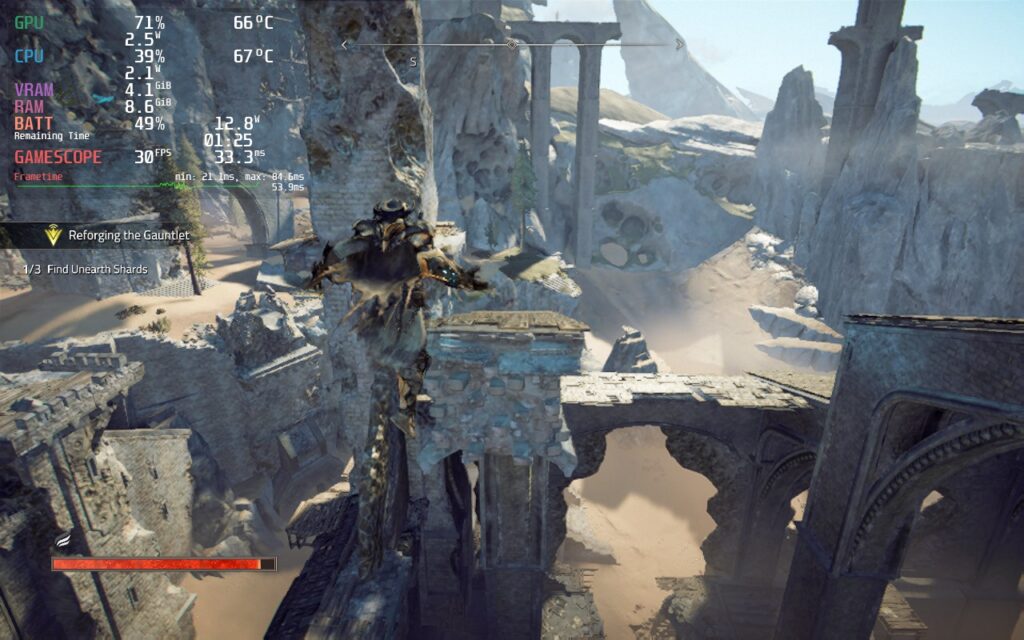
Atlas Fallen is a large-scale Action RPG where you will surf across the sands to face ancient dangers, hunt monsters, and become the ultimate champion. After playing through the game and being able to experience what it has to offer, I feel it did a great job creating an addicting and enjoyable adventure, even with a couple of hiccups.
The story of Atlas Fallen is passable. You are a random person that is able to wield a powerful gauntlet, infused with enough power to rival Thelos, the god-like antagonist of the game. The narrative is told through cutscenes, dialogue, and journal entries you find throughout traveling. While I didn't find the story to be anything ground-breaking, I did enjoy the journey. Traversing around the world is pretty fun as well and sand surfing is the real highlight of this. Finding slopes to surf down and accelerate to go as fast as possible is a ton of fun. Though at times, the world itself did seem a little bland and bare at times. Luckily, there are side quests and random chests to find, but it didn't do much to change the overall feeling of the world.
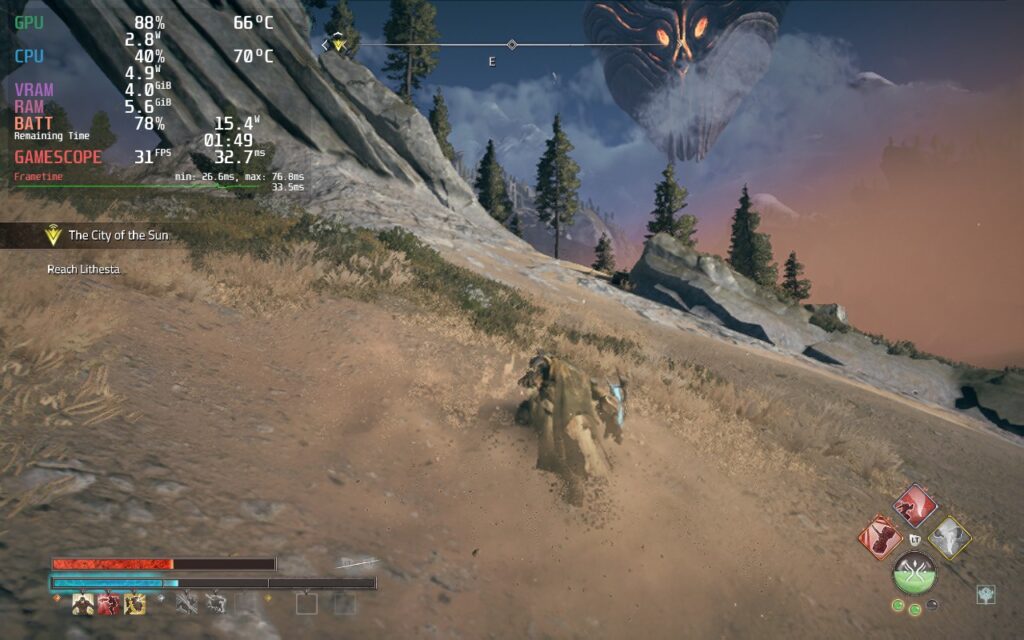
The combat is where things got really fun for me. While the fighting can feel a bit slow at times, wielding gigantic, shape-shifting weapons is a blast. I loved being able to swap between two different styles at once, with each having their own strengths and weaknesses, and watch them grow the more you fight with the Momentum Gauge, which fills up as you attack and land hits. As it fills up, you will be able to execute different special attacks and get passive bonuses, which you equip using Essence Stones. You can also execute a Shattering Strike, which drains the Momentum Gauge for an ultimate attack.
Deck13 found a nice balance of simple mechanics and deep customization here. The Essence Stones are great for fine-tuning your build, while a lot of the stats like attack power, defense, and your shatter power, are tied to your armor. Your armor can be upgraded, which gives you perk points to further passively make your character more powerful. I also really like the blocking mechanic included here. You can dodge enemy attacks, but if you block at just the right time, you can crystalize enemies and bosses, making them vulnerable to attacks for a little. Blocking doesn't interrupt the flow of your attacking either, so you can attack, block, and attack without the flow ever ceasing.
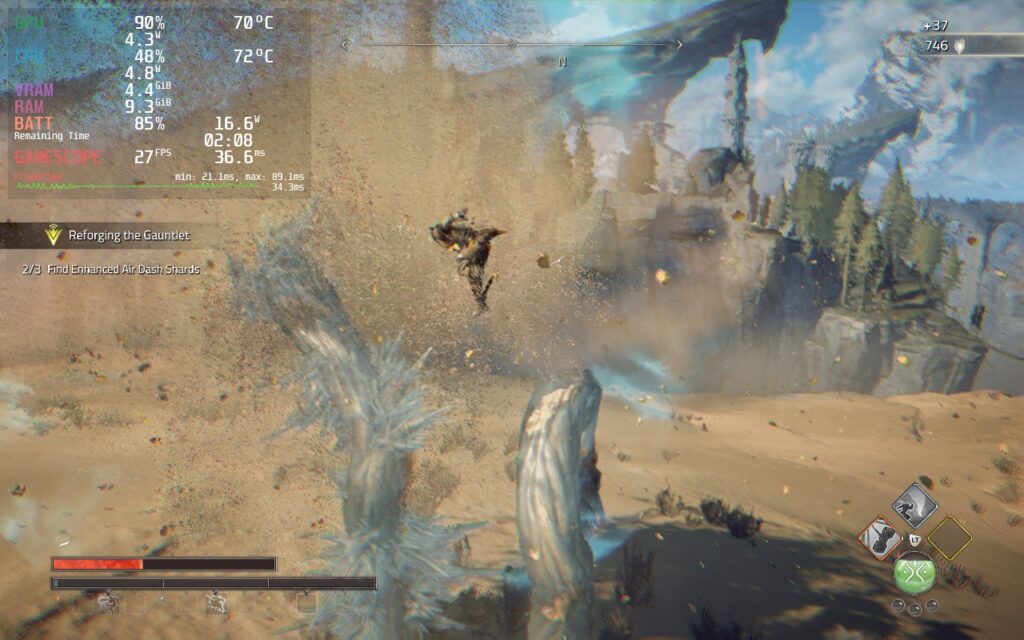
Even with the little nuisances here and there, and an ok story, I really enjoyed Atlas Fallen. It didn't break any molds or try to get too crazy, but it added some nice mechanics that gave it a nice balance between too simple and too complex. There's something addicting about gaining momentum and turning your axe into a gigantic axe that can just demolish multiple weakpoints of a big boss in one swing. I had a lot of fun playing, and while I didn't get to try it, I can only imagine playing the whole campaign in co-op will be even more fun! Though, if you're going to play on the Steam Deck, there will be some compromises that need to be made.
There are a couple things I found a bit odd when it comes to Atlas Fallen performing on the Steam Deck. First, the game settings have a couple of unique settings. For instance, there are separate window and resolution size options, as well as different intensity level sliders for post processing effects. The resolution size changes the game's rendering resolution, while the window resolution changes some of the text size (but not all). While the intensity sliders did change some of the visual effects you see, though for my enjoyment, I elected to keep them lower as it did help performance enough to justify.
Atlas Fallen also has FSR 2 that only works if both resolution and window size are 1280x800, but it doesn't help performance as much as just changing resolution size down while keeping window size at 800p. I also found that while changing resolution down helps performance significantly, it didn't change visuals as much and kept things looking relatively okay. The biggest change from this settings is text legibility for essence stones, armor details and quest text.
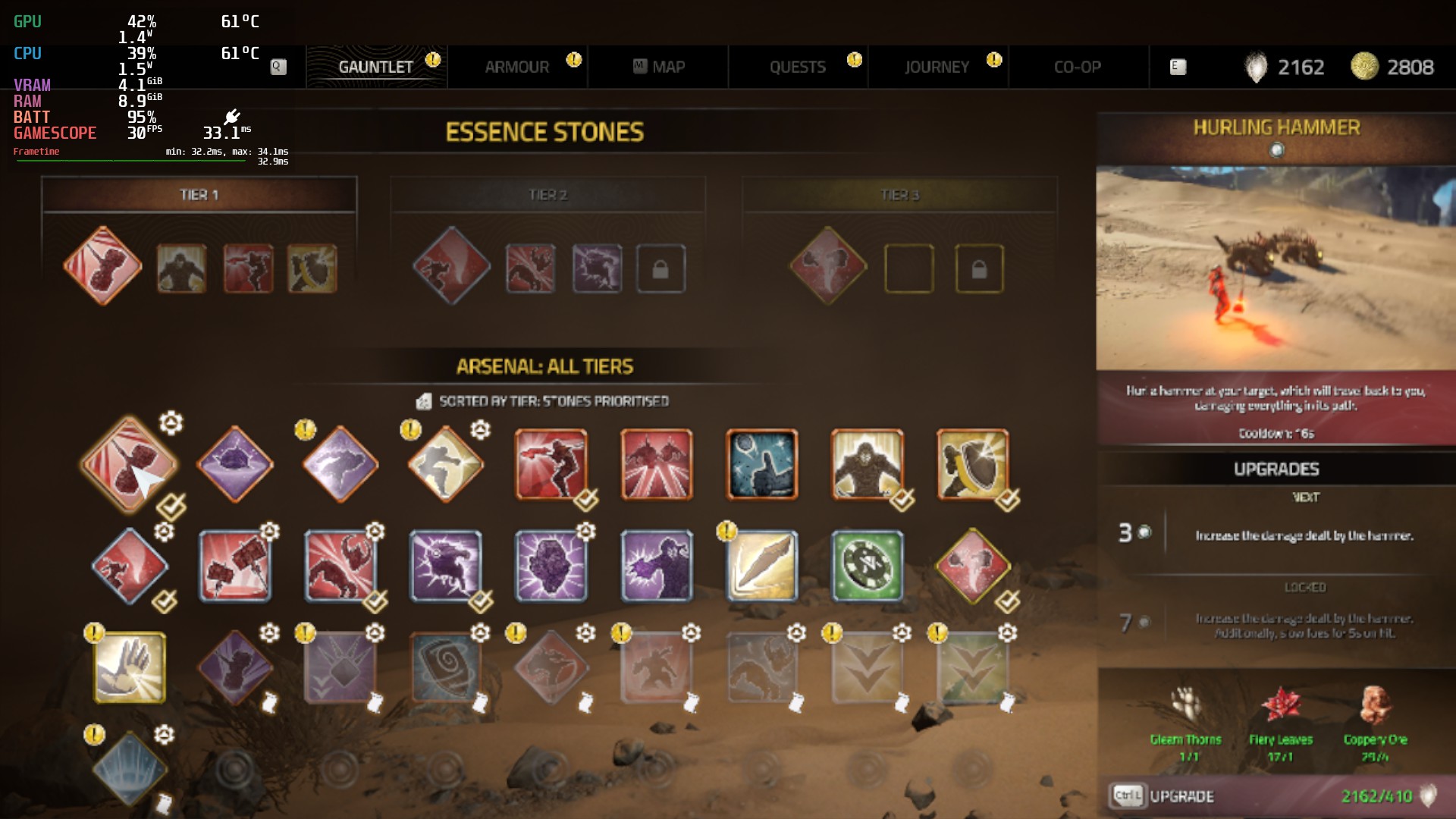
In the beginning, Atlas Fallen runs pretty okay. Keeping it at a solid 30 FPS, and even getting to 40, was very possible. But as I played the game more, and the world started to open up, it became harder to run. With this being a gigantic world that you can traverse quickly, there are some slowdowns when going around to new areas too fast. If you are running or surfing around in the immediate area, the game will keep a consistent rate, but other than that, it will slow down a bit as it loads in new areas.
I have also seen some framerate drops when in some combat scenarios. Fighting a gigantic enemy is usually okay 1v1, but when other enemies show up, and they all start using moves that kick up sand, it can start slowing down a bit.
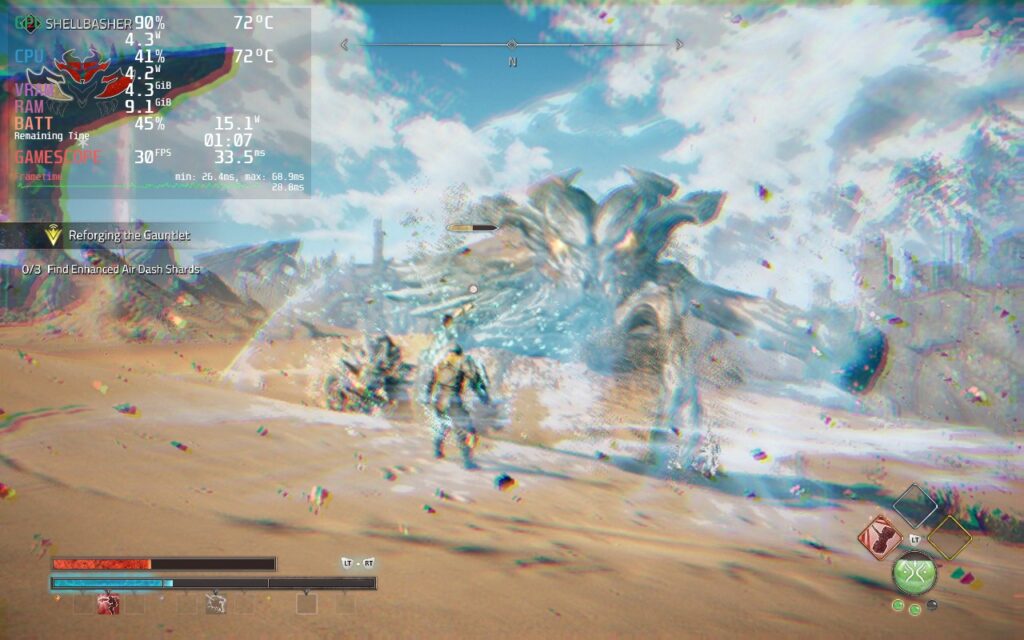
In my opinion, these drops seem to be engine or game-related and not the Steam Deck's fault. I noticed that, whenever there were drops, the battery drain of the Deck didn't spike and CPU, GPU, and RAM usage was under 99%. This leads me to believe something isn't optimized within the game, causing these issues (and I did see similar ones on the ROG Ally). I believe we could see a lot of this patched up and the shader cache could help iron out some stutters when loading in new areas, but only time will tell.
Without any caps, and everything on low, Atlas Fallen still has some trouble sticking to 30 FPS completely stable in the open areas, but when in corridors, caves, or confined areas, the game can hit higher framerates running around and in combat. So, due to this, I actually only have 1 build for the game. Hitting above 30 FPS isn't viable, so my build is a mix between battery and performance. I have the resolution set to 960x600 with the window at 1280x800, lower intensity post processing effects, and low quality settings. I do have textures set to medium as they don't affect performance as much, but do help the game's visuals a bunch.
These settings, with a TDP limit of 10, allow the game to stick around 30 FPS most of the time with a battery drain between 11W - 18W depending on the area. I also found Proton GE helped a little bit in some harder scenes to keep the framerate stable. With these settings, some text will still be small, but I found the performance improvements to be too great.
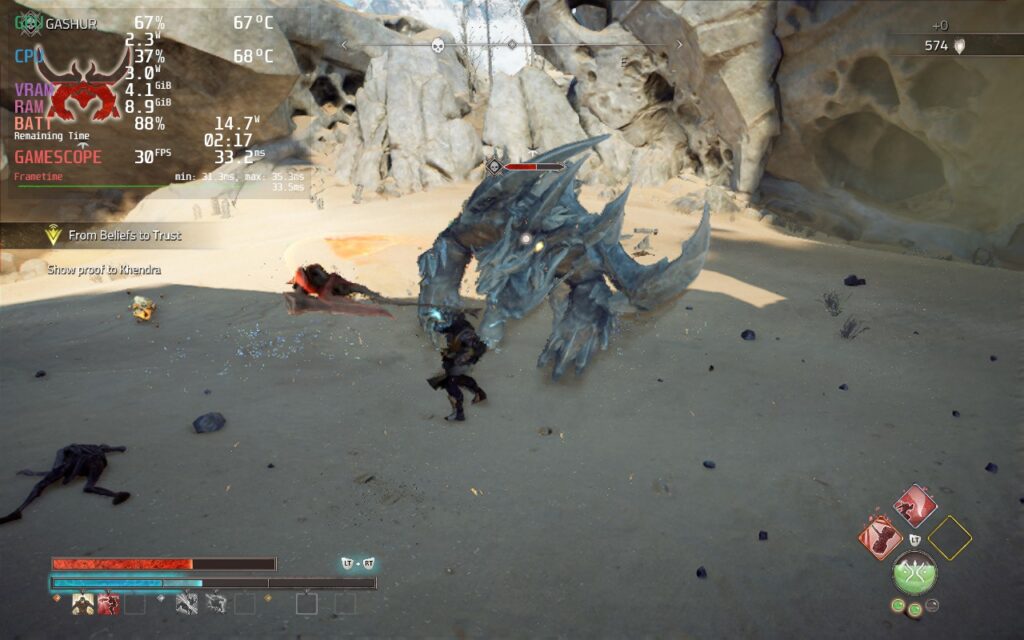
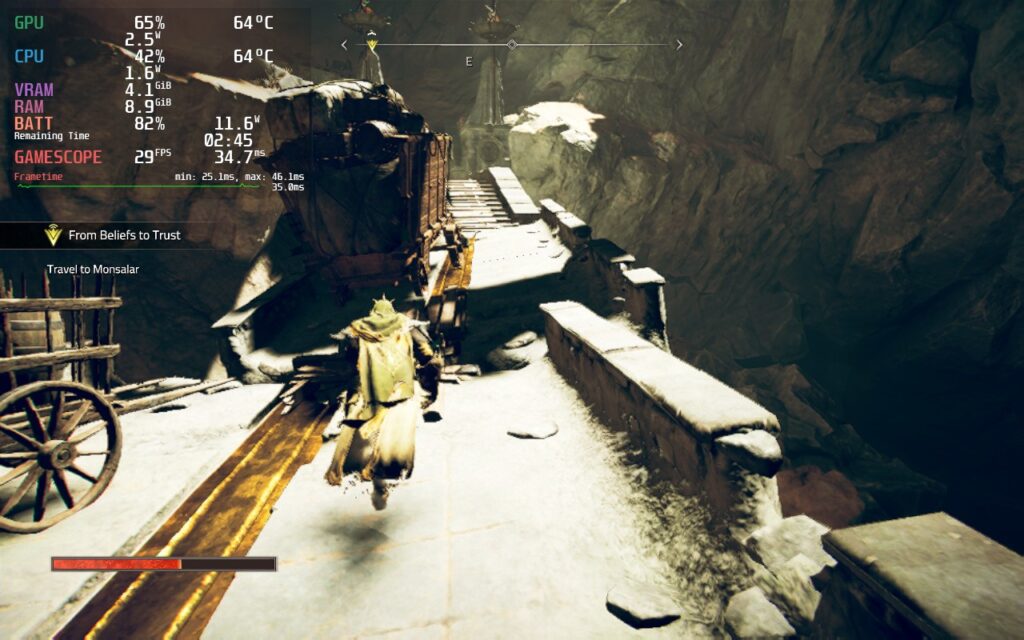
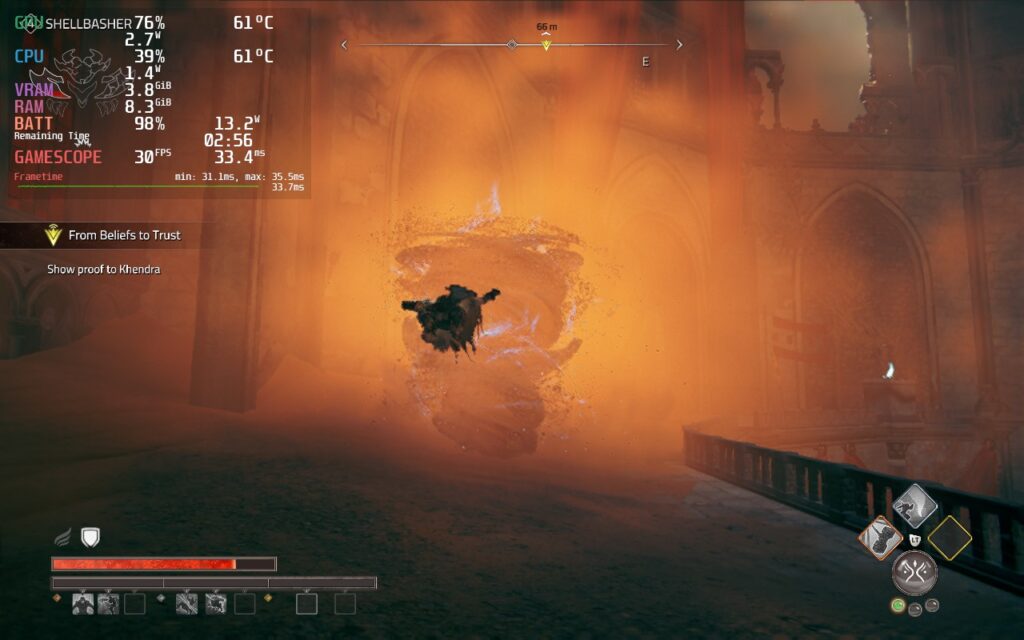
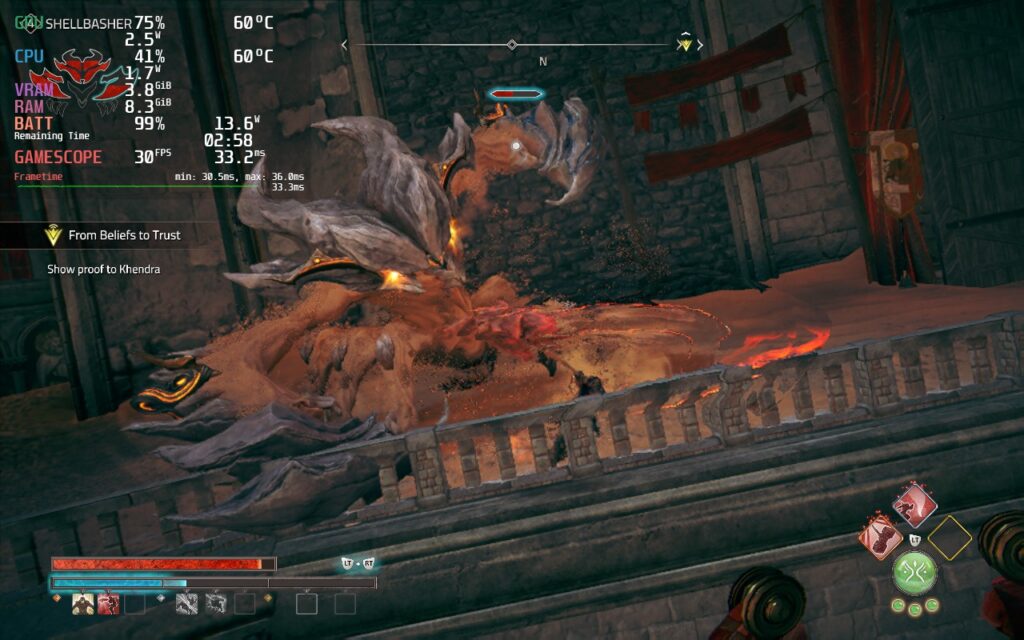
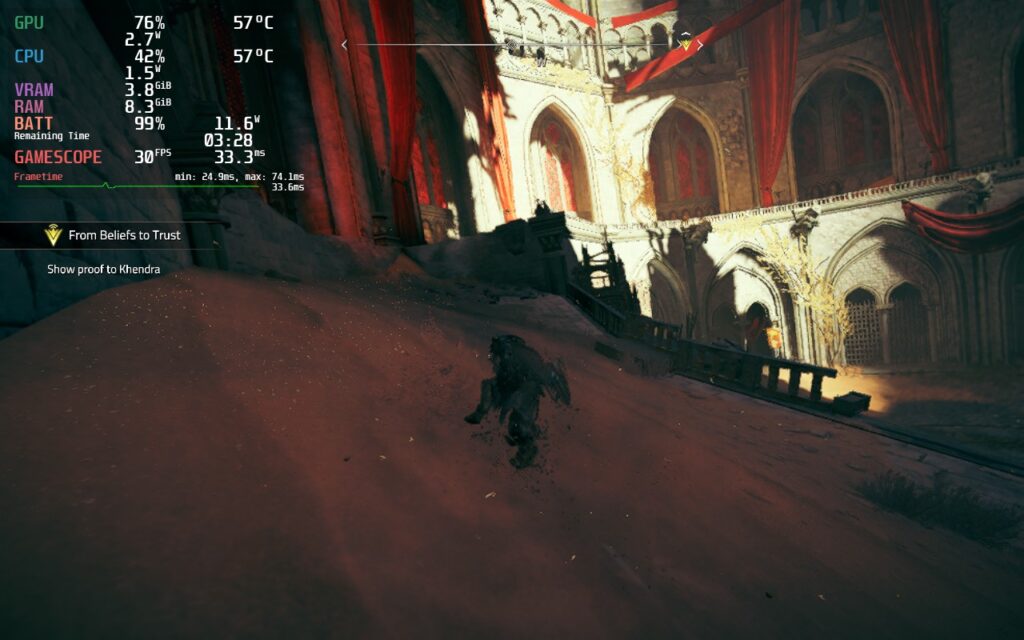
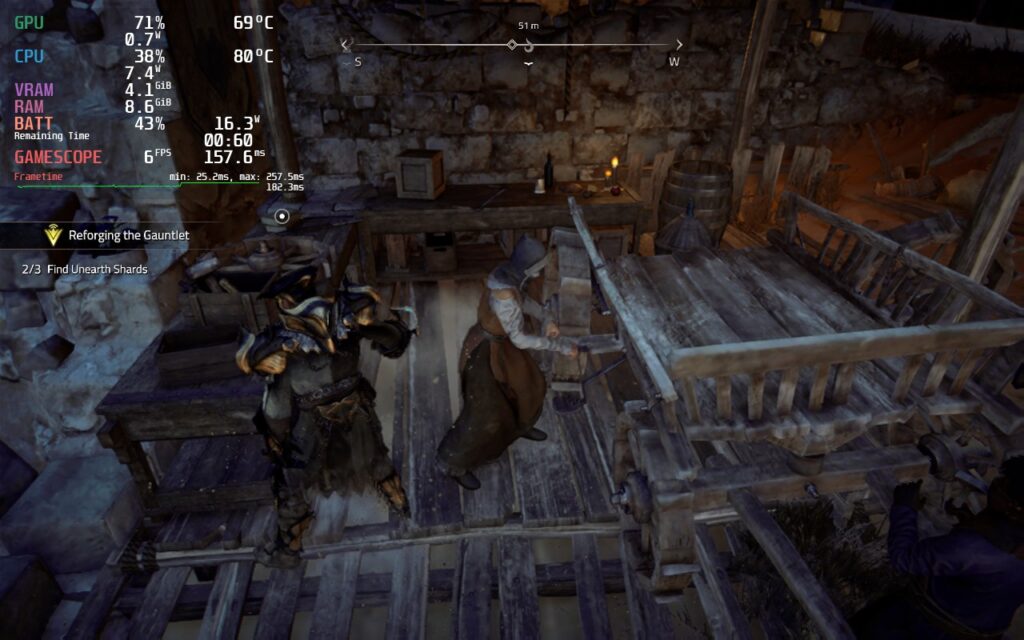
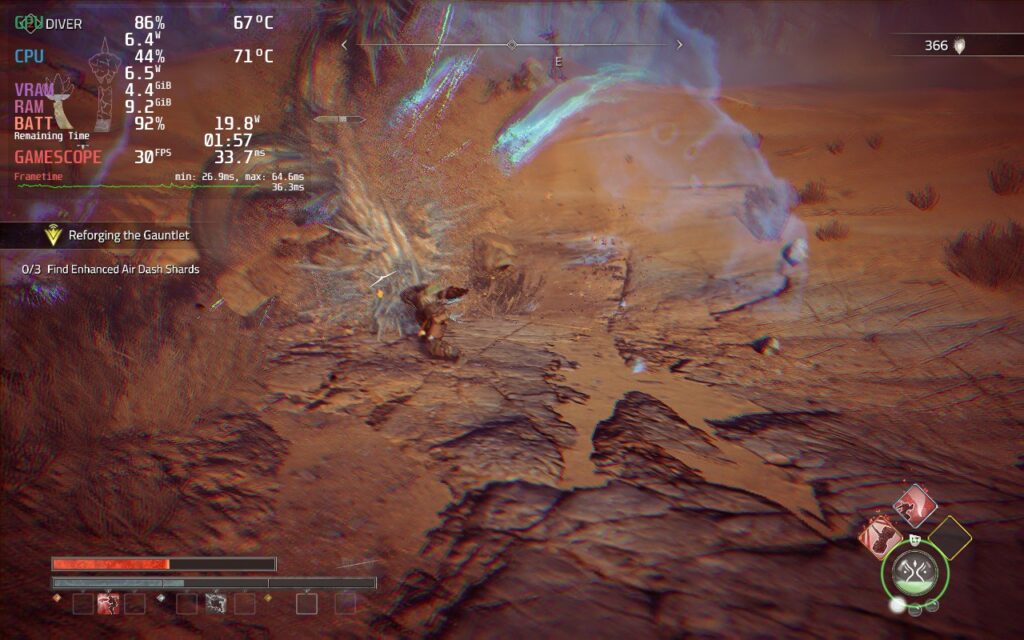
The game does have 16:10 resolution support, so there are no black bars, and has full controller and cloud save support. I did test the game with CryoUtilities and the UMA Buffer set to 4GB, but I didn't see any discernable difference with either of these changes. I did also test the DirectX 12 version of the game, but it wouldn't launch no matter which Proton version I chose.
Atlas Fallen is a solid action RPG that gave me a bit of a mixed bag at times, but I loved the mechanics. The story is alright and does have an interesting tale woven in the desert world, though it pales in comparison to other deeper stories. At times, the world can feel a bit barren and dull, but surfing and going down slopes at an accelerated speed can be really cool. Combat itself can feel a bit slow at times too, but there is something extremely satisfying when fighting bigger enemies, or many smaller ones, when your momentum gauge is filled and your weapon grows in size, hitting multiple weakpoints or enemies at a time.
I love the simple nature of the armor system, perks, and the momentum bar. Atlas Fallen does well balancing out its simple systems and makes each different set of equipment, weapon, and essence stone feel special and impactful. As a game, I really enjoyed Atlas Fallen, even with its faults.
On the Steam Deck, it was a bit hard to play due to some of the performance issues it has, but with the tweaks, it becomes a lot more playable. It isn't perfect and still has compromises, especially with some readable text, but it is playable. It is very possible some future patches and the shared shader cache can help with some stuttering going into new areas, so I will evaluate again in a couple days when the cache is built, but if you are buying or pre-ordered the game, this will be the experience you get out of the box.
Our review is based on the PC version of this game.
If you enjoyed this review, be sure to check out the rest of the content on SteamDeckHQ! We have a wide variety game reviews and news that are sure to help your gaming experience. Whether you're looking for news, tips and tutorials, game settings and reviews, or just want to stay up-to-date on the latest trends, we've got your back!
NInja or Die was provided by Marvelous Europe for review. Thank you!
Ninja or Die: Shadow of the Sun is a fast-paced action roguelite inspired by Japanese folklore. Set in the afternath of a cataclysmic event, you are a common pickpocket that was transformed into a ninja with lightning-fast reflexes and mobility. Now you are stuck within a loop of chaos where you must leap from wall to wall, killing enemies, all while getting new gear, and leveling up to make it through.
For me, Ninja or Die is a fantastic blend of arcade-style action, RPG progression, and roguelike passive improvements to make an addicting, enjoyable experience. I found it so enjoyable and rewarding to chain together jumps and make it through the various different levels while destroying all the enemies there. And with the loot I would find, I would need to manage which items to keep, which souls to equip, and which items to throw away so I could find a balance of healing items, upgrades, and scrolls.
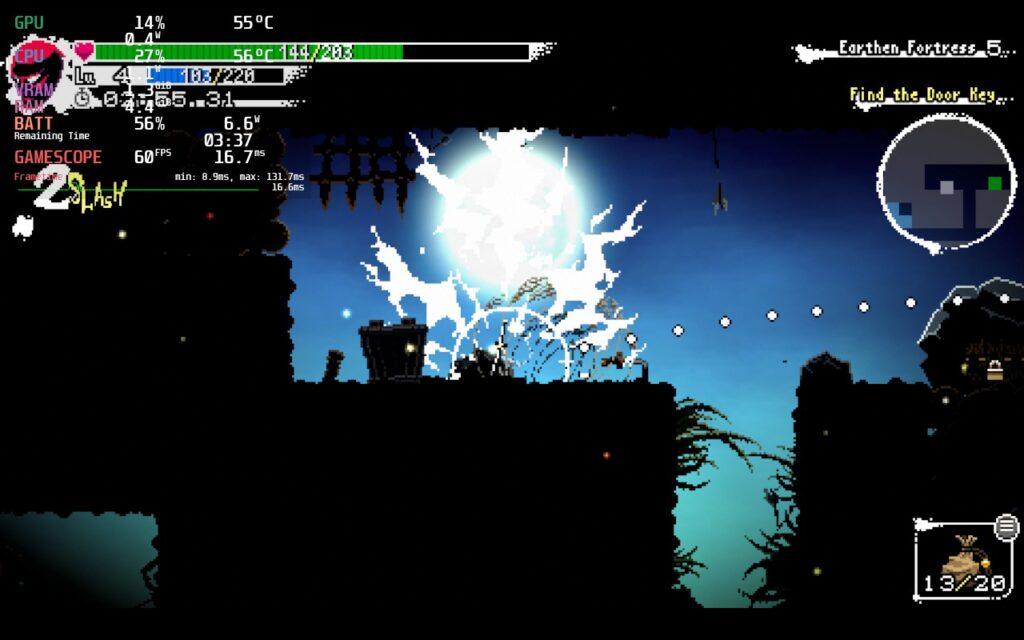
The game is also wonderfully replayable. Not only are there multiple characters and levels, but you will also be able to build up your village and upgrade your character further. Then, you can take on procedurally generated levels, the Infinite Watchtower or Corridor, or replay the game with challenges like the stage randomizer. There is so much you can do, so much content to enjoy, it is hard to stop.
I also love the visual style of the game. Not only is it unique with its Japanese inspirations, but it is also flashy and vibrant. From how the world is colored to the flashes of numbers when you damage a foe to the way your entire screen changes when charging up a jump, the beautiful blending of color and style captivate and make it hard for me to take my eyes off. I love the game and I love being able to play it so easily on-the-go with the Steam Deck.
Due to the way the game is styled, I didn't expect it to need many changes to run optimally and I am happy to say I was correct. Without any changes, Ninja or Die: Shadow of the Sun is able to hit 60 FPS with a low battery drain of 6W - 8W. I didn't expect this to be any different due to how the game looks and how little power the game demands, but it does have two flaws.
The first is that the game has full controller support, but Steam Input defaults to Keyboard + Mouse controls. This can be easily fixed by going to your controller preset and switching/applying the Gamepad with Joystick Trackpad scheme.
Second, it appears the game has a bottleneck where, in some very heavy scenes, the game's framerate will dip to 45 - 50. Without the overlay, this wasn't noticeable, but during these moments, there would be a slight slowdown and a battery drain spike to 10W - 11W. This only happened a couple times to me, but it was enough to take notice.
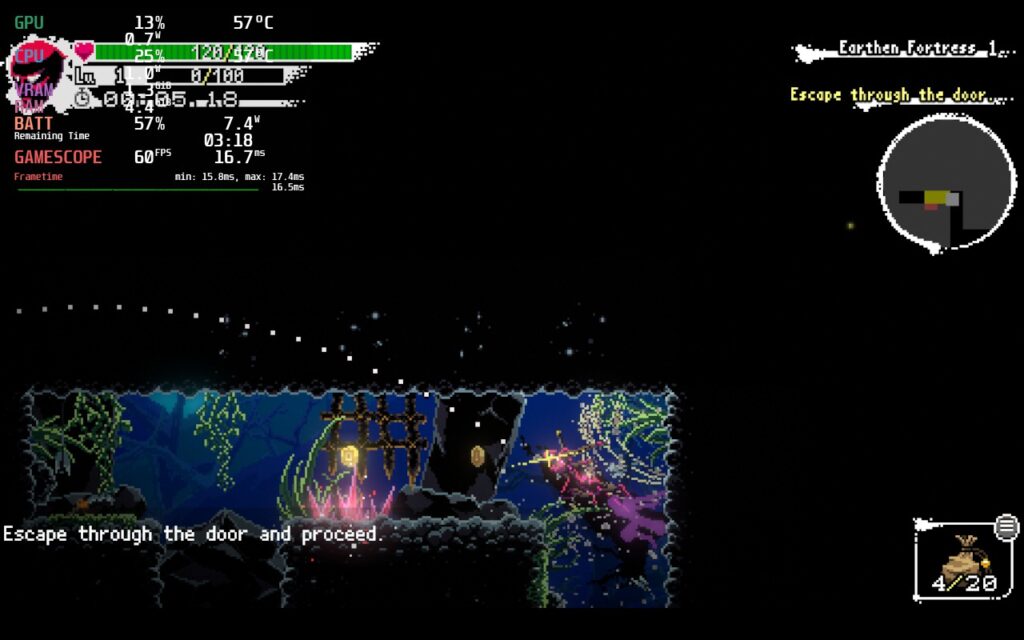
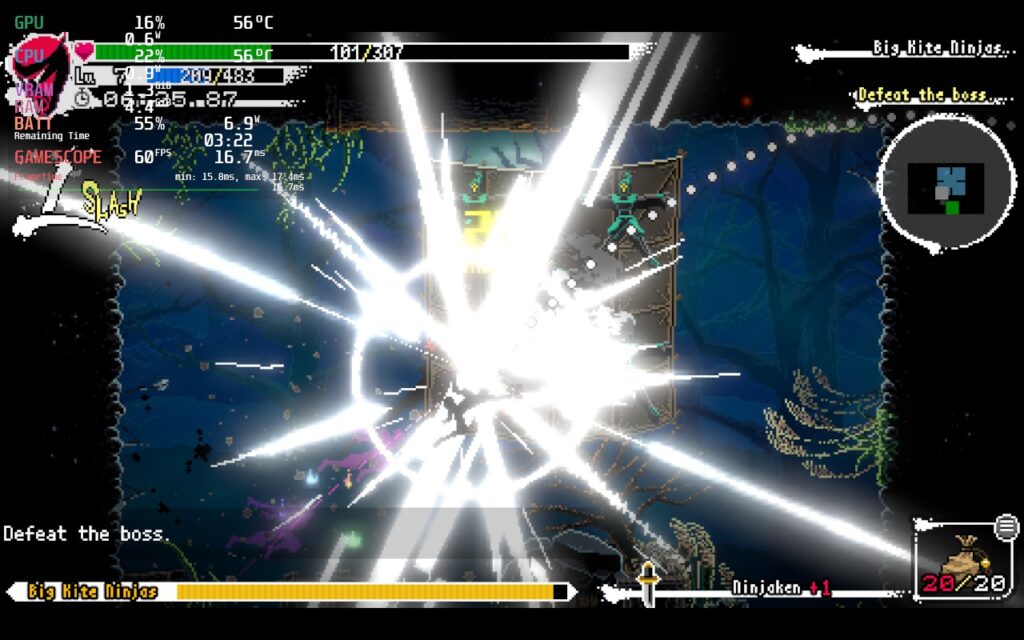
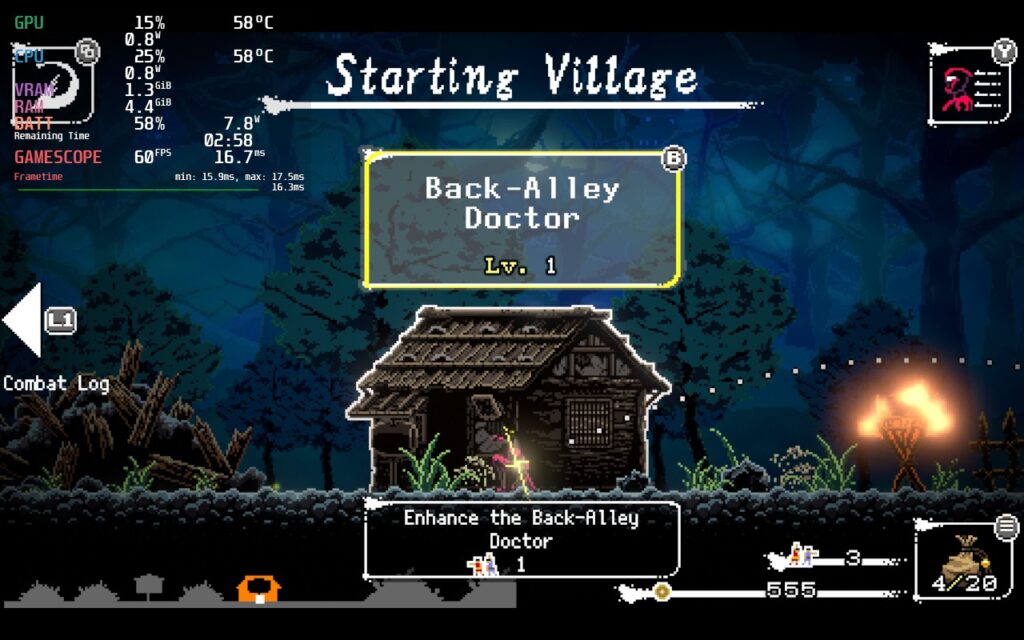
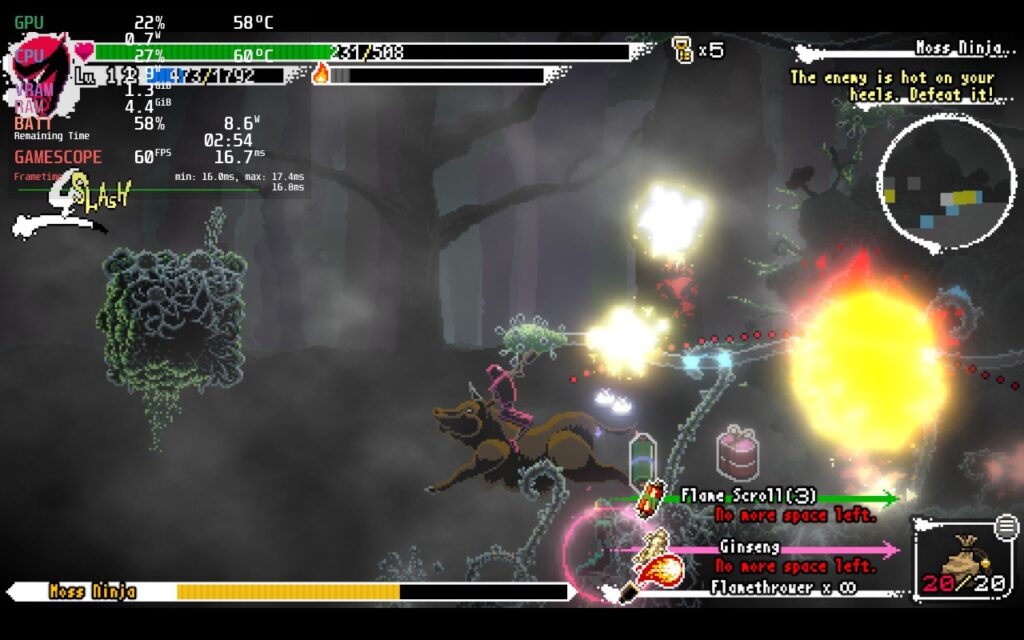
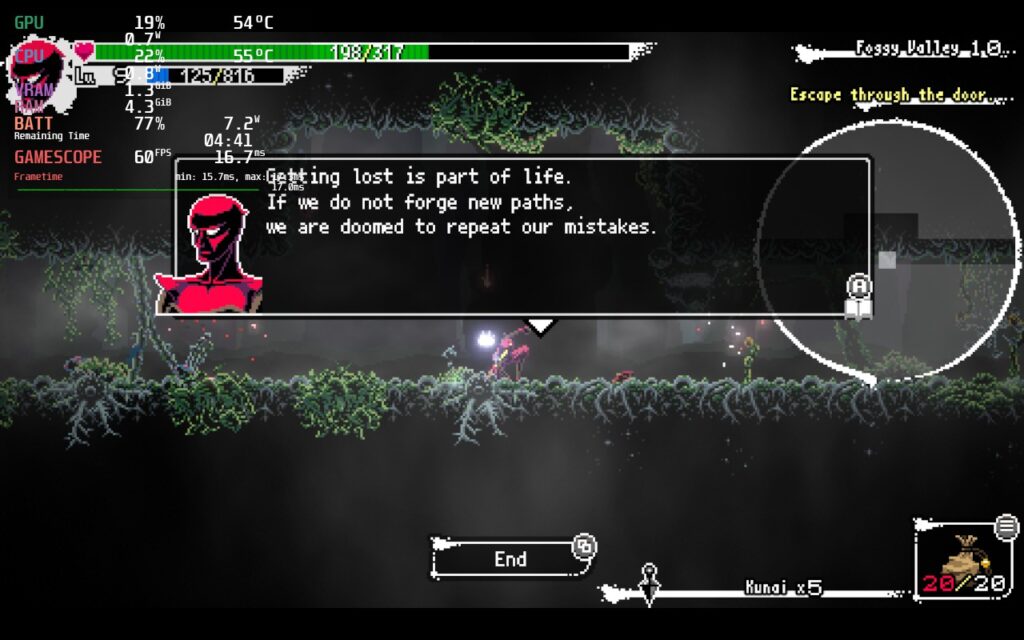
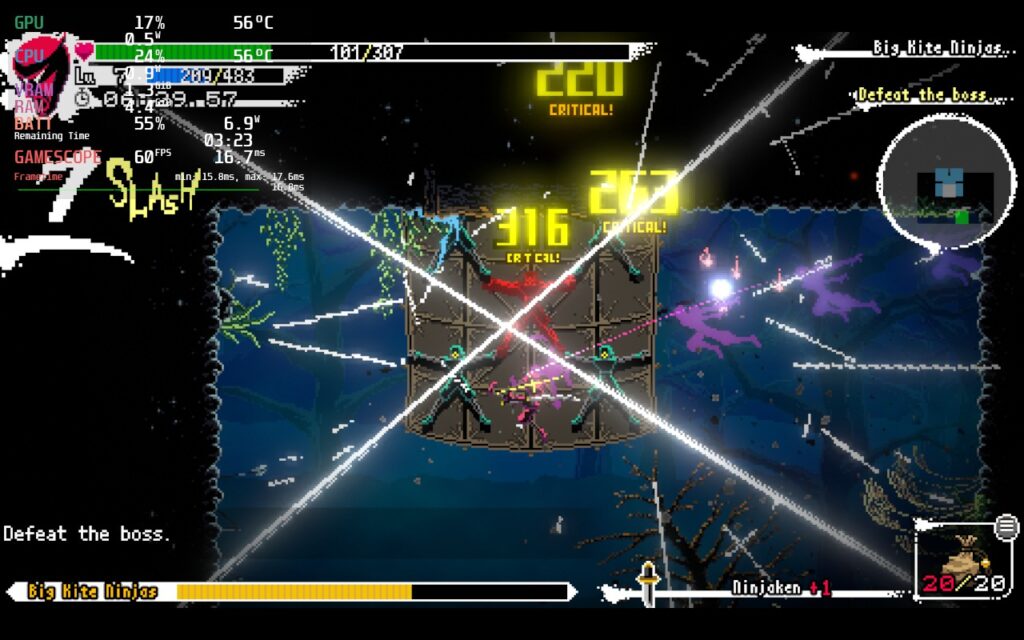
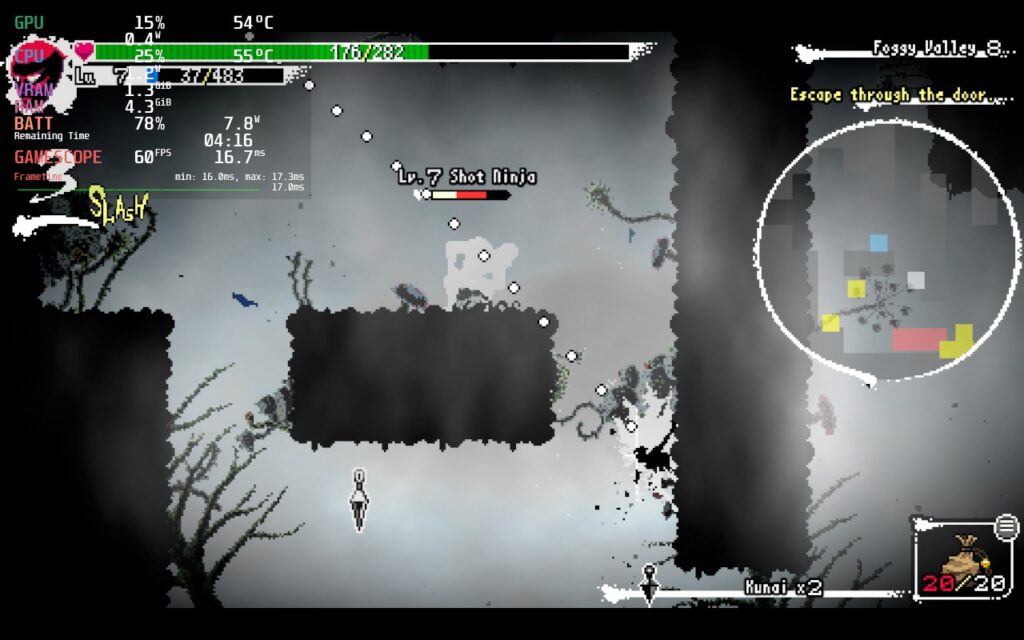
While the game doesn't support 16:10 resolutions, it does have full controller support (just need to swap over the control scheme) and cloud saves!
Ninja or Die: Shadow of the Sun is a game I did not expect to take up as much of my time as it did. It is a fast-paced roguelite with RPG elements that keeps you moving and constantly thinking about the best way to jump and navigate while taking down enemies in flashy brilliance. The game is so pleasing to just look at that I had to stop a few times just to take in the colors. On top of that, the game runs really well on the Steam Deck, even with a couple of areas that are bottlenecked. As long as you have the overlay off, you won't really notice this at all and fully enjoy the game on-the-go.
Our review is based on the PC version of this game.
If you enjoyed this review, be sure to check out the rest of the content on SteamDeckHQ! We have a wide variety game reviews and news that are sure to help your gaming experience. Whether you're looking for news, tips and tutorials, game settings and reviews, or just want to stay up-to-date on the latest trends, we've got your back!
Lone Ruin was provided to us by Super Rare Originals for review. Thank you!
Lone Ruin is an action-roguelike game set in an old magical ruin. The game features two different modes to test your mettle: Ruin Run and Survival. Ruin Run is a more traditional experience like Hades, clearing rooms and getting upgrades and gold to buy more upgrades from the shop until you get to the end of the levels (all while faces some bosses in between). Survival is closer to games like Vampire Survivors where you face waves of enemies and you get experience, getting an upgrade of your choice once you level up. With a normal and hard mode, gorgeous visuals, and a plethora of abilities, will you be able to master the ruins and defeat these twisted monstrosities?
Lone Ruin is a game I personally have mixed feelings about, but I overall feel positive about my experience with it! The game itself is a bit lacking in content and once you beat it, it feels like there isn't much to replay. But what it lacks in replayability, it makes up for with its unique graphics and fun gameplay. Some of the combos of spells and weapons can be overpowered, but I generally had a lot of fun playing through Ruin Run and Survival, though I personally enjoyed Survival mode more. Normal is a bit on the easy side too, but Hard feels just right!
On top of all of that, the developer has stated he will be adding more content to increase replayability! For $15, I feel this is a fair price for what you are getting. $10 might be a little more accurate for what is there now, but if more replayability is added, I would easily recommend this at the $15 price point! But no matter the price, this is a game you will be able to enjoy on the Steam Deck.
Due to it being a game that isn't super intensive, Lone Ruin can run flawlessly without needing to change any settings! Without any changes and no limits set, you can expect to get around 10W - 12W average with 60 FPS! There are some instances I have noticed where framerate can drop for a split second, but this didn't affect the gameplay at all.
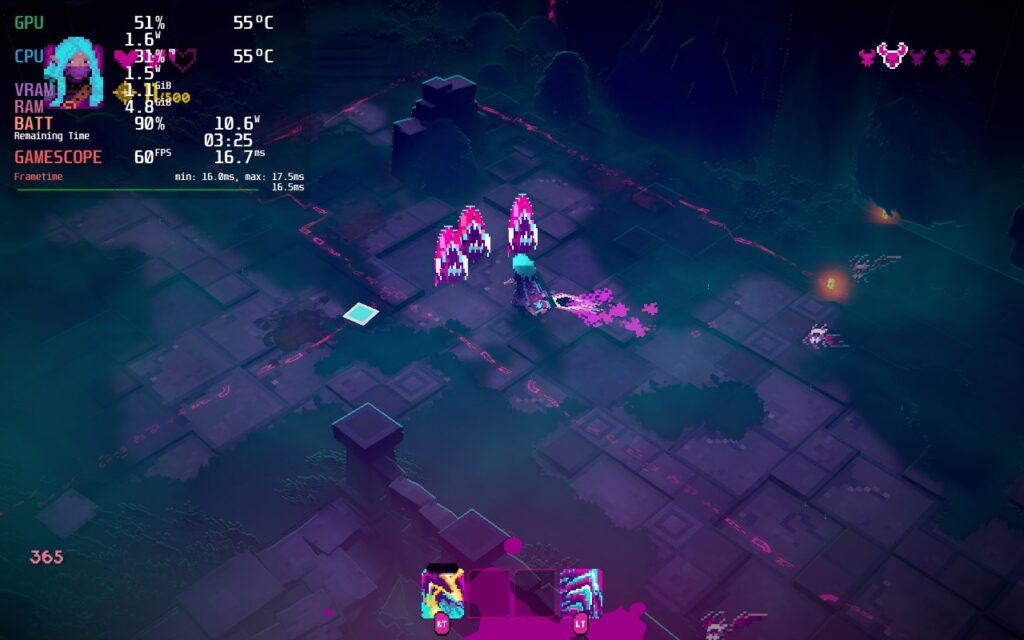
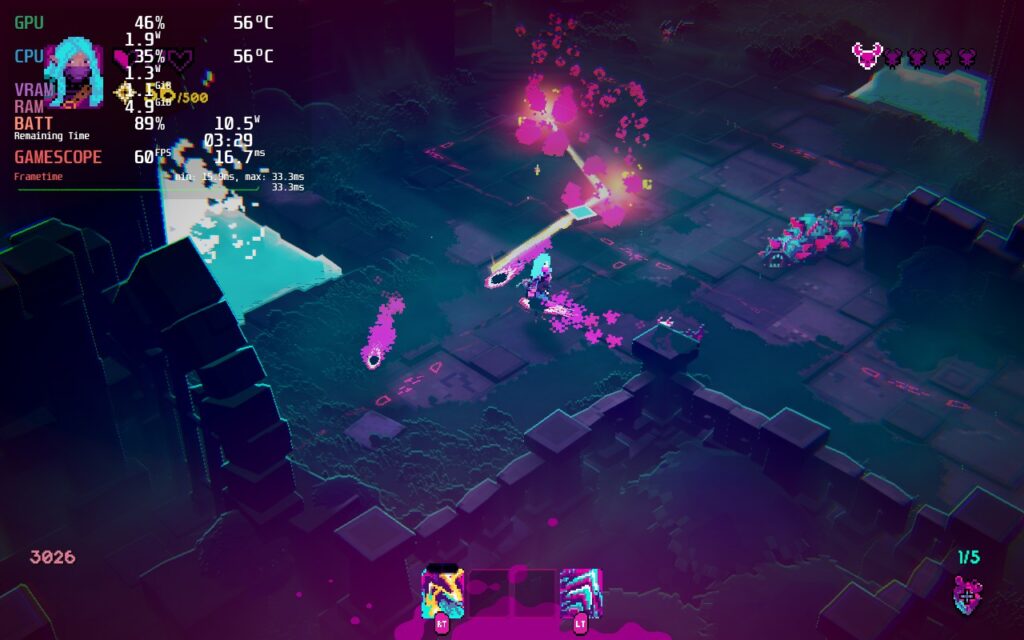
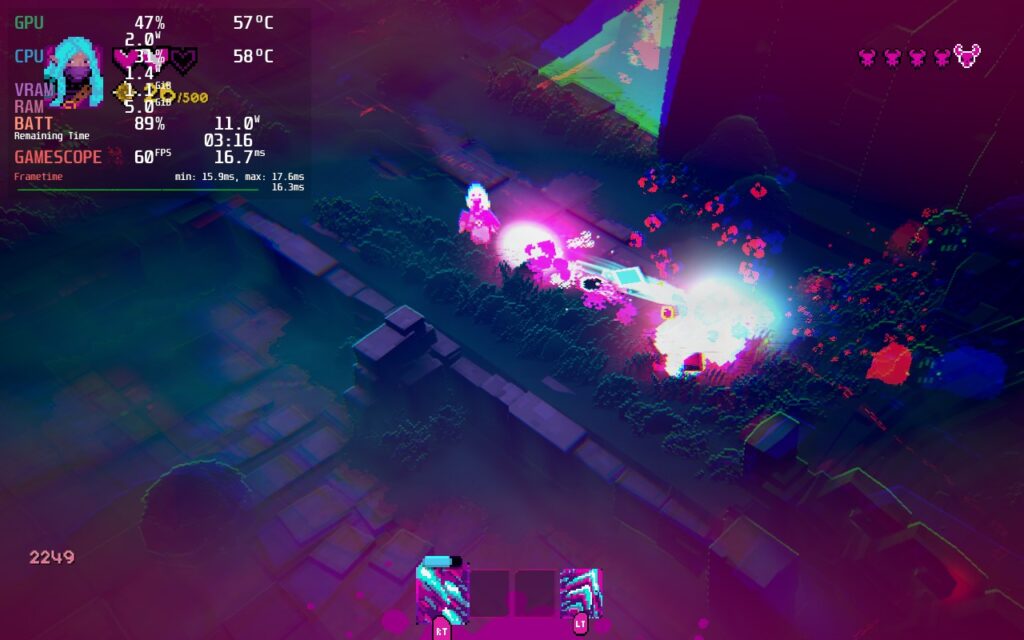
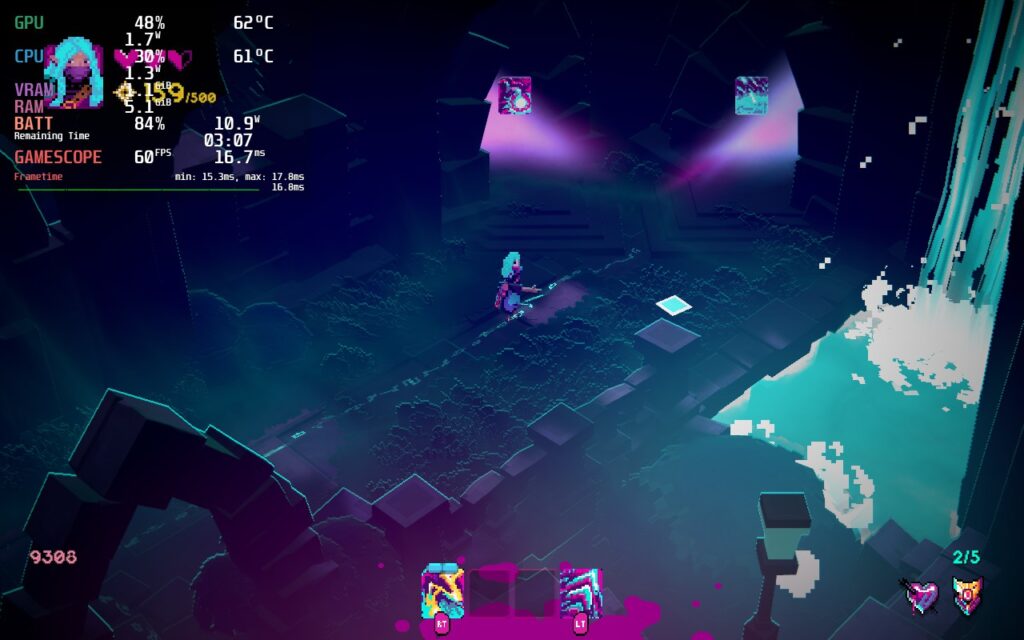
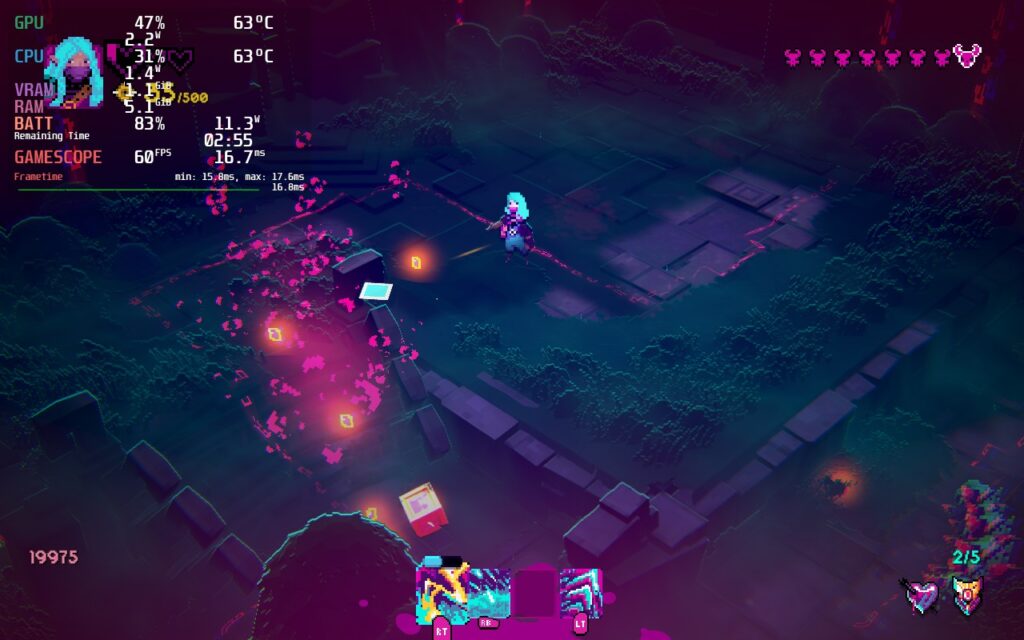
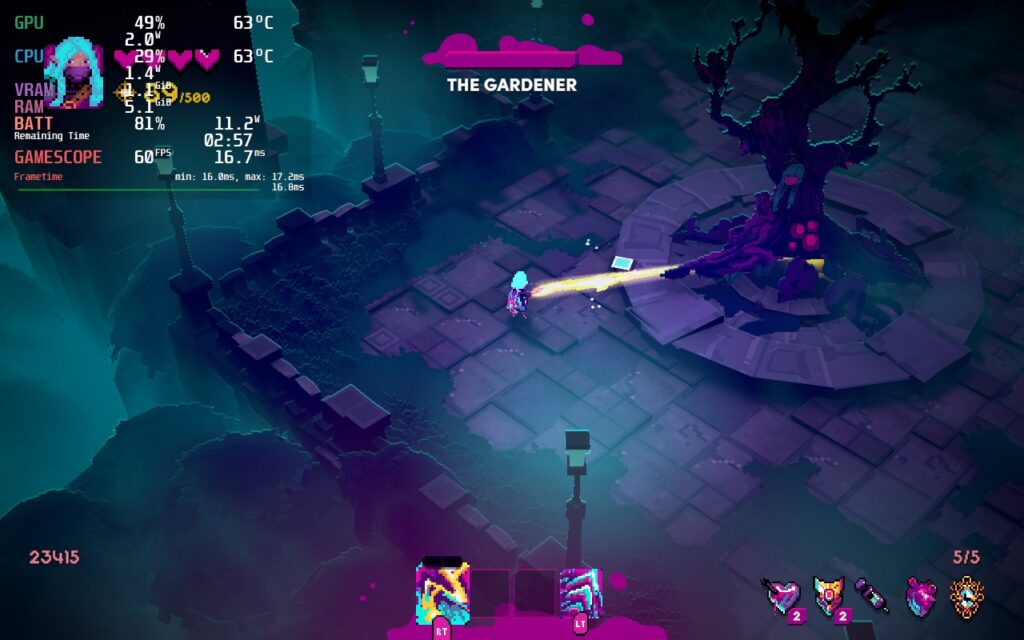
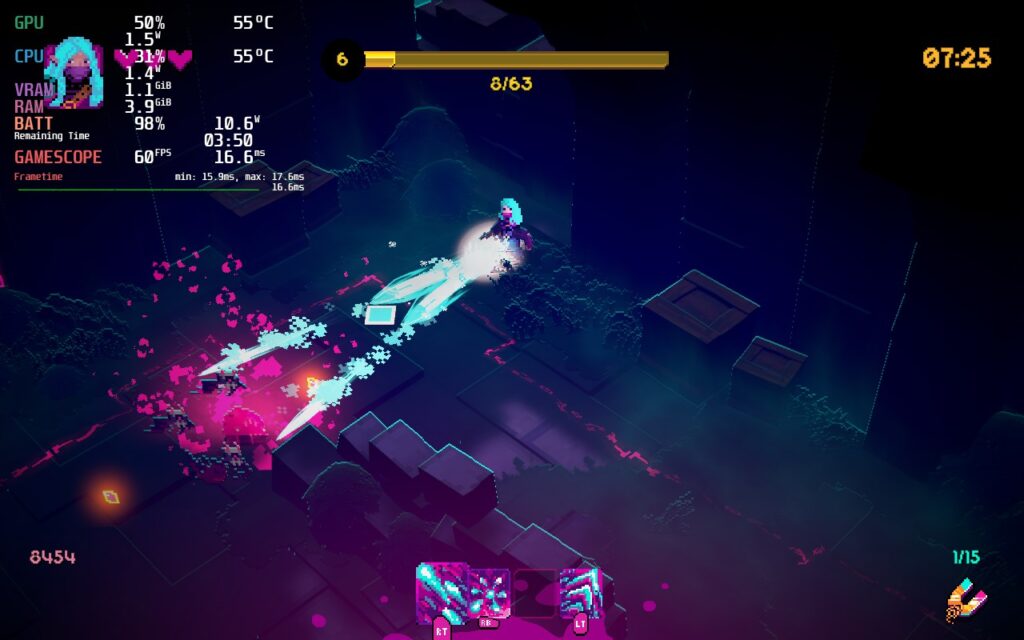
I had no issues with controlling the game using the gamepad and no visual issues. Lone Ruin also supports 1280x800 resolution with the battery lasting around 4 hours!
Lone Ruin has a lot of potential to be a necessity in your libraries if you enjoy roguelike games. The visuals are enchanting and the gameplay is tight and fantastic, but a lack of replayability can be seen as a big shortcoming. I feel it is worth $15, especially if/when the new content is added, but I don't regret the time spent with this one at all! And it is guaranteed to be a great time on the Steam Deck thanks to no changes needed to enjoy! I am happy to give this game our Best on Deck rating!
If you enjoyed this review, be sure to check out the rest of the content on SteamDeckHQ! We have a wide variety game reviews and news that are sure to help your gaming experience. Whether you're looking for news, tips and tutorials, game settings and reviews, or just want to stay up-to-date on the latest trends, we've got your back.
Dust & Neon was provided to us by Rogue Games and Keymailer for review. Thank you!
Dust & Neon is a roguelike twin-stick shooter set in a futuristic wild west filled with robots! As a robot yourself, you will go on an epic quest to fight armies and partake in insane boss fights, all while unlocking abilities and finding the right weapons amongst thousands of different ones. Dying and coming back stronger with passive ability upgrades to beat the missions in front of you will be imperative as well. Now pick up your guns and get ready for a challenging top-down shooter that will keep you on your toes.
I first played Dust & Neon during the Steam Next Fest last week and it quickly became one of my favorite demos. The visual aesthetic of the game is right up my alley, vibrant and simple, while the gameplay loop is engaging and addicting. I do love randomized items/weapons and roguelike systems in games and I feel this one does it really well too. The randomized weapons keeps me trying to crawl up the power while managing if I will need a certain capacity or accuracy, while the passive upgrades I get after dying influence some of my choices in terms of spending money to get certain weapons initially.
You do have to reload your gun manually by pressing the X button, which some might not like, but I feel it adds to the challenge and charm of the game (also the gun showing on the right side when reloading is awesome). Combine the aiming, shooting, rolling, sliding to cover, and swapping between equipped weapons, Dust & Neon is such a fun game to play. And what makes it even better is how well it runs on the Steam Deck!
Booting up Dust & Neon, I noticed it was automatically set to the highest graphical quality. Luckily, the game runs fairly well at max! 60 FPS with the max settings brings in around 13W - 17W battery drain depending on the location and amount of enemies on the screen. While this is fantastic, there is a change or 2 that we can make to really get the maximum battery life out with the game still looking wonderful.
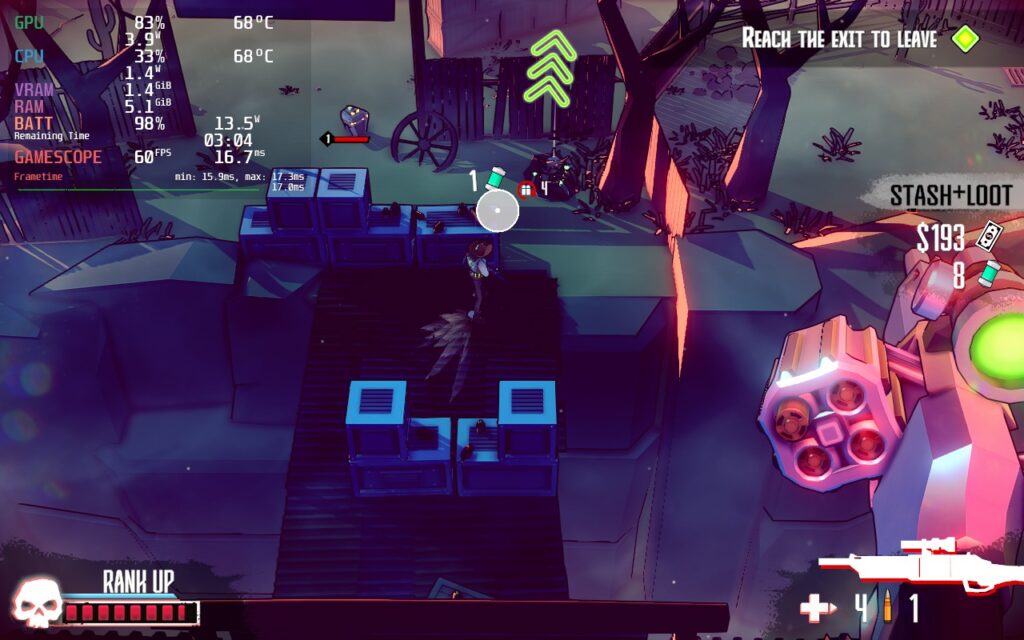
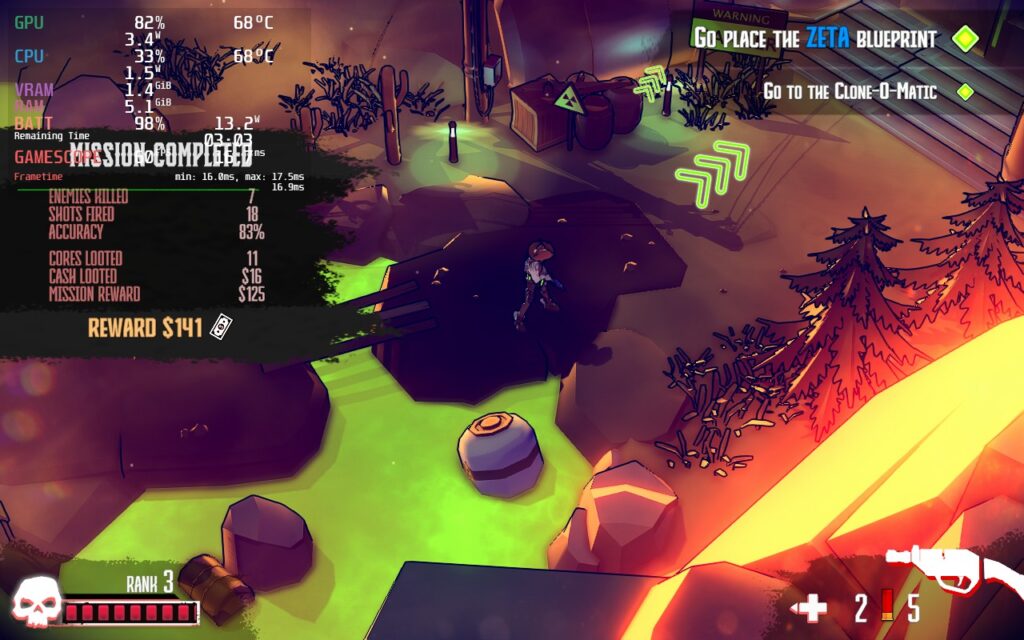
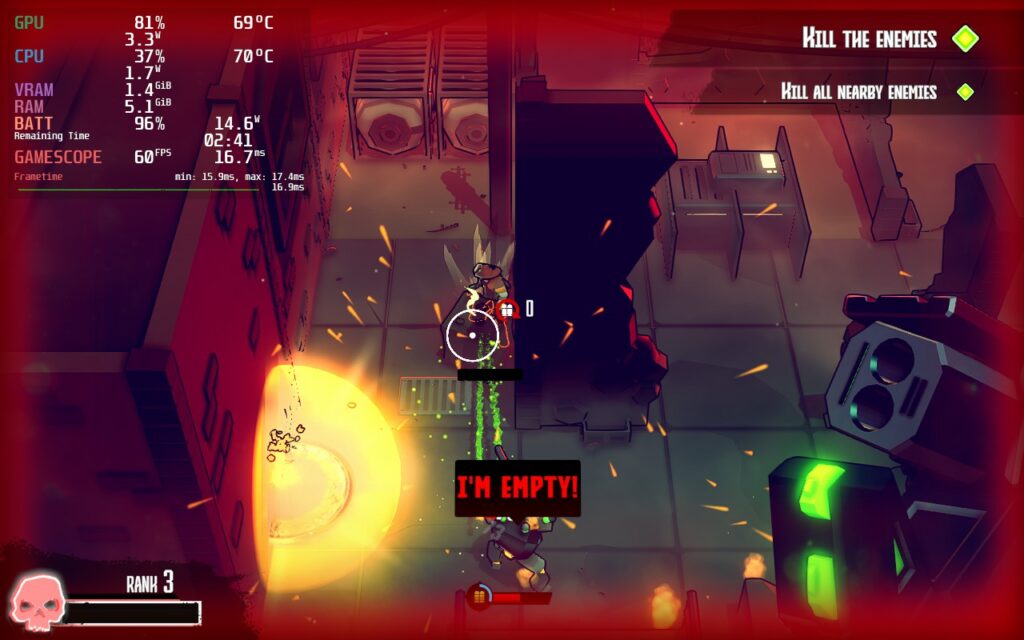
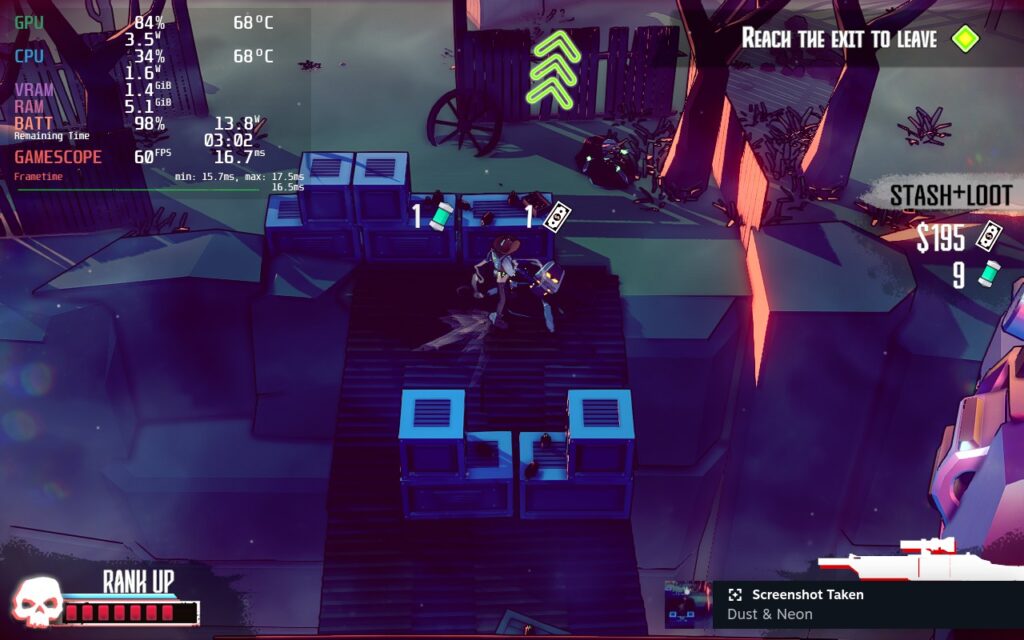
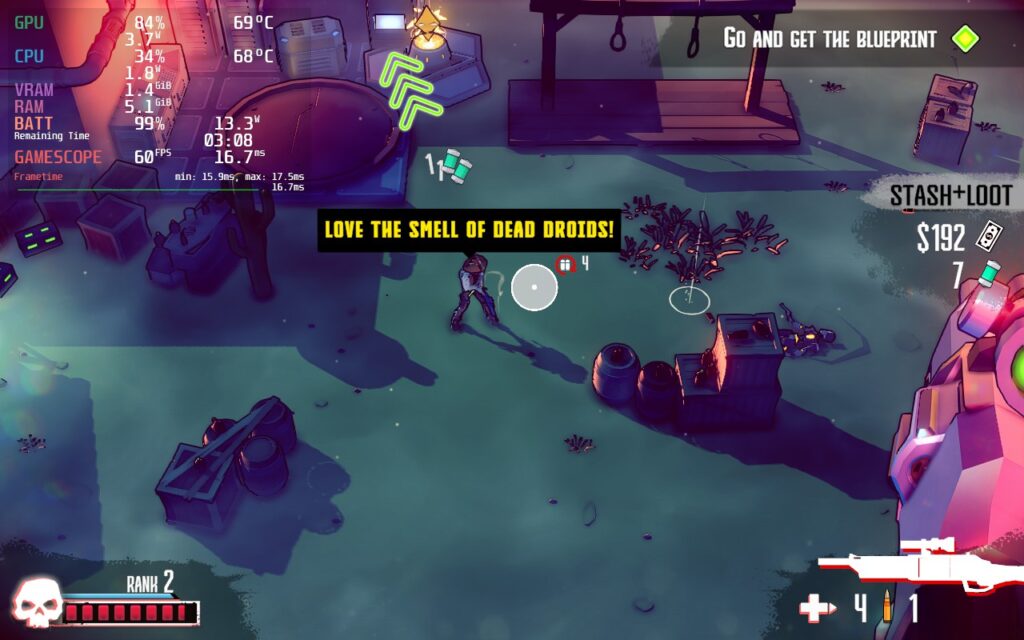
In this case, I wanted to retain the pleasing visuals and their crispness while bringing battery drain down. Luckily, I was able to do this just by turning the graphics down to medium. This primarily got rid of some detailed shadows, but overall kept battery drain around 11W - 12W. I did see once or twice where drain went a little above 13W, but this was far and few and overall added an extra hour or so of battery life. This is easily the recommended build I would say others should use.
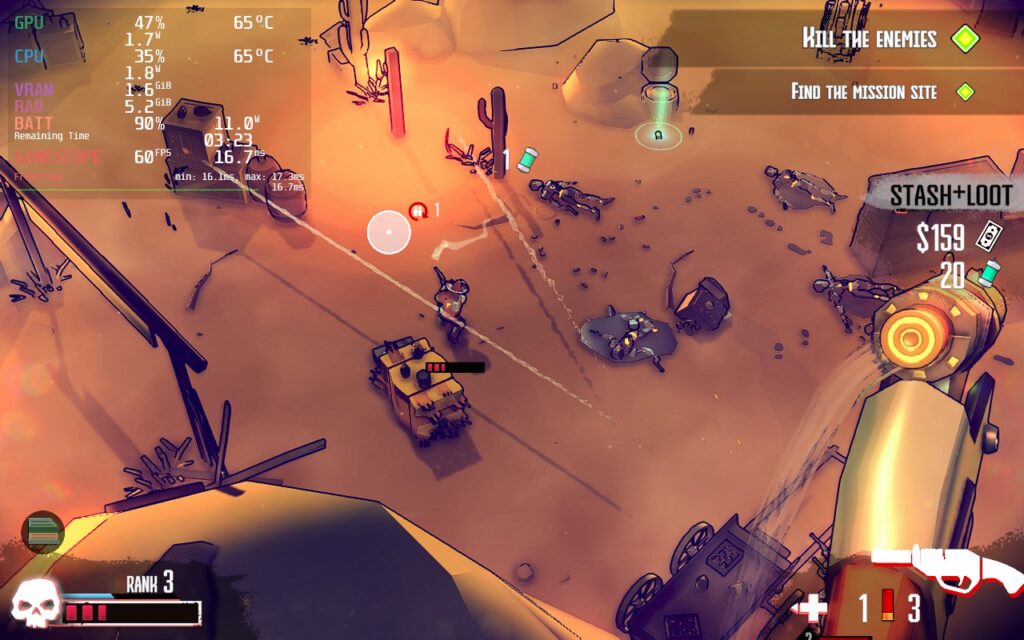
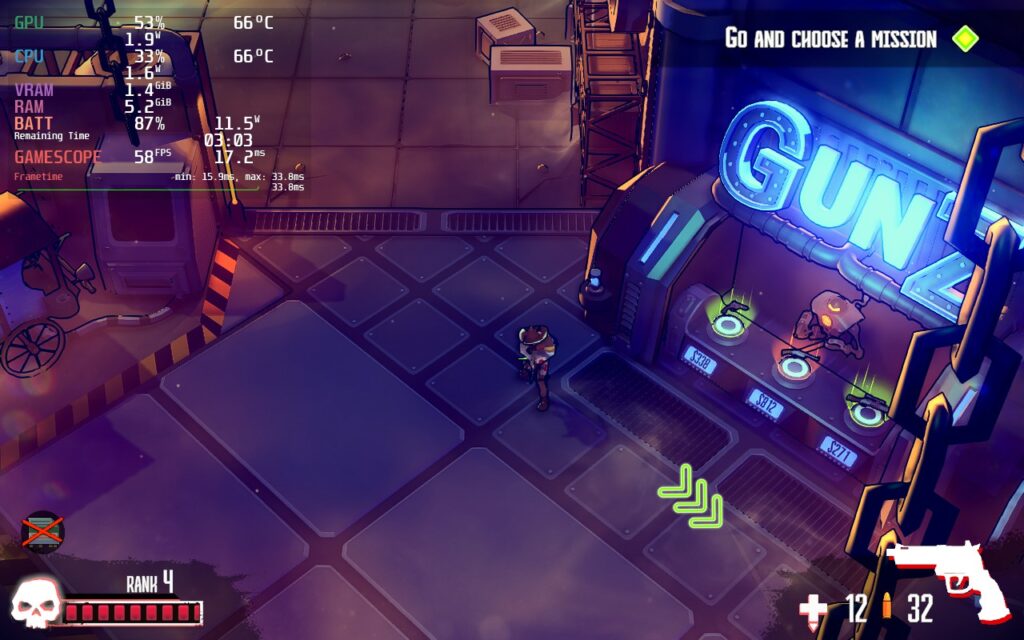
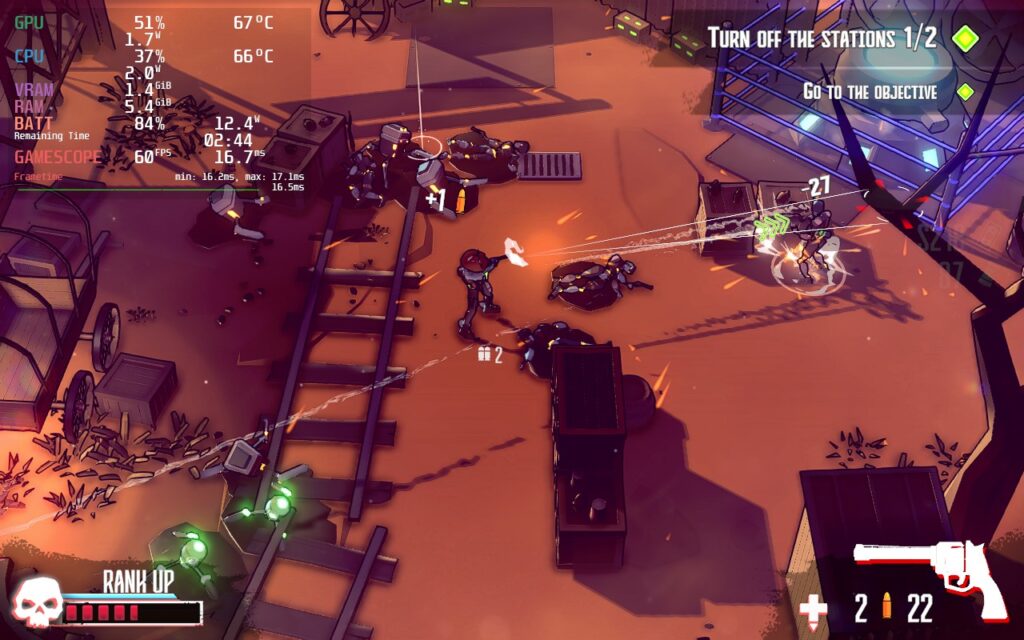
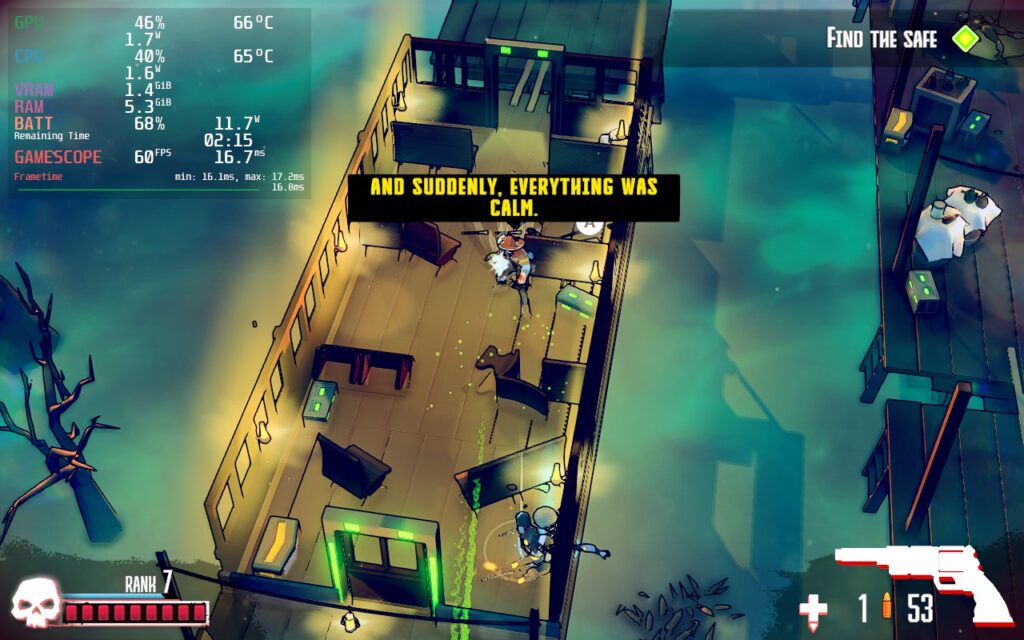
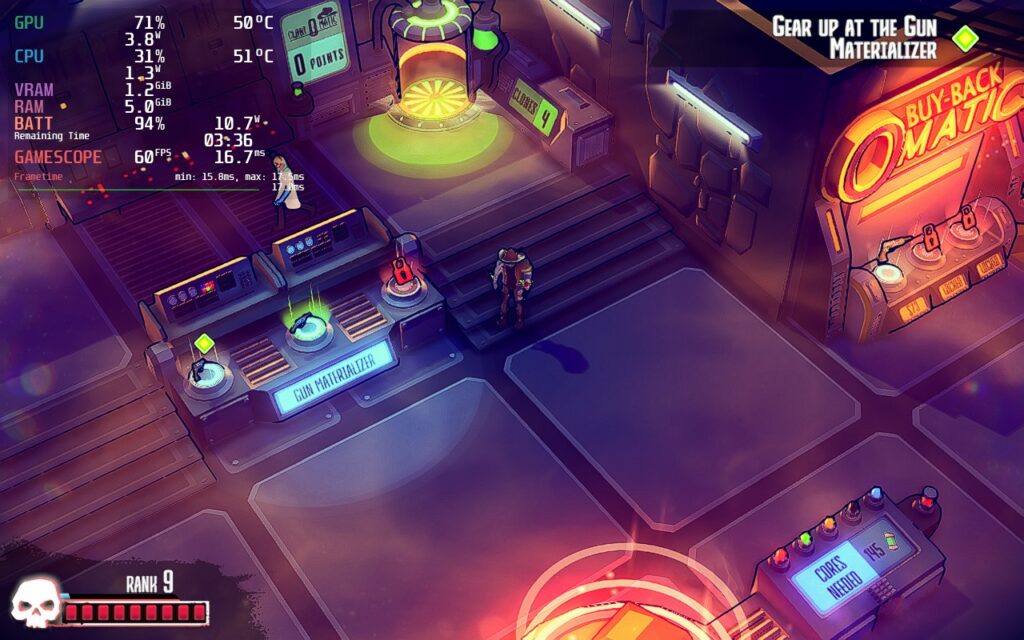
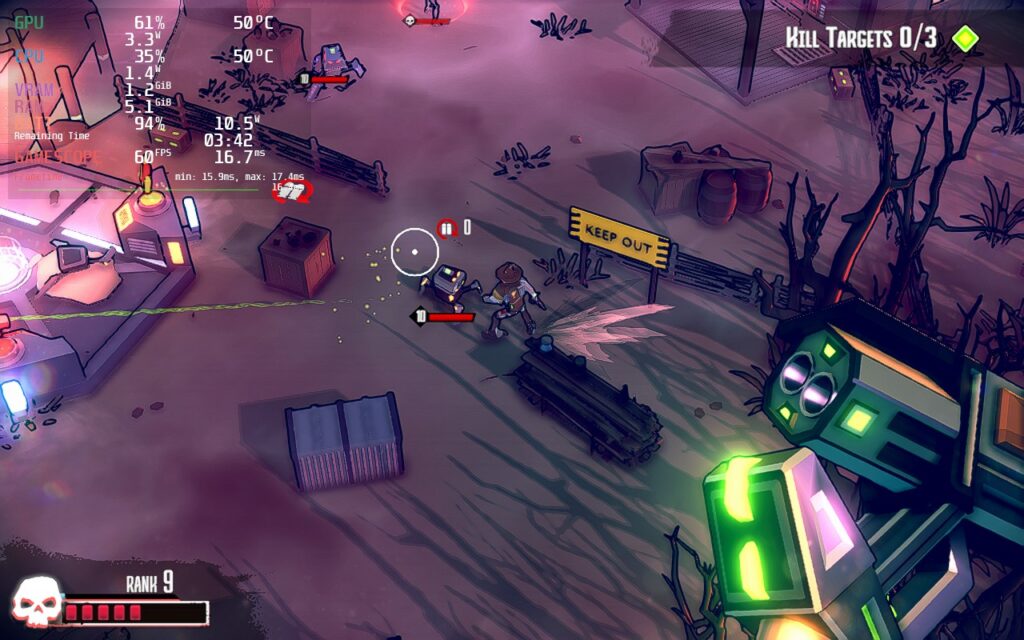
For a battery build, I elected to keep the graphics settings the same to keep the better shadows, but use Steam to force a 1024x600 resolution. This keeps the game looking quite nice still, with a slight bit of bluriness, but ends up saving around 2W drain with a stable 60 FPS. It looks a little worse, but if you're saving as much battery as possible without compromising visuals, this will be the way to do it!
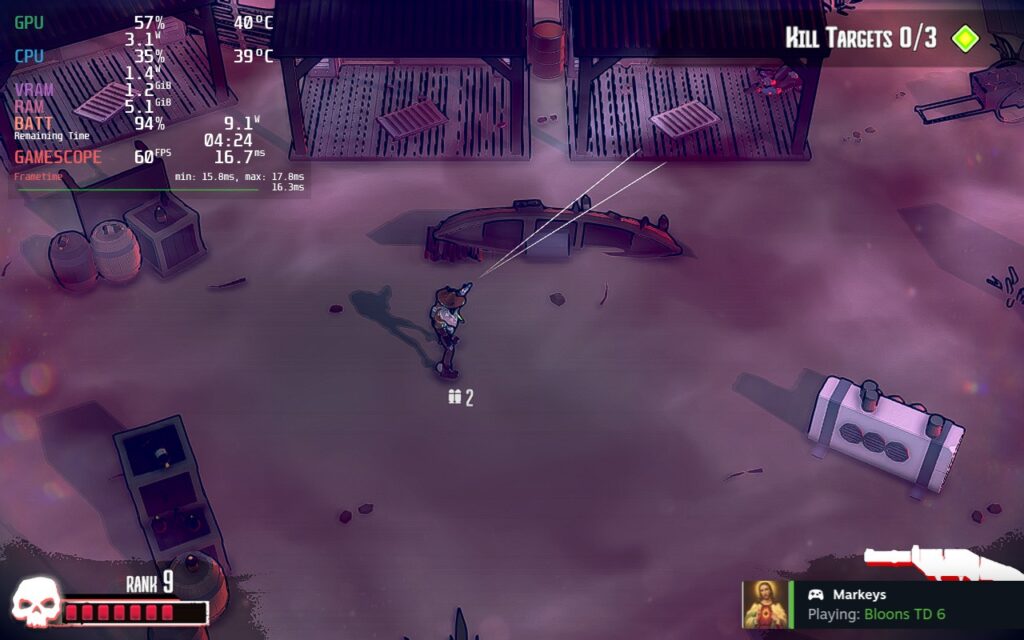

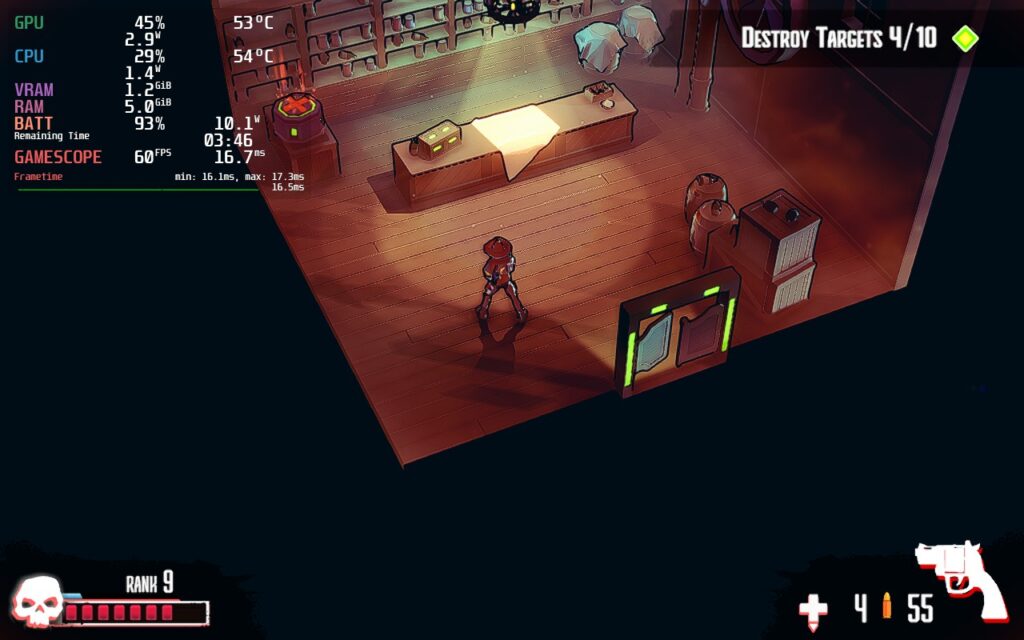
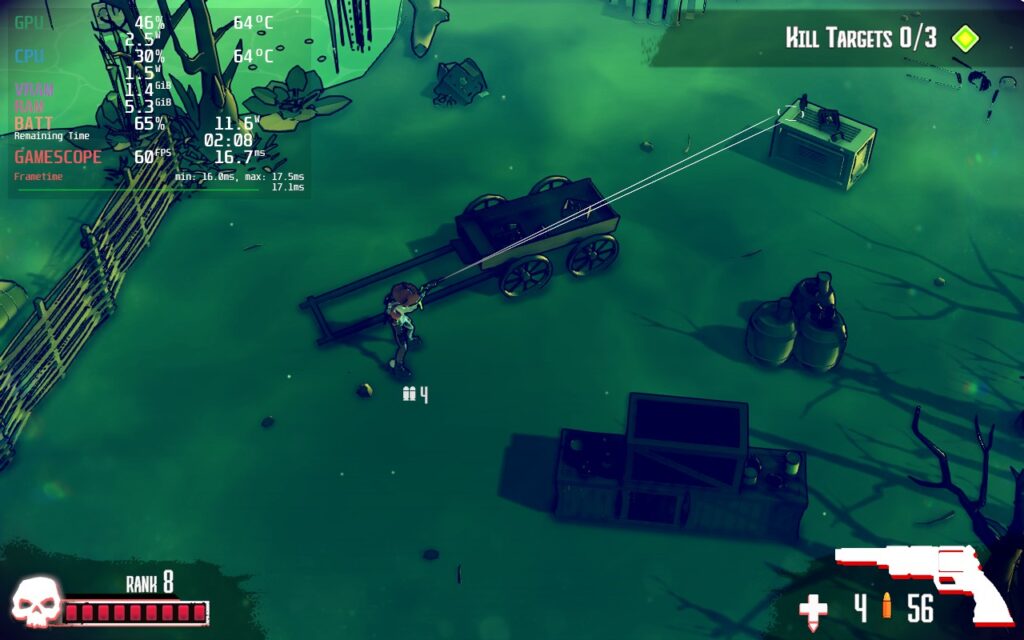
Other than that, I had no controller issues or visual bugs. The game also displays at a full 1280x800 resolution and has cloud saves!
Dust & Neon is an incredible top-down shooter that shines with its gorgeous visuals and addicting gameplay. The game can get really intense in fights and feels quite rewarding when getting a new weapon that starts killing enemies in 3 hits instead of 4 or an overpowered shotgun that one-taps some enemies. Switching from actively shooting robots to rolling for cover to reload, then rushing around the corner and emptying the revolver's ammo into a group of bots feels fantastic. And while our recommended settings change the graphics quality, the game can be fully enjoyed and played without changing anything, making this our newest Best on Deck game! As one of my favorite Next Fest games, this is one I highly recommend adding to your Steam Deck library.
If you enjoyed this review, be sure to check out the rest of the content on SteamDeckHQ! We have a wide variety game reviews and news that are sure to help your gaming experience. Whether you're looking for news, tips and tutorials, game settings and reviews, or just want to stay up-to-date on the latest trends, we've got your back
Prodeus was provided to us by Humble Games to review. Thank you!
Are you a fan of Boomer Shooters like DUSK and Doom Eternal? Then this is the game for you. Prodeus is a modernized first-person shooter with a gorgeous retro feel to it. Plow through a campaign hand-crafted by industry veterans alone or in co-op, or compete against your friends in deathmatch modes. You can also partake in campaigns and maps made by the community using the fully integrated level editor in-game. Now, make it through the chaos and take down the Prodeans and all the forces of chaos against you.
As someone who adores boomer shooters on the Steam Deck, I was super excited to check out Prodeus. After my time with it, I can easily say it's one of my favorites. The visual style is fantastic, the gunplay feels tight, the guns themselves are varied and I can feel the weight to them, and the inclusion of the level editor and community map browser brings endless content to the game. I also love the inclusion of co-op campaigns and maps, as well as the dismemberment system that highlights the gory bloodbath you create. And on the Steam Deck, some tweaking is involved to really enjoy it, but it is definitely playable.
Before I go into Prodeus's performance, I want to explain my testing here. While I did play the campaign, I decided to test and optimize settings using a community map and test the settings from there on the campaign. This map is heavier than a lot of the areas featured in-game, so optimizing for the more intensive map would mean all less and more heavy would be covered, including other community maps (theoretically). The map I used to optimize initially is called "Bruteforce" by PALPUS.
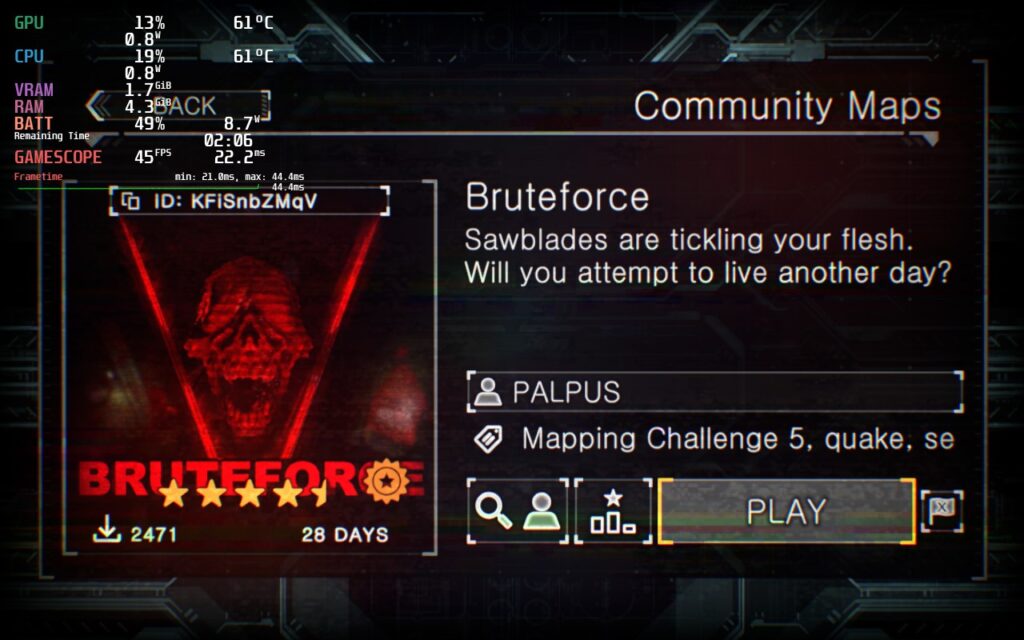
Prodeus is a weird game to run and had some oddities when it came to optimizing. Before I get into that though, I did test the game at max settings. In some smaller campaign areas, the game was able to run at 60 FPS with a high battery drain of 20W+, but other areas and the community map would churn out sub 37 FPS at a 24W battery drain. I knew this wouldn't be feasible to play like this, so I got started in my optimization process.
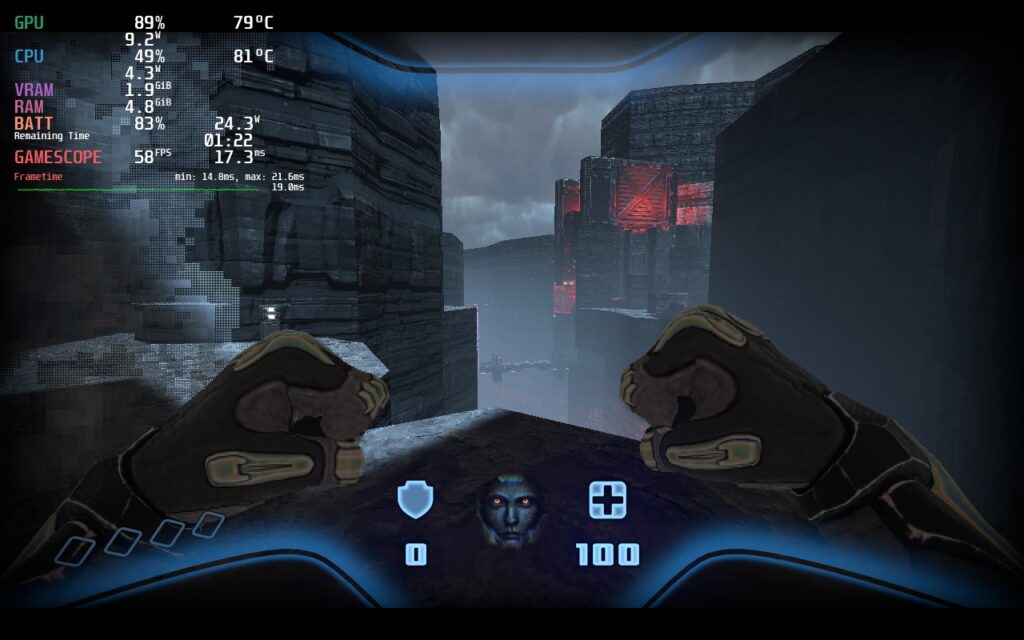
The first thing I looked at was shadows, which were definitely the biggest cause of framerate drops. But oddly enough, most areas didn't show any visual difference. The shadow quality focuses more on non-static shadows as it doesn't effect ones that are created by the environment. The one part that I found a big difference was in the community map where the visual quality did change, but it was so minuscule on the overall effect on the quality.
Other than the shadows, I noticed SSAO and SSR did make a difference, but didn't impact the game visually much. This meant keeping those turned off kept the quality of the game looking similar while saving on battery and performance. I also noticed turning resolution down helped with stabilizing framerate, but didn't really impact visual quality either.
After testing all the settings, I came up with 3 builds that I felt all worked quite well. I prioritized framerate with each one, so each will feel as smooth as possible. My recommended build focuses on battery life, but pushes framerate to a good compromise of 45 FPS while still looking great! It gets around 3 hours of battery and feels a nice step up from 40,
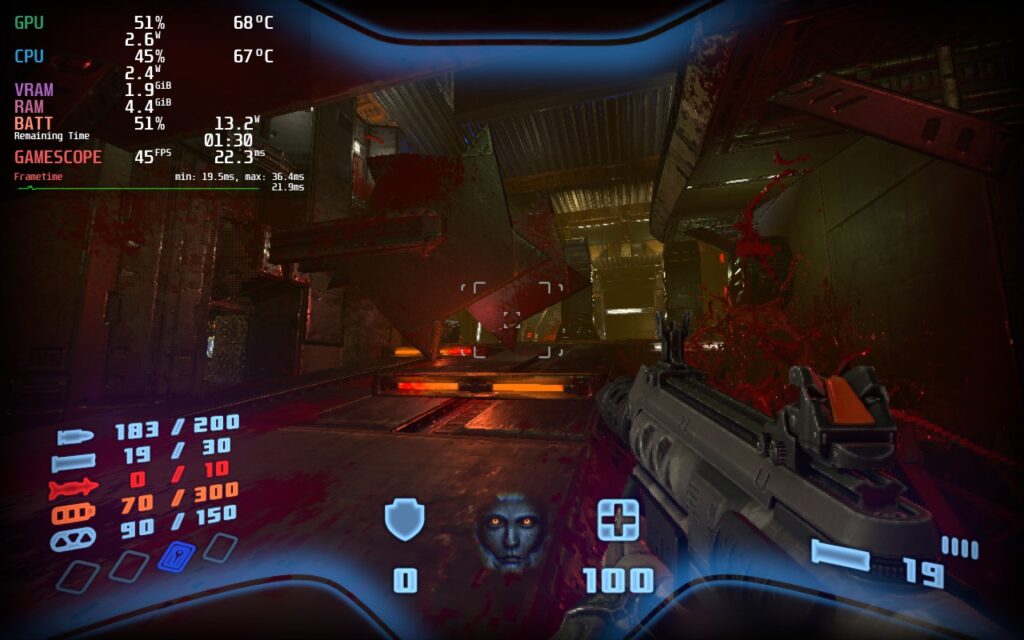
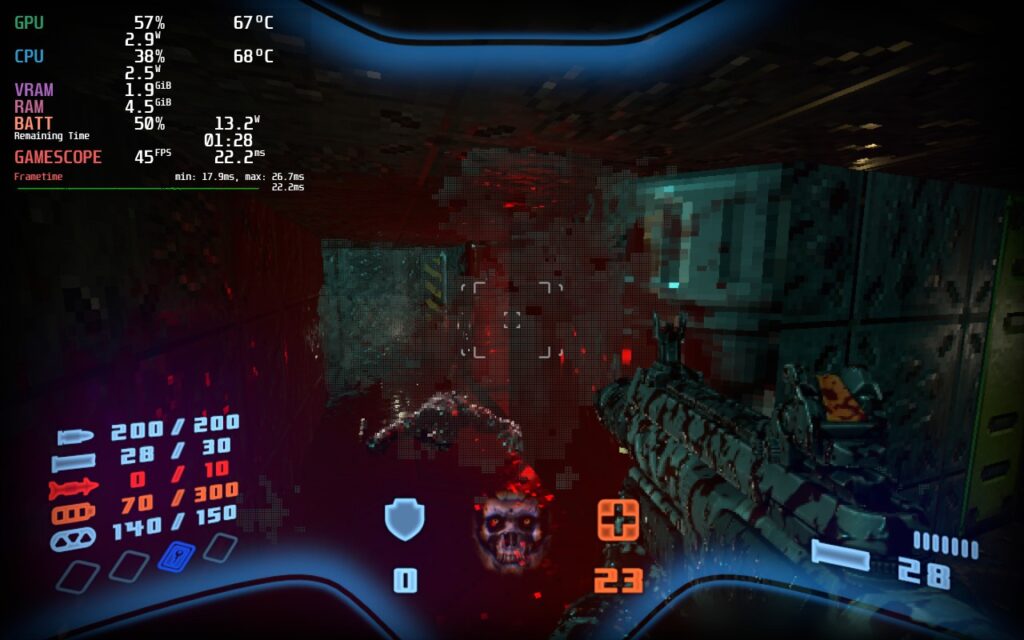
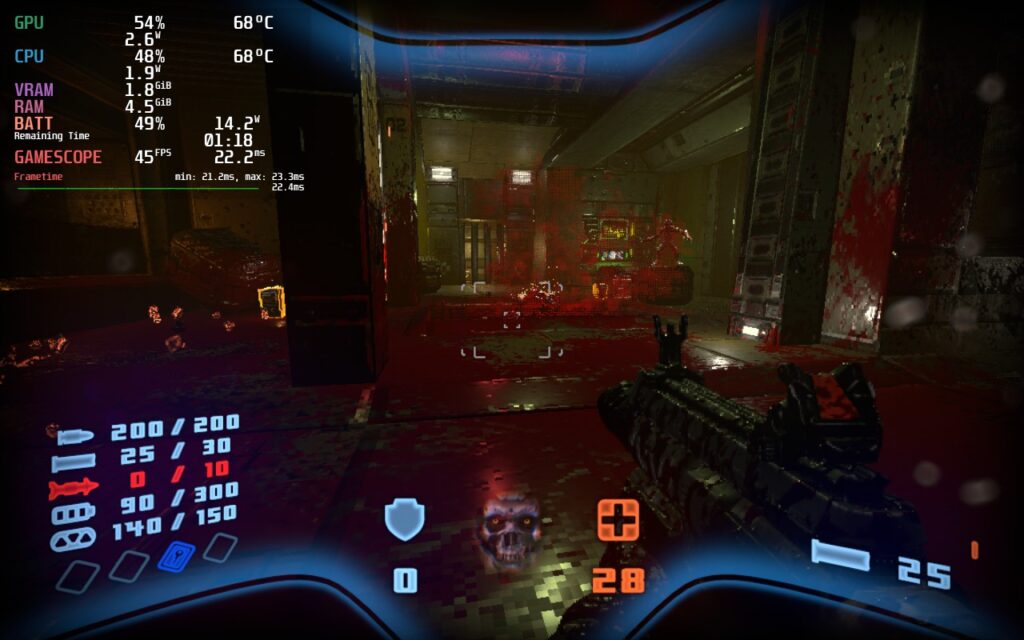
From there, I decided to push framerate as much as possible while keeping things stable. Since there was still some drops when moving through levels at 60, I decided to stick to 55 FPS to keep things smooth and make any possible drops feel non-existent. The battery life tends to stick around 2.5 hours for this one.
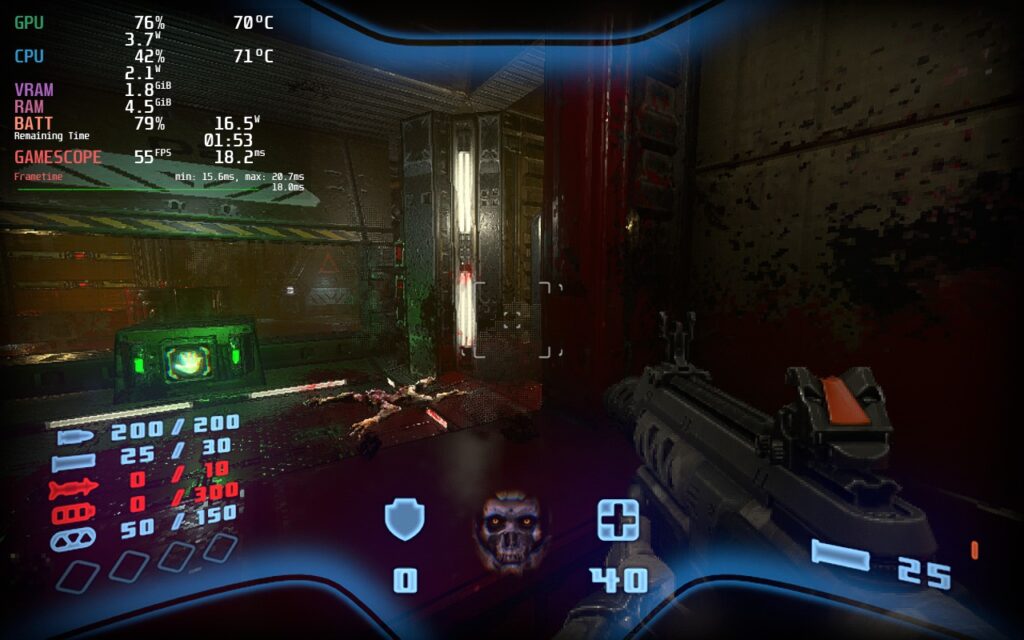
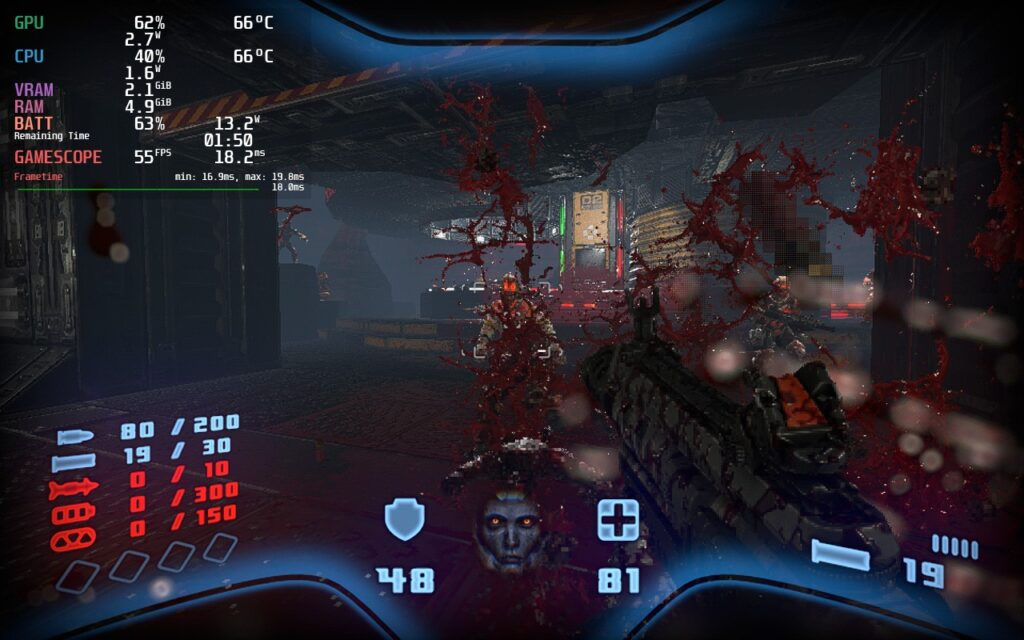
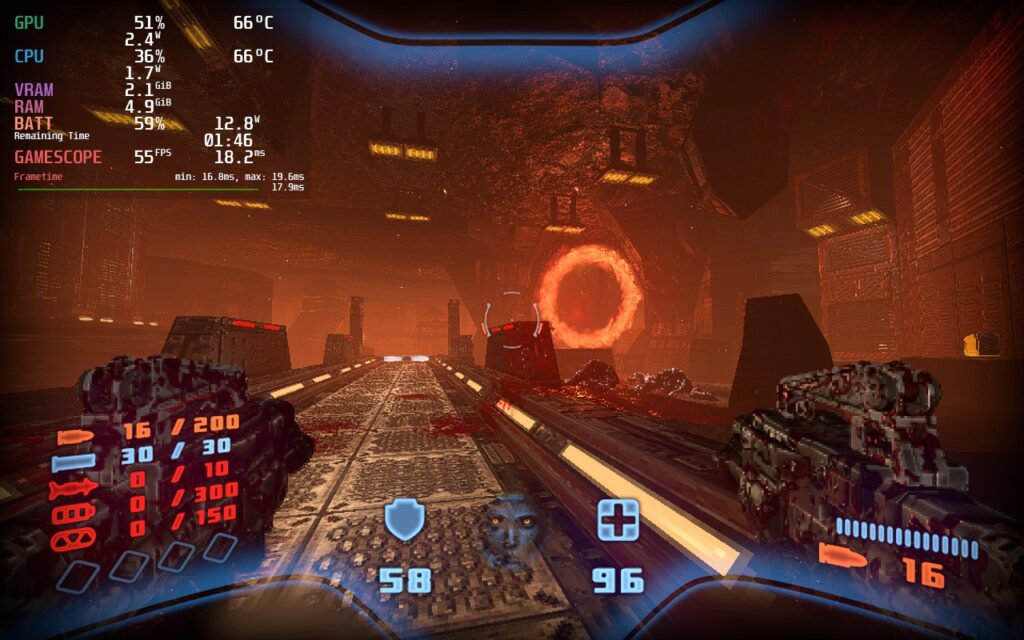
Then, I wanted to find the best way to play the game at max quality, including shadows turned on. I noticed that with most framerates, there would still be some drops and spikes in battery. The lowest I could get without drops or crazy spikes in battery is 40 FPS, which still feels fantastic.
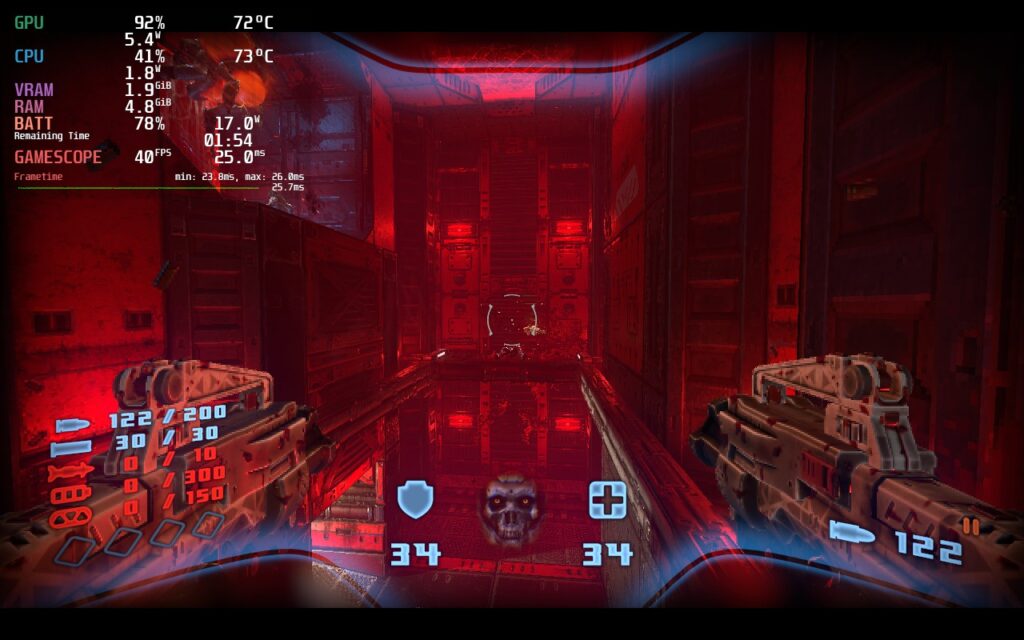
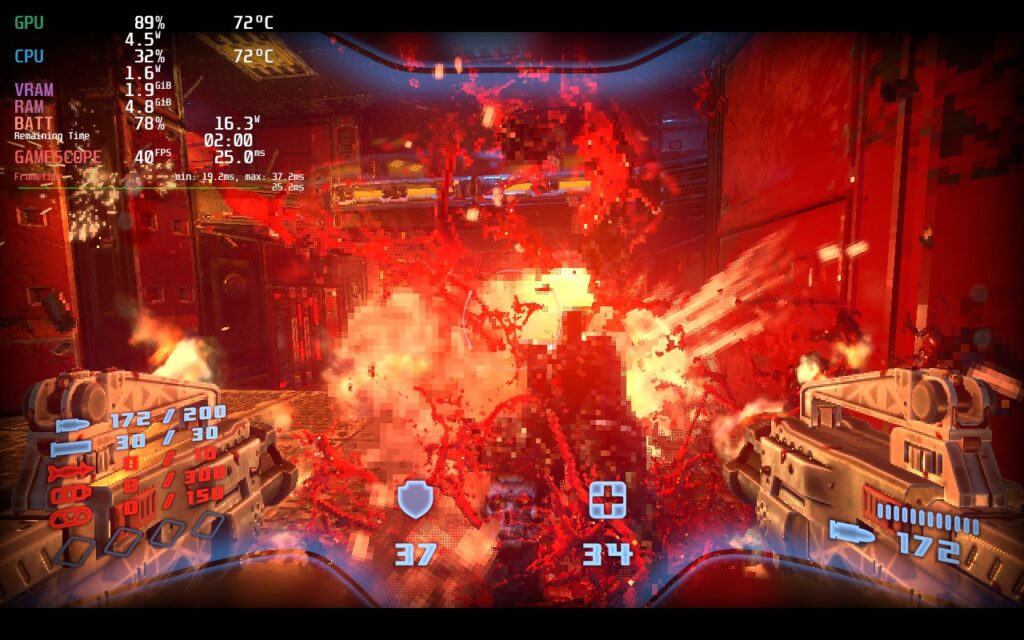
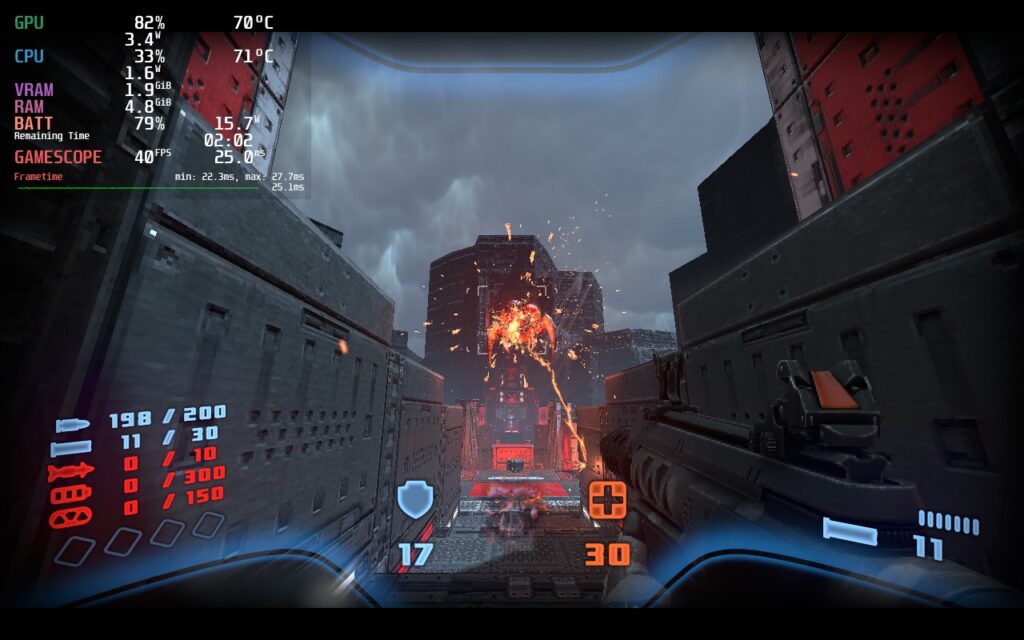
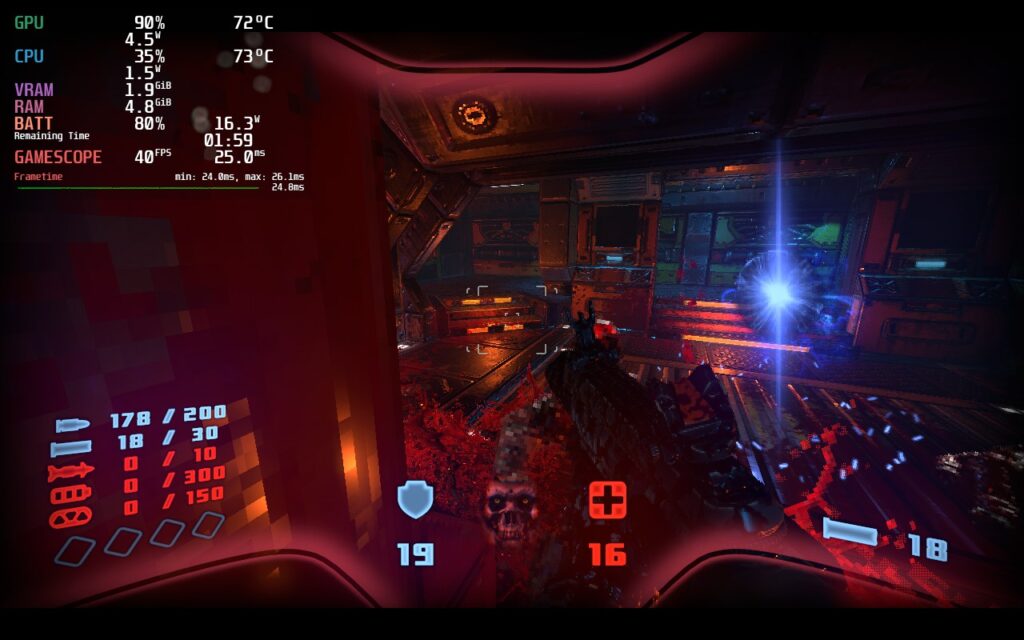
Each of these ways to play work extremely well, can't go wrong with any, but 45 with a battery focus felt like a good compromise between good quality and a smoother framerate.
With boomer-shooters like Prodeus, gyro aiming can be a godsend. This helps with some finite adjustments to make sure you can hit those headshots. Unfortunately, Prodeus doesn't have mixed input support. Gyro can be enabled to emulate a joystick, but it doesn't feel as fast/responsive as it could. So while it is possible to have gyro, it doesn't feel like it should.
Even with the oddities and the lack of mixed input support, Prodeus is an incredible shooter that shines on the Steam Deck. The graphical style is gorgeous, the gameplay is fast-paced and tight, and the community maps/campaigns keep the content coming! And all of this can be thoroughly enjoyed on the Deck.
Our review is based on the PC version of this game.
If you enjoyed this review, be sure to check out the rest of the content on SteamDeckHQ! We have a wide variety game reviews and news that are sure to help your gaming experience. Whether you're looking for news, tips and tutorials, game settings and reviews, or just want to stay up-to-date on the latest trends, we've got your back
The Worms franchise is a blast from the past, reminding me of gaming on the PS1. It had a resurgence during my college days, where it could make or break friendships, and again has made its way into the games I currently play. These quirky worms, armed to the teeth, debut with some tongue in cheek humor, randomly generated maps, and both online and local multiplayer. Worms W.M.D. is listed as Unsupported on Steam, but worked perfectly fine out of the box, with no additional configuration needed.
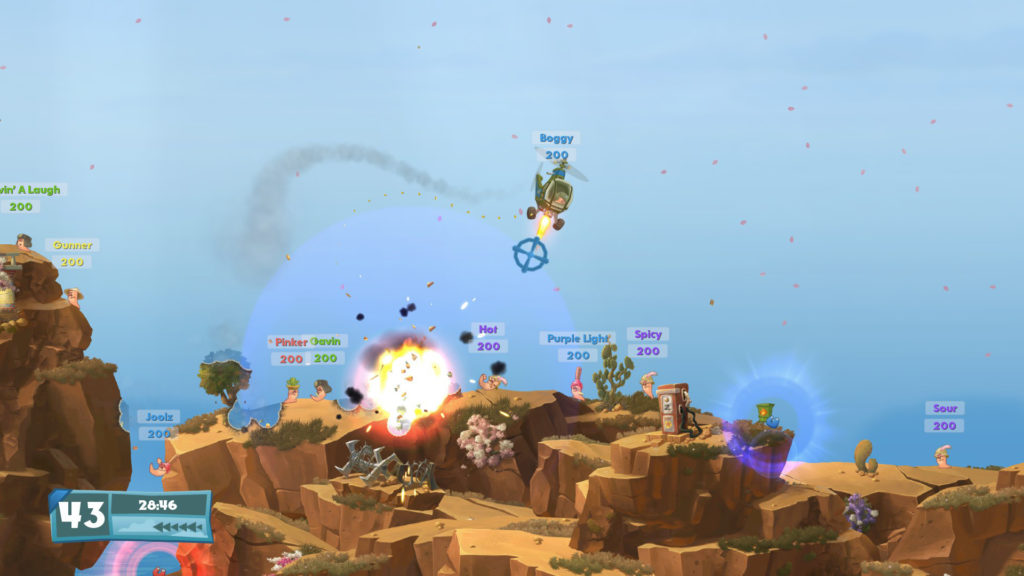
Online multiplayer works flawlessly and supports Steam invitations, so it's simple to gather up to three other friends in a lobby. Local multiplayer is also supported, which I tested with both Bluetooth and wired controllers. Local multiplayer using Steam Link opens up some unique possibilities, like playing against friends or family from an entirely different room.
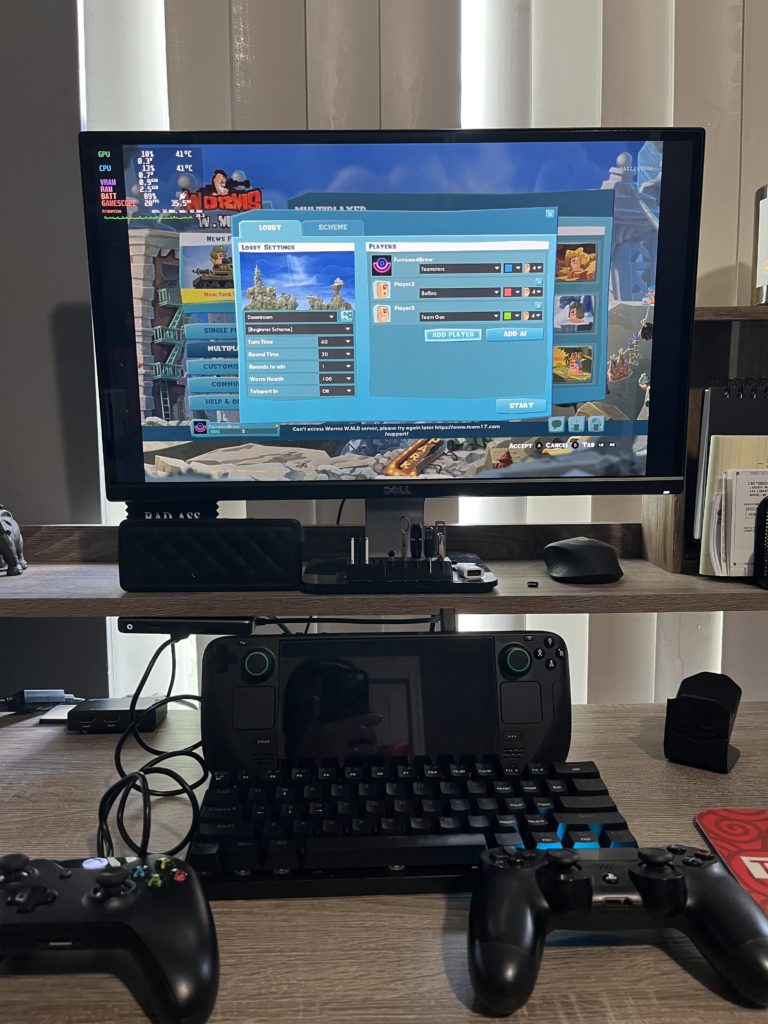
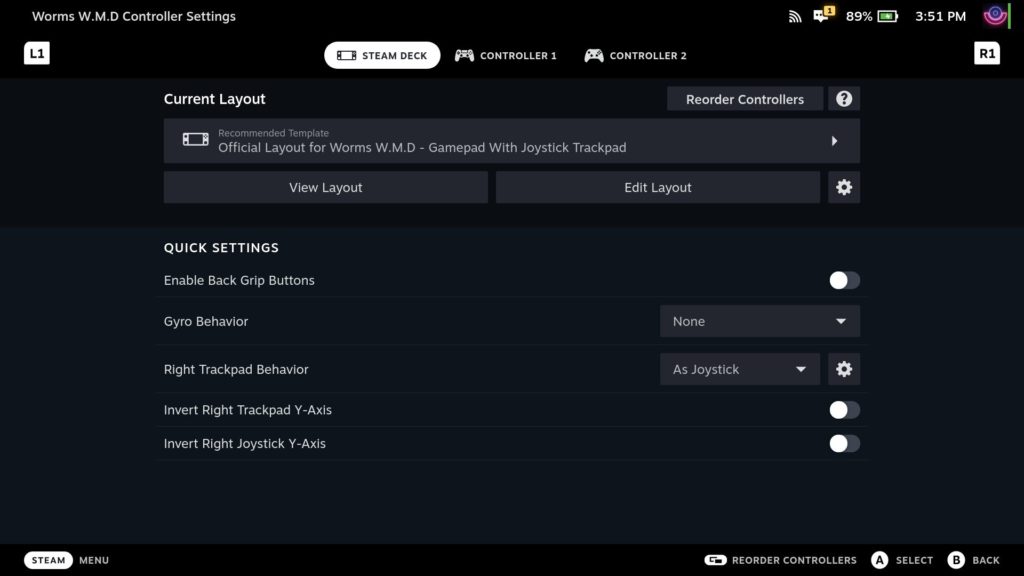
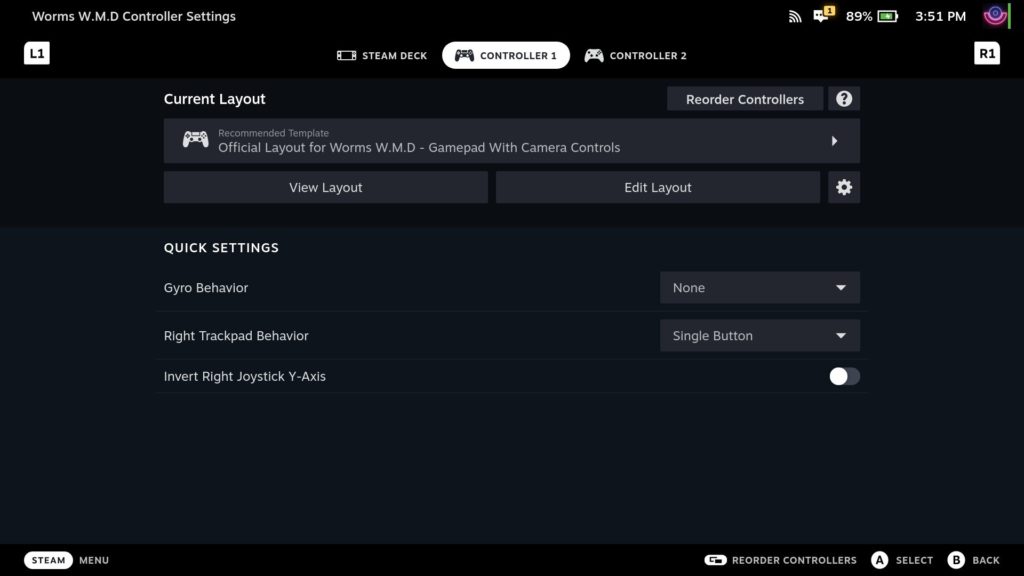
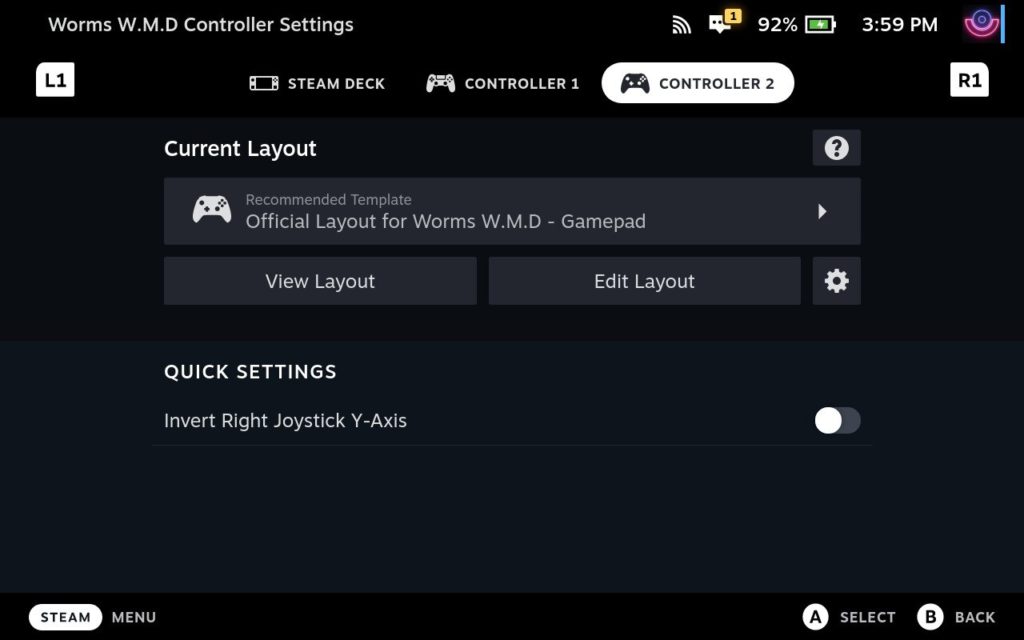
Better yet, Worms W.M.D. supports a “pass the controller” style of multiplayer. When each player is added to a match, they are instructed to Press A on the controller they will be using. That way, everyone can have their own controller, you can use the Deck while friends share a controller, or you can pass the Deck around the room. If playing local multiplayer, make sure each controller appears in the Deck’s controller settings prior to opening the game.
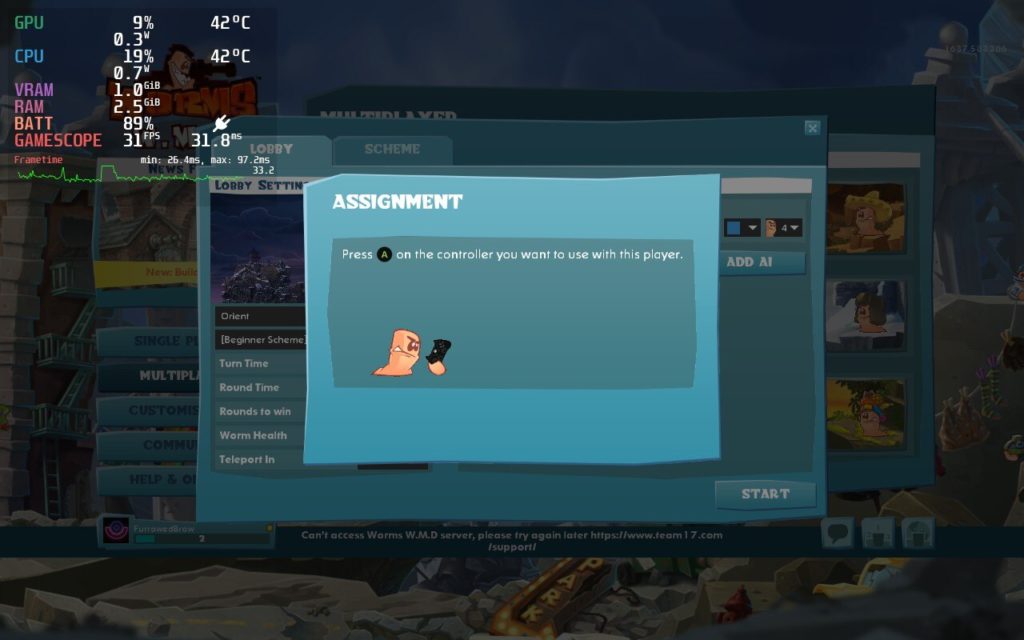
The simple, yet vibrant graphics are not demanding of the Steam Deck’s hardware, supporting 60fps in native 1280x800 resolution. With default settings, I was able to get about 4 hours of gaming out of the Deck, with peak temperatures never reaching 65 degrees. By limiting the TDP to 4 watts and setting the GPU clock speed to 600, FPS dipped to the 35-40 range, which is perfectly playable for this type of turn based game, but extended the battery life to a whopping 6 hours with peak temperatures around 50 degrees.
Since framerate was stable around 35FPS, I dropped the refresh rate and FPS down to 40 and gained another 30 minutes of battery life. I noticed that if I dropped the GPU clock below 600, framerate became unstable, dipping into the low to mid 20fps range.
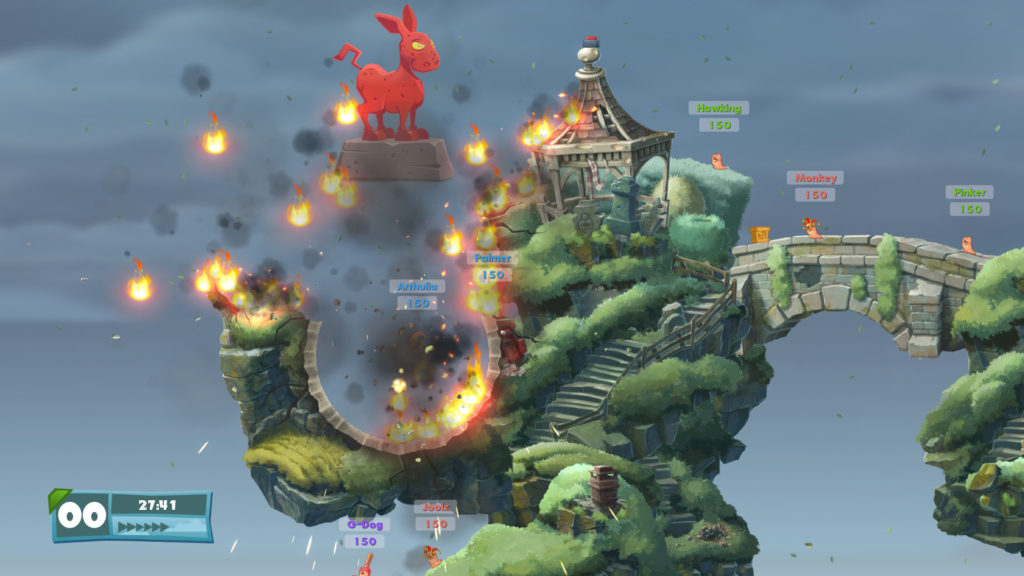
Worms W.M.D. can be fun for hours on end, creating some funny moments and rivalries along the way. While Valve lists it as unsupported, we know, in many cases, that just means it hasn’t been tested. I was happy to take the plunge and pleased at how well it runs natively.
Happy gaming!
Our review is based on the PC version of this game.
If you enjoyed this review, be sure to check out the rest of the content on SteamDeckHQ! We have a wide variety game reviews and news that are sure to help your gaming experience. Whether you're looking for news, tips and tutorials, game settings and reviews, or just want to stay up-to-date on the latest trends, we've got your back!
Update 9/13/22: After speaking with the developer behind the Hephaistos mod, and after reading, they have clarified and rewrote the instructions on how to get the mod working. We included a small guide on how to get it working so you can utilize a full 1280x800 resolution.
Hades is...well for lack of any other term...an incredible game. As the son of Hades himself, you have decided to defy your destiny and escape hell. Using an assortment of powers and weapons, you will hack and slash your way across gorgeous landscapes while upgrading your skills and powers. As this is a roguelike game, each death makes you more powerful with new weapons to unlock and permanent upgrades that carry with you throughout your deaths. Paired with an immersive fully voice-acted story, this roguelike game is an essential to everyone's library. And it just so happens that Hades is also an essential game for your Steam Deck.
Due to the art style, Hades is nowhere near intensive in the slightest. When opening the game for the first time, it will boot up at a solid 60 FPS with only 12W battery drain and sub 70c temps. If you ask me, this is pretty fantastic, though we can make it better! The game tends to drain a bit extra power than it really needs, so by just setting a TDP limit to 4 and GPU Clock Speed Frequency to 1100, we can dramatically lower the drain to 8.5W - 9W with sub 60c temps.
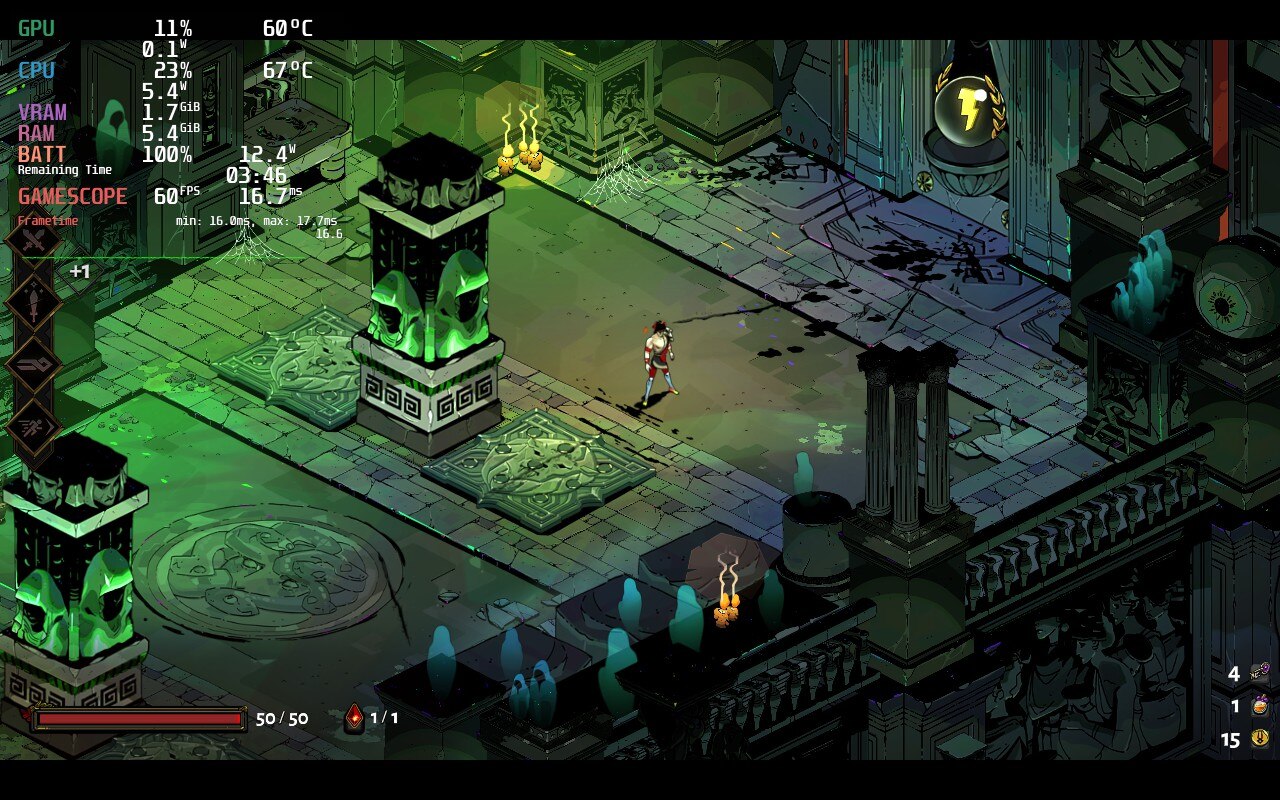
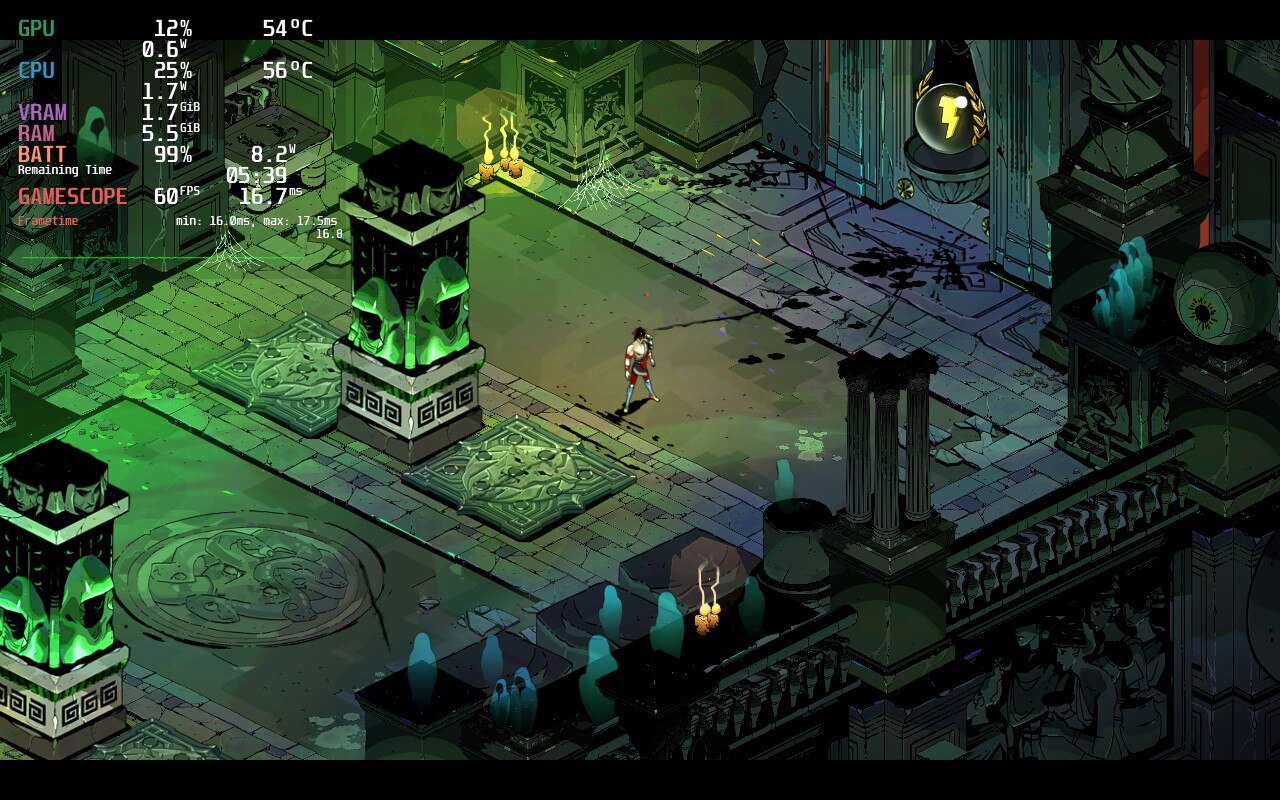
With no visual or stability difference, you can clearly see the temps and battery drain go down significantly with slight TDP changes.
This tends to bring the battery life up to 5.5 - 6 hours from 3.5 - 4 hours with no sacrifices to performance at all. This is especially helpful if you are going to be traveling, but even just playing at home, this can help significantly. Keeping temps down will increase the longevity of your Deck's hardware as it won't be getting so hot. And honestly, with a small tweak like that and no reduction in quality or performance, there really is no reason NOT to.
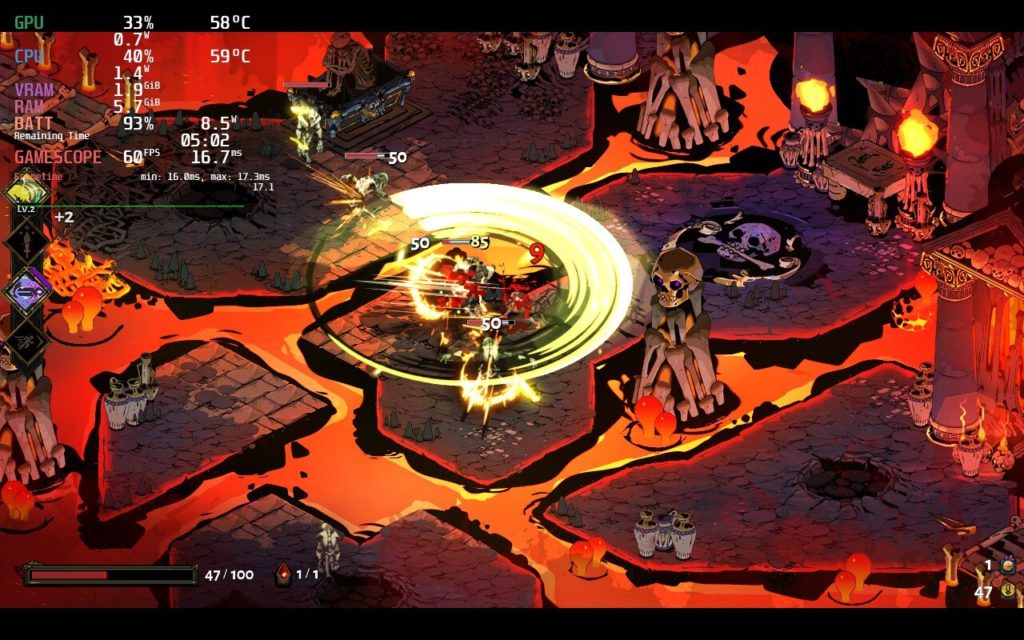
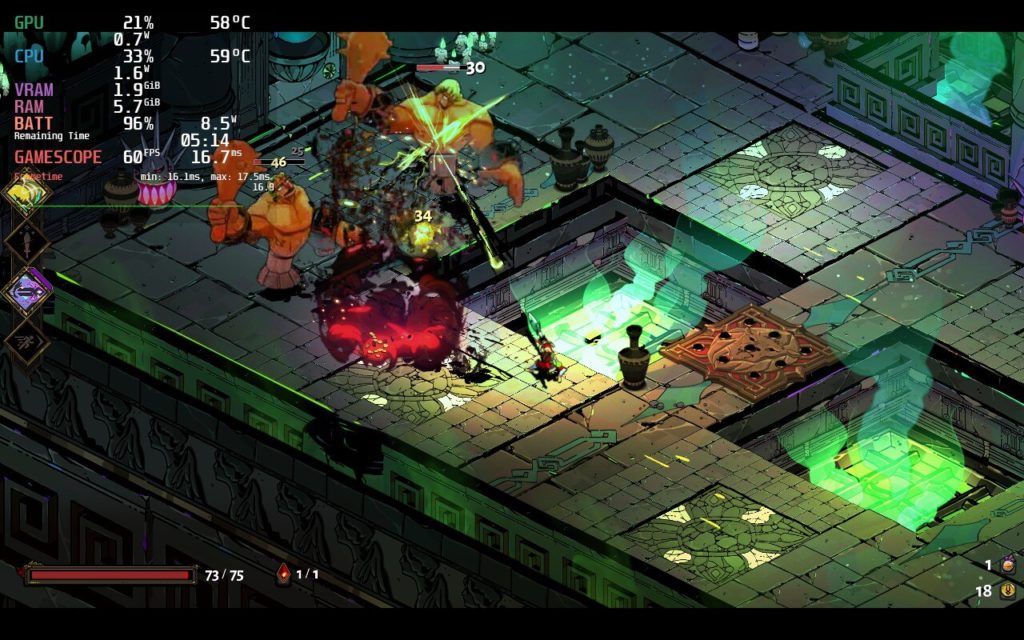
Now if I had to point out one thing, it is the resolution options. In-game, it says it supports 1280x800, but it actually only displays 1280x720 as you can see from the black bars at the top and bottom in the screenshots. While there is a way to patch this using the Hephaistos patch, it doesn't really feel necessary. The game runs and looks beautiful and I felt no reason to change the resolution. I did try to use the mod itself, but the file wouldn't execute so I couldn't patch the game. I will continue trying though and update this review if necessary.
After speaking with the developers behind the Hephaistos mod, we got it up and running. To do this, you will have to download the hephaistos-linux.zip from the release page. Then, extract the file and put it in the directory of where Hades is installed (you can access it by going to properties > local files > "Browse Local Files". Once the file is placed in the directory, right click it and select "Run in Konsole". Then, press "1" 3 times, which will patch the game to the 1280x800 native resolution on the Deck! We noticed no performance difference with the native res.
There really isn't much more I can say about Hades other than it is one of the best games I have ever played. The artwork, gameplay loop, the fine-tuning, they all work together in such harmony that it is hard to look back and not love it. Supergiant Games outdid themselves and it makes me incredibly happy to know how amazing this game works on Deck. If you haven't yet, buy this game.
Thank you for reading! If this settings review helped you, please consider supporting SDHQ by donating on Patreon. Your support will help us continue to grow and provide the latest and best Steam Deck content!
Our review is based on the PC version of this game.
If you enjoyed this review, be sure to check out the rest of the content on SteamDeckHQ! We have a wide variety game reviews and news that are sure to help your gaming experience. Whether you're looking for news, tips and tutorials, game settings and reviews, or just want to stay up-to-date on the latest trends, we've got your back!